We were very excited in anticipation of our trip to South America to see the Nazca Lines, Machu Picchu, and the Galapagos Islands. Unfortunately, two weeks before our departure, Pat fell and broke her shoulder bone. We attempted to cancel the trip but without insurance, nobody would hear of it. Surgery was done within a week and the surgeon told Pat there was no medical reason not to make the trip. So with two physical therapy sessions and detailed instructions, we were off on our adventure.
Wednesday, January 27, 2016
Our flight for Lima, Peru left at 11:00 am with a connection in Houston. We arrived in Lima after midnight and had elected to stay at a hotel at the airport. We arrived two days ahead of our scheduled tour to give us time to get acclimated.
Thursday, January 28, 2016
We toured the historic city center in downtown Lima. The beautiful former government buildings were unoccupied but at least partially restored.
First there is a picture I took in 1972 when I visited Lima for the military.
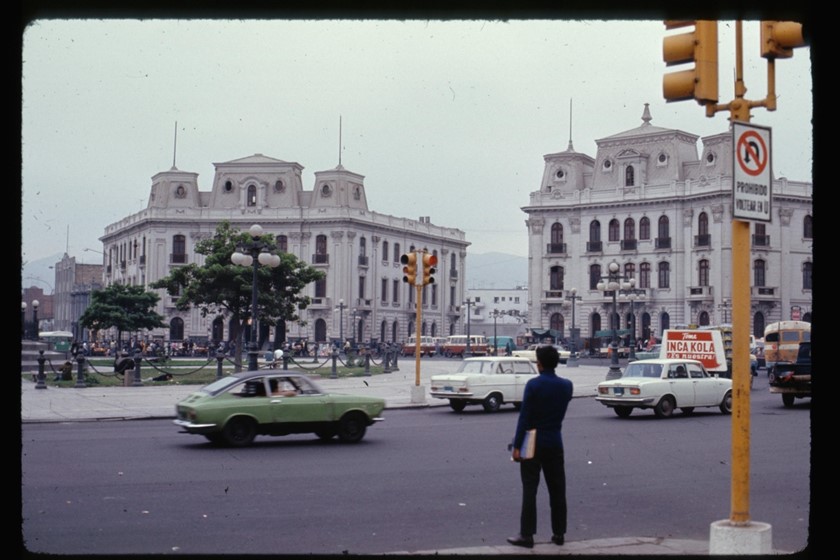
…and this is how the same buildings look today.
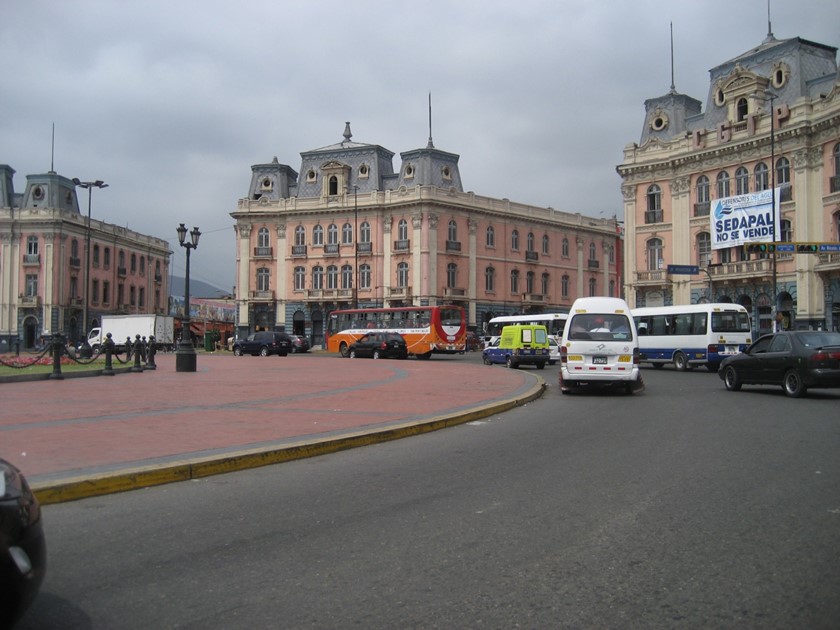
The Presidential Palace is beautiful and very well maintained.
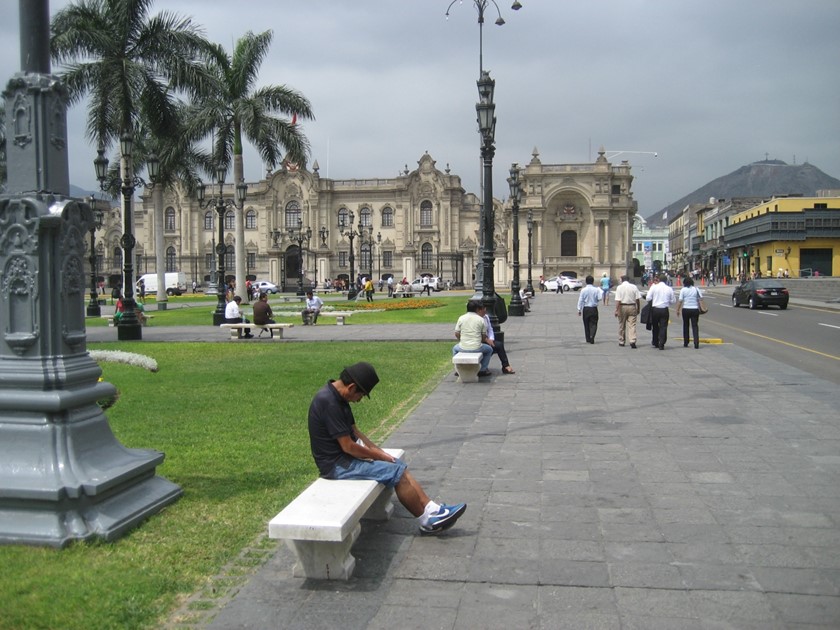
A large crowd had formed to watch these street performers.
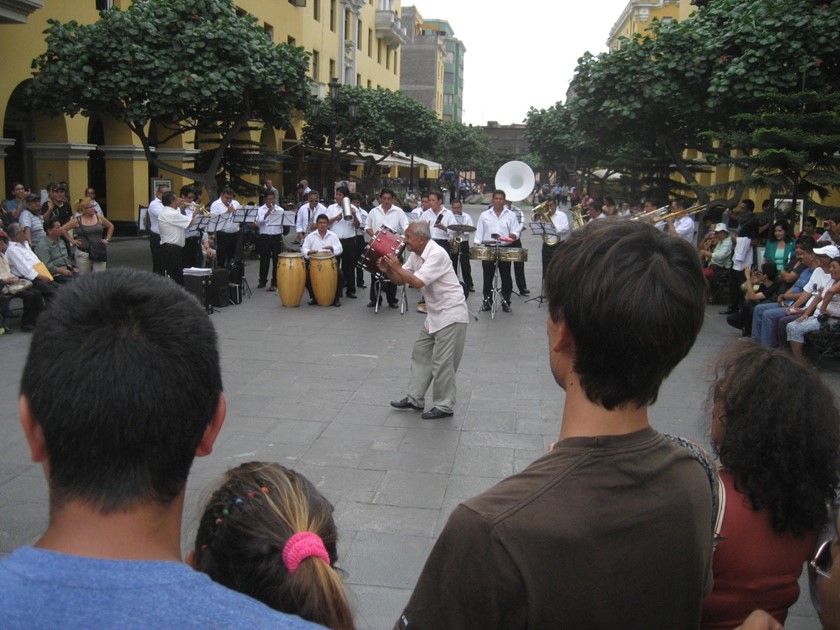
Most of the time Pat let her surgically repaired arm swing free to keep the blood circulating. She wore her sling when we were in crowded places to give herself some protection and space.
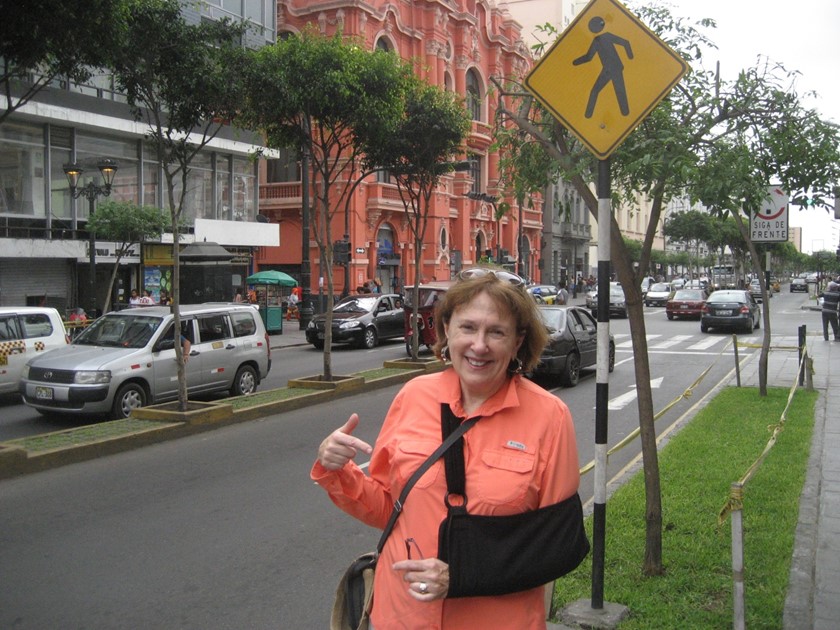
We had arranged for a taxi to pick us up at the end of our day. We finished a little early so we found a place to sit and enjoy a beer while waiting.
Friday, January 29, 2016
After a leisurely breakfast, we hopped in another taxi and went to visit the Rafael Largo Herrera Museum in Lima.
This museum was founded in 1926 by Rafael Larco Hoyle. With the help of his father he managed to acquire several archaeological collections from Peru’s northern coast, bringing together some 45,000 pieces. As he organized the pieces he realized that many of them could not be attributed to the cultures which had been discovered to date.
In the 1920’s, he began his own research and excavated at a number of archaeological sites on Peru’s northern coast. This research led to his discovery of cultures such as Cupisnique, Salinar, Viru and Lambayeque. He became the discoverer of the Moche culture.
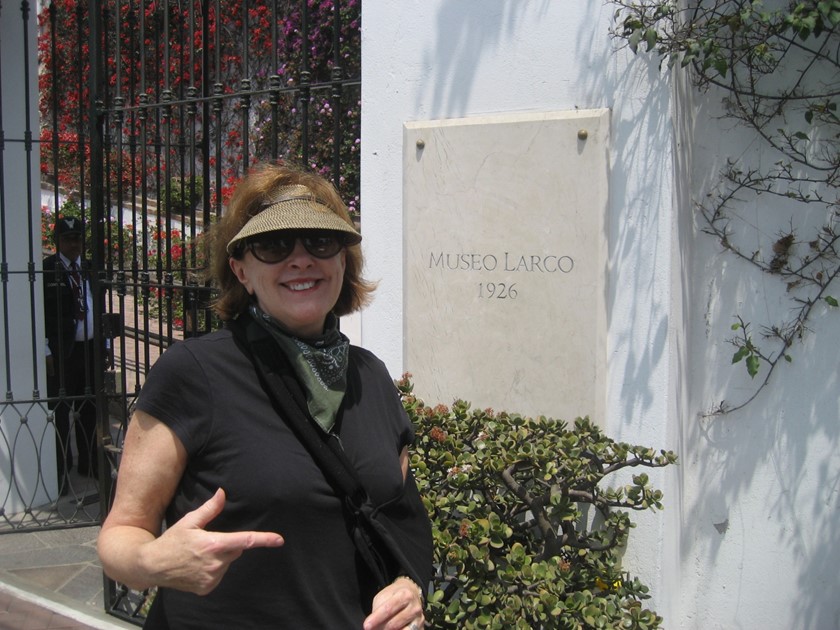
This museum had beautiful plants growing everywhere.
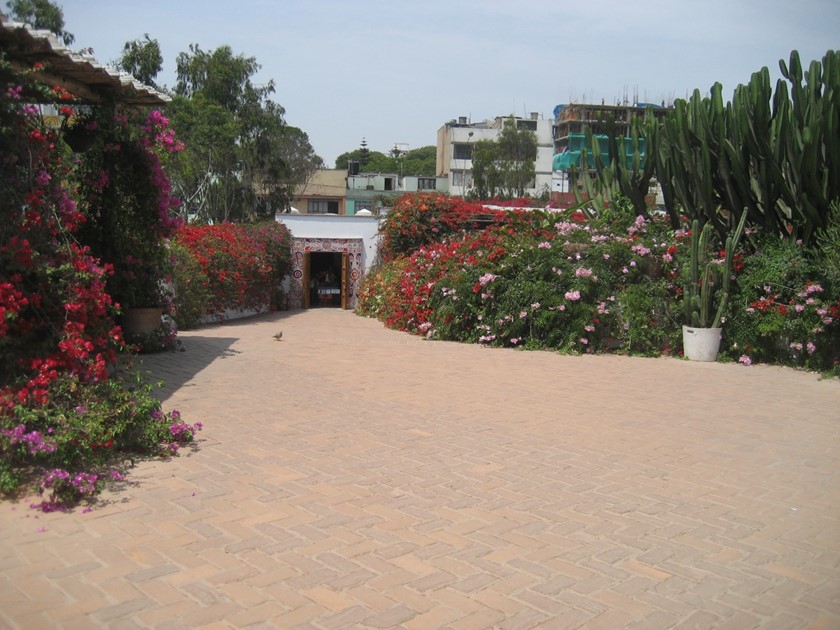
Inside were relics of the many cultures Largo had unearthed. There was also a room off to the side where thousands of artifacts were stored that hadn’t yet been cataloged.
There was a very nice restaurant for lunch on the lower level.
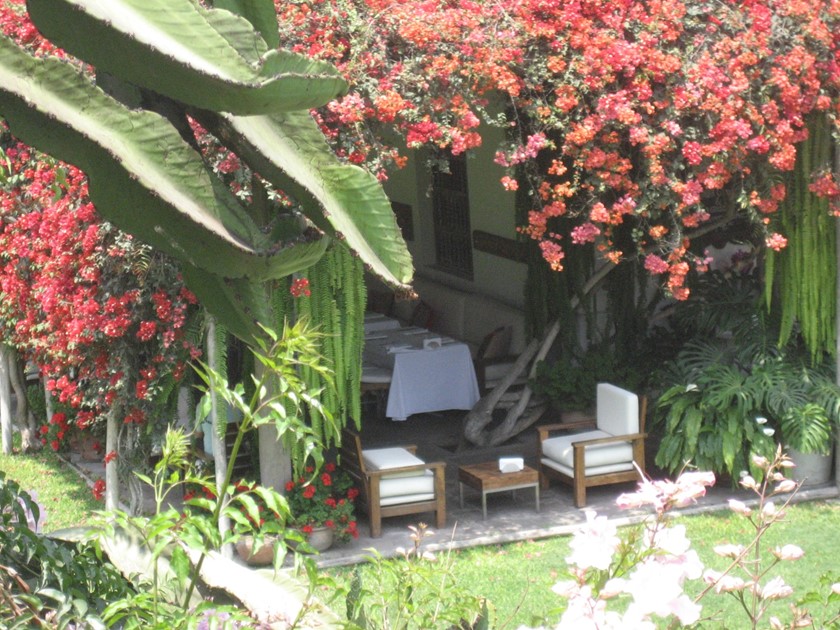
We stopped here for a beer.
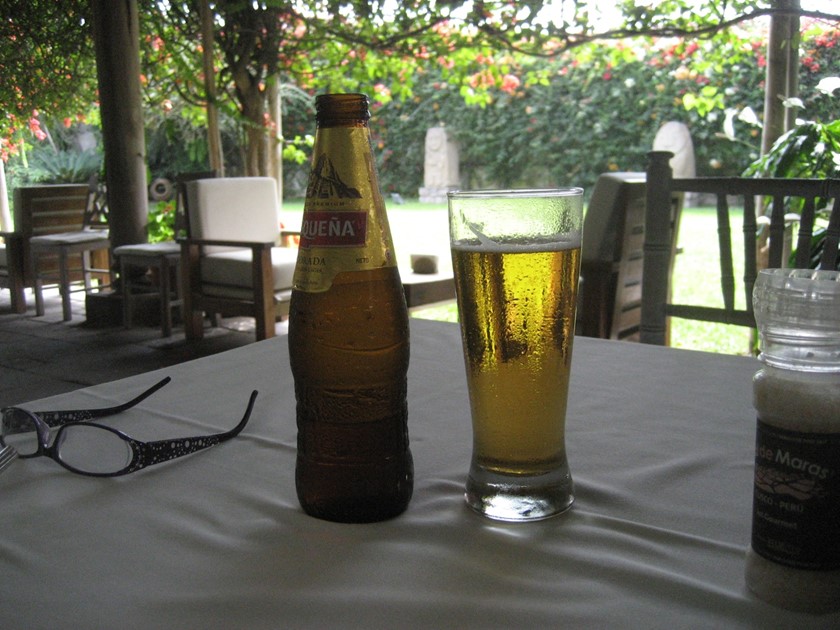
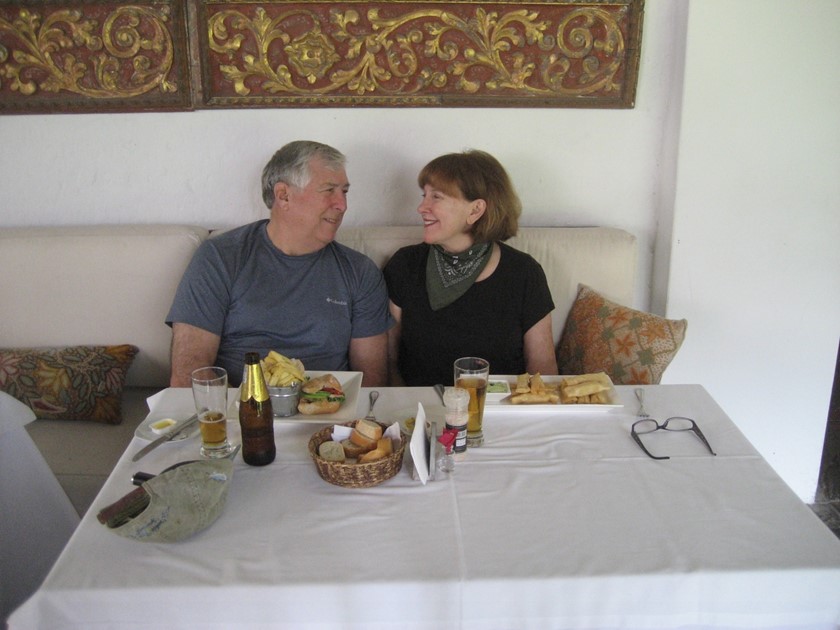
A separate part of the museum held various artifacts of erotica that had been unearthed. Clearly erotica in its many forms and positions has been around long before we got here.
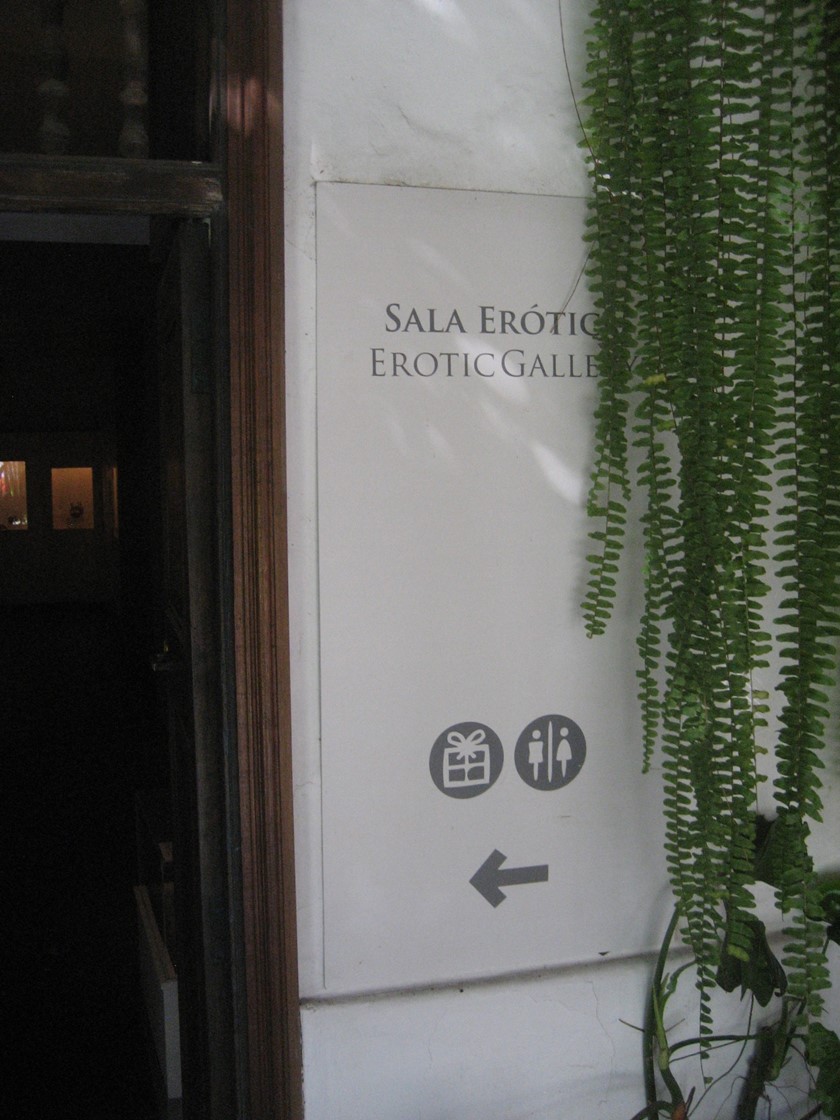
This exhibition presents a selection of archaeological artifacts from pre-Columbian art.
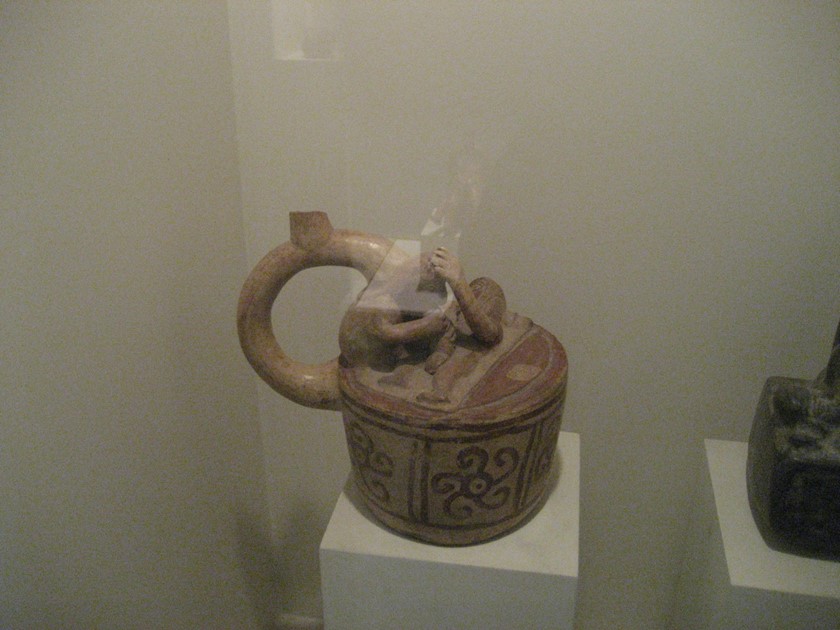
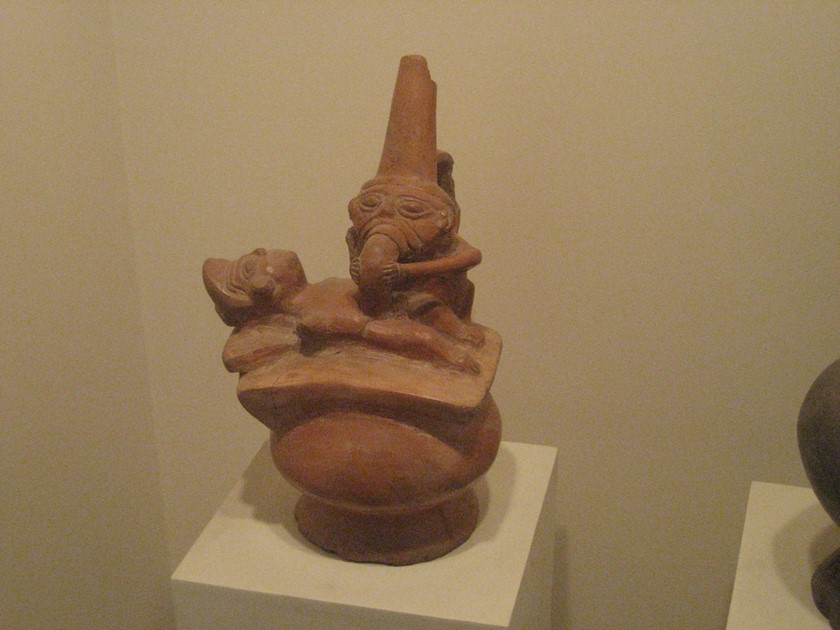
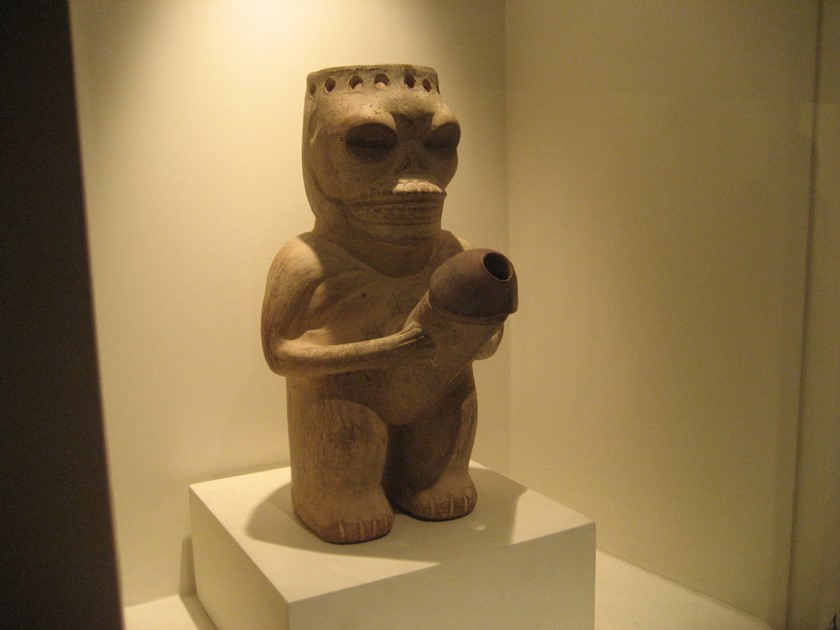
Thus, we ended this two day adventure on our own. We were to meet our tour representative at 0530 EST the next morning and we had to be packed and ready to go.
Saturday, January 30, 2016
The first part of our official tour was to take a bus to Paracas and board a small airplane to fly over the Nazca Lines in the Peruvian desert.
We were to meet our guide and our fellow travelers in the lobby at 0530 EST. (that was 0430 CST where we live) But, as usual, we were up and packed and had completed breakfast by 0530. (As a former flight attendant Pat has told me that if you weren’t on time, your office left without you)
We were expecting a tour group and a guide but at 0530 we were the only people in the lobby. We wondered, ‘Were we in the wrong hotel?’ Did we have the wrong time? The hotel staff were clueless about “Alexander and Roberts”. Just as we were dialing the emergency contact number, the representative showed up. We were the only ones from this hotel going to Paracas and the bus had gone to the wrong hotel. No problem. She got us a taxi and we went to the bus station.
It was a 4 hour bus ride before we checked into La Hacienda Hotel Paracas. After a nice lunch…
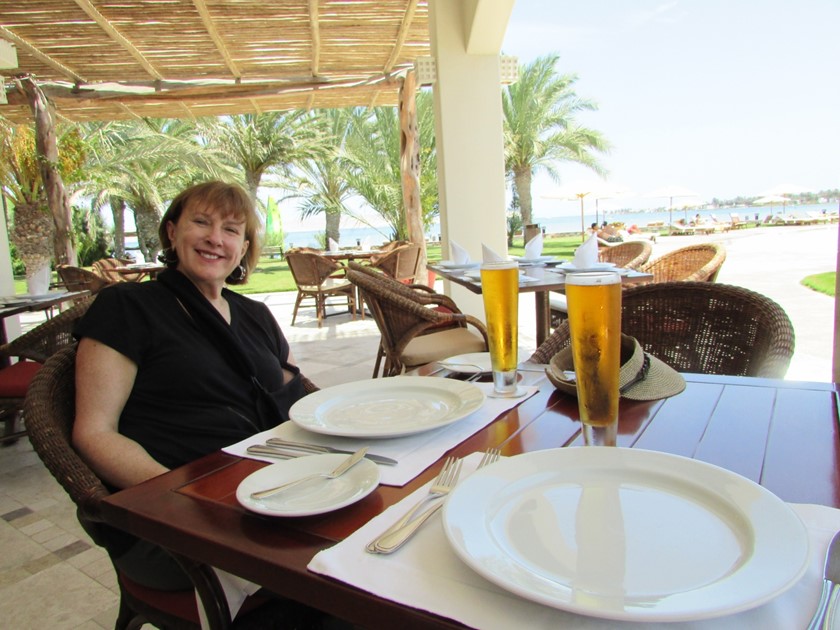
… we got back on the bus to go to the Paracas Airport.
This was a nice airport and they were just completing a new control tower. We later learned there was commercial service to the airport and we could have avoided the 4 hour bus ride. (6 hours for the return, btw)
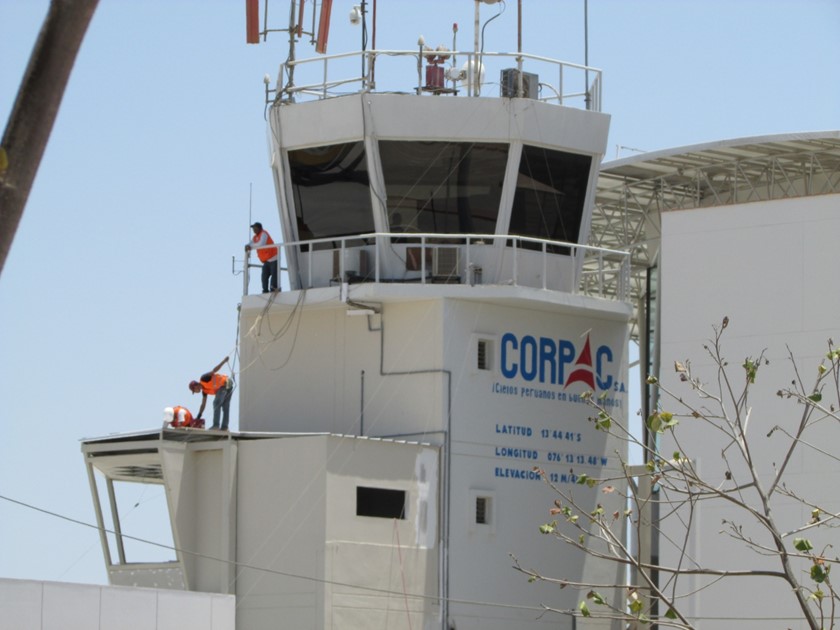
Here was my ticket for the 12 passenger Cessna Caravan.
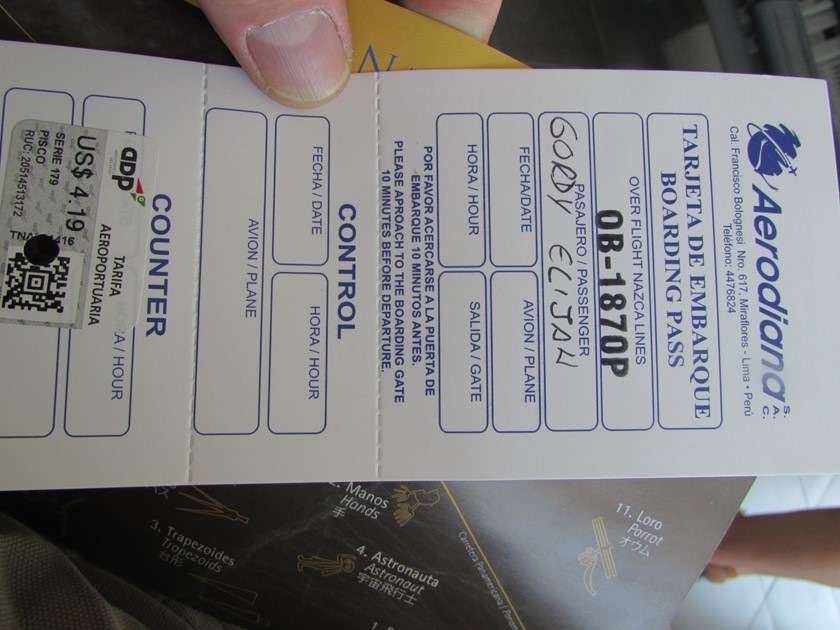
And here we are ready to board.
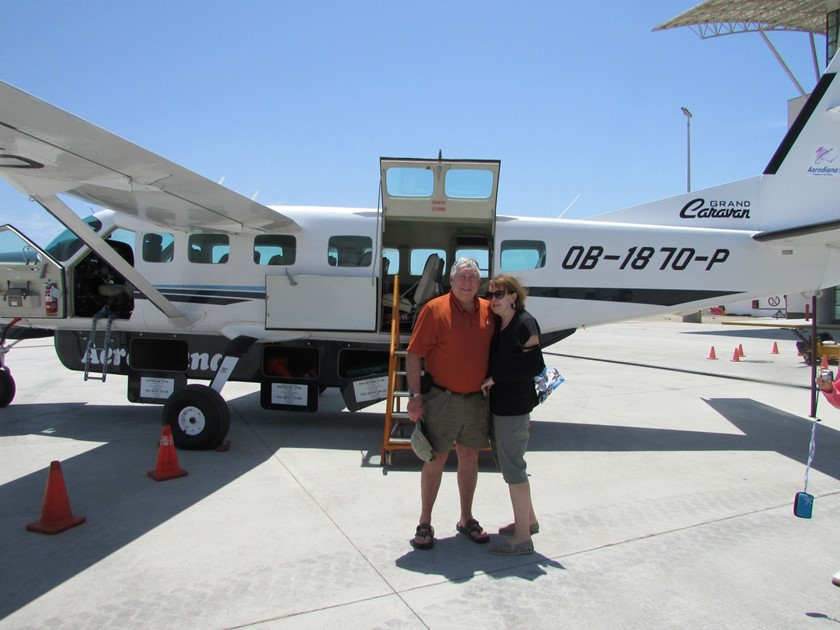
The flight takes about an hour and a half and the first 30 minutes are over NOTHING but Peruvian desert. This is comparable to the Sahara.
Finally we began to see some of the geometric shapes on the desert floor. While there a many theories, no one really knows who put these there. …and they don’t move and they don’t get covered. I rains less than an inch per year.
The Nasca Lines are found in the Peruvian desert, about 200 miles southeast of Lima, near the town of Nasca. In total, there are over 800 straight lines, 300 geometric shapes, and 70 animal and plant designs. They estimate their creation between 200 BC and 600 AD.
Pebbles which cover the surface of the desert contain ferrous oxide. The exposure of centuries has given them a dark patina. When the gravel is removed they contrast with the lighter color underneath. These strips define the lines, many in perfect geometric shapes — triangles, trapezoids, etc. Some swirl into shapes that resemble hummingbirds, spiders and monkeys.
Below is the card they give visitors to help them identify the various shapes as they fly over them. A few were obvious, but some were hard to pick out.
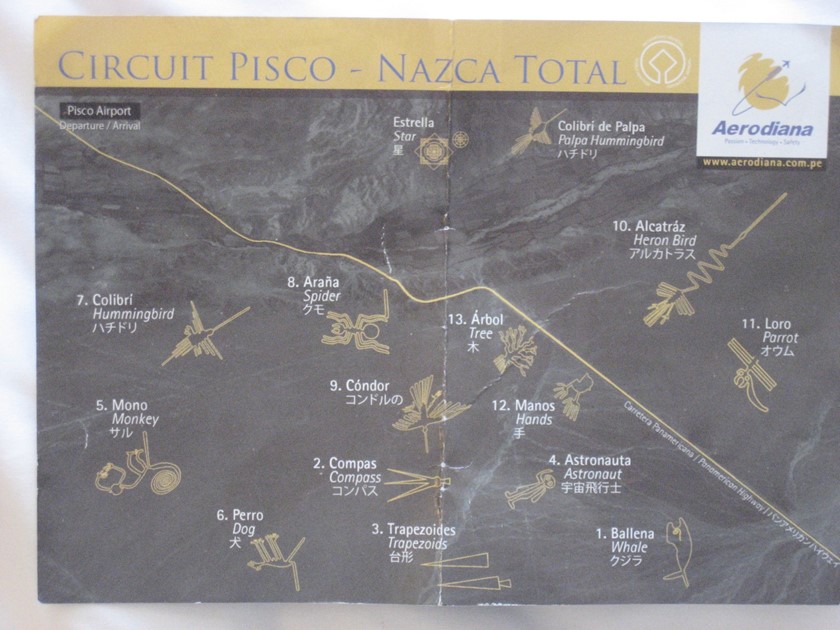
Some of the straight lines run for 30 miles while some of the animals are over 1,200 feet (as large as the Empire State building).
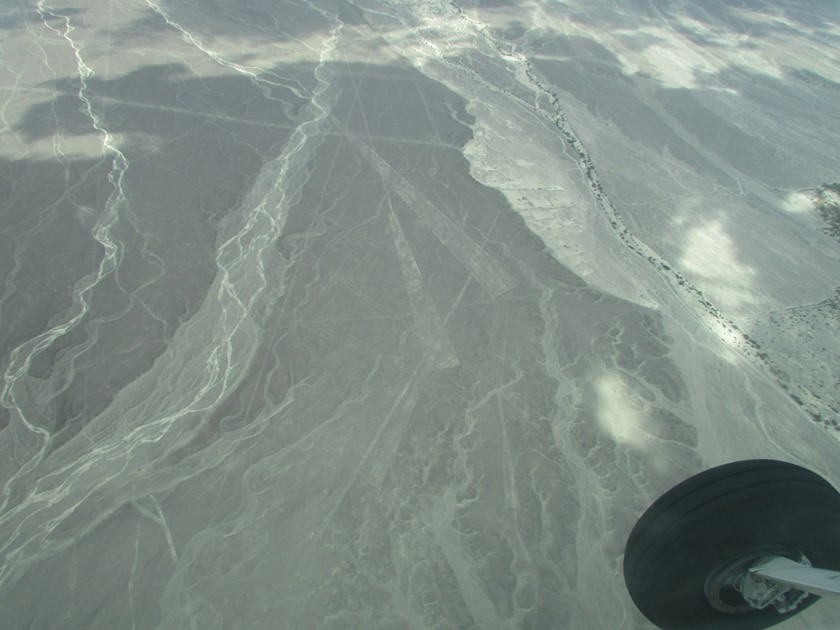
Below is the “Monkey”
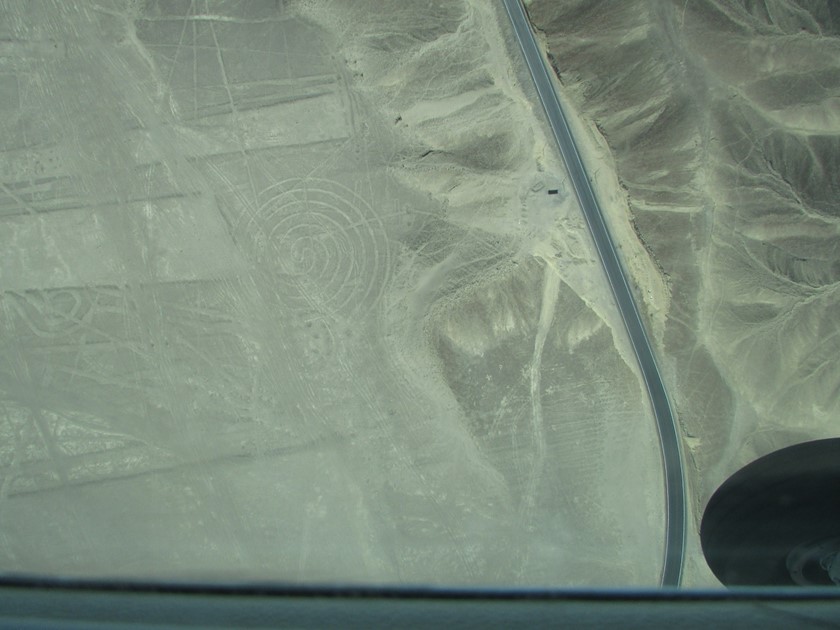
…and the “Spider”.
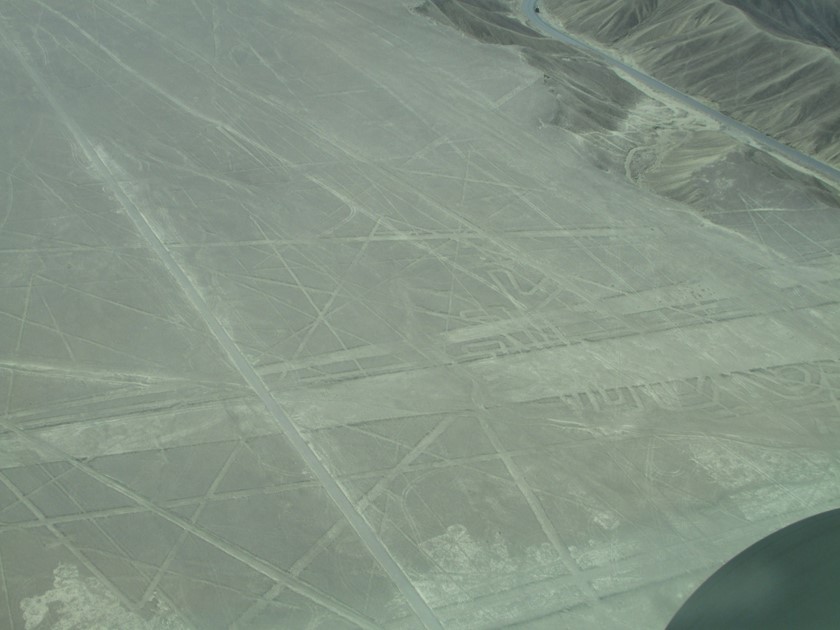
In order to see these shapes from the aircraft, the pilot would roll into a 45 degree bank first to the left and then to the right. Some of the passengers were clearly not comfortable with this but no one got physically sick.
Considerable research has so far not explained the purpose of these lines and shapes. At one time or another, they have been explained as Inca roads, irrigation plans, images to be appreciated from primitive hot-air balloons, and landing strips for alien spacecraft.
Almost all of these iconic animal figures, such as the spider and the hummingbird, were single-line drawings; a person could step into them at one point and exit at another without ever crossing a line, suggesting to archaeologists that at some point in early Nasca times the lines evolved from mere images to pathways for ceremonial processions. Later, possibly in response to explosive population growth documented by the German-Peruvian team, more people may have participated in these rituals, and the geoglyphs took on open, geometrical patterns, with some trapezoids stretching more than 2,000 feet.
In any case, they are amazing to look at and phenomenal accomplishments for local people before the advent of surveyors.
Following the plane ride, we returned to Paracus and to our hotel to enjoy dinner.
January 31, 2016
Following breakfast at La Hacienda, we boarded our bus for a brief ride to the docks where we boarded a small boat for the Ballestas Islands. This was Pat’s first challenge with getting on and off boats with her broken shoulder.
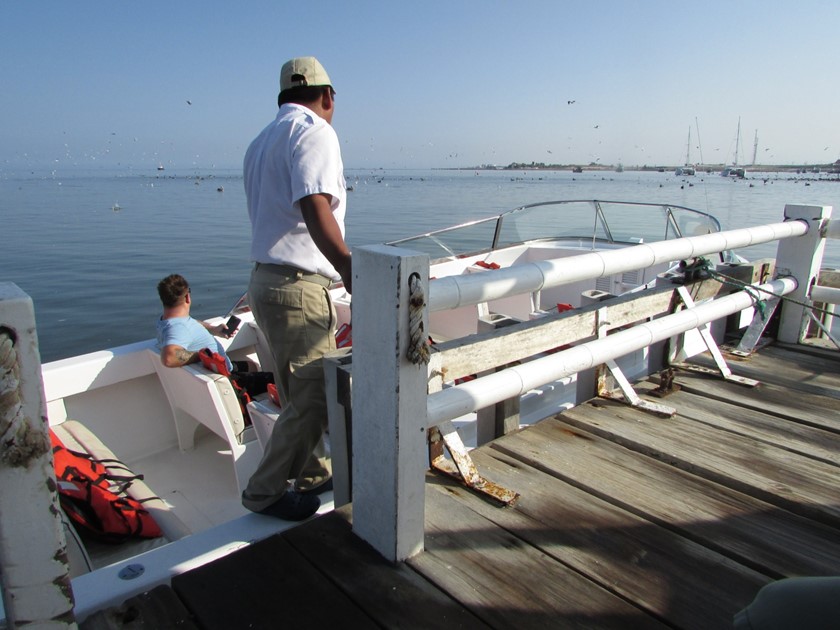
Following stern warnings to the crew, this was accomplished without incident.
Pelicans were everywhere.
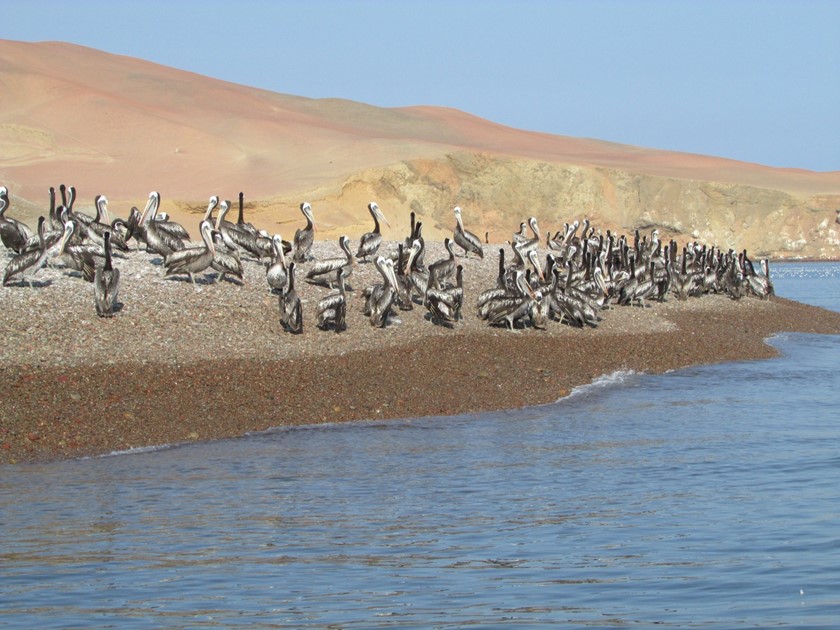
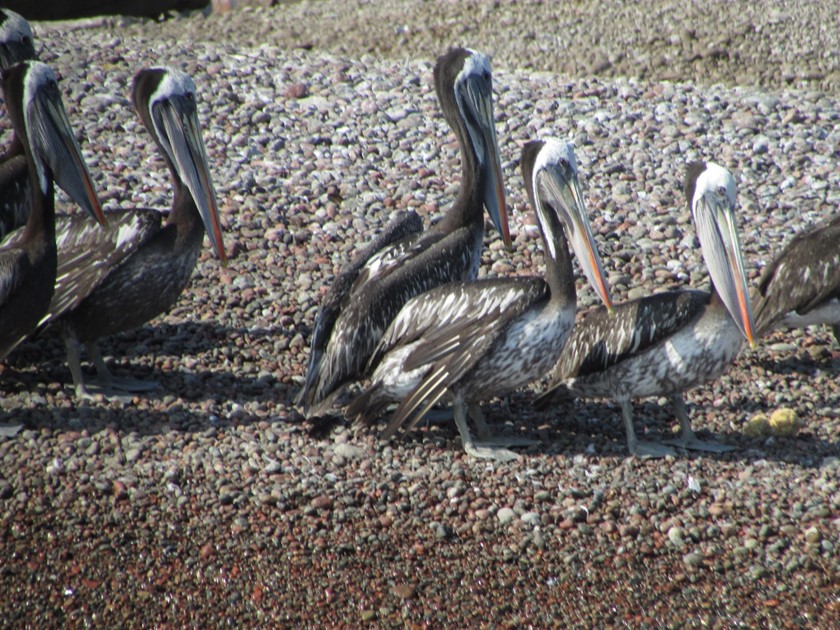
And there were more mysterious lines in the desert. These were named the “candelabra” .
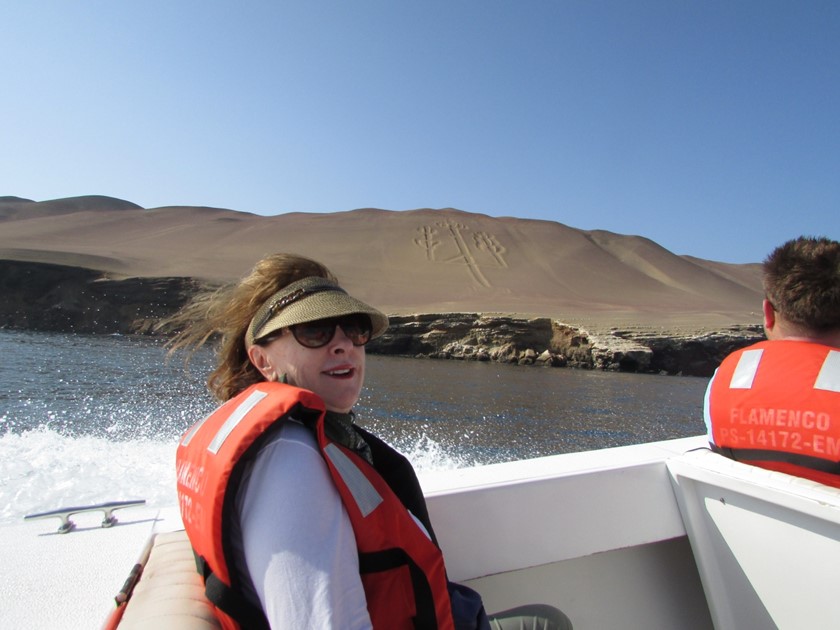
The Islands are very interesting lava formations, carved out by waves and currents over centuries.
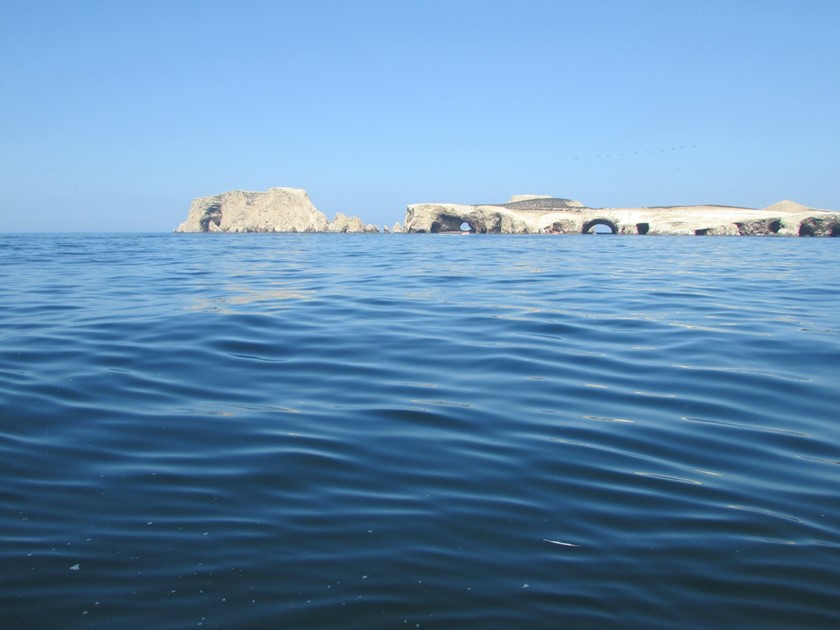
These Islands are home to some very interesting wildlife including many colonies of Sea Lions.
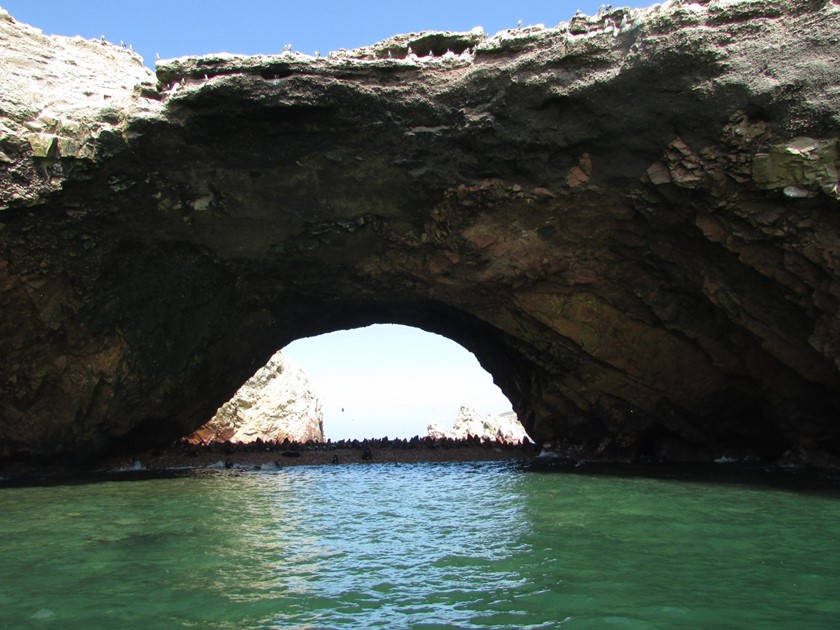
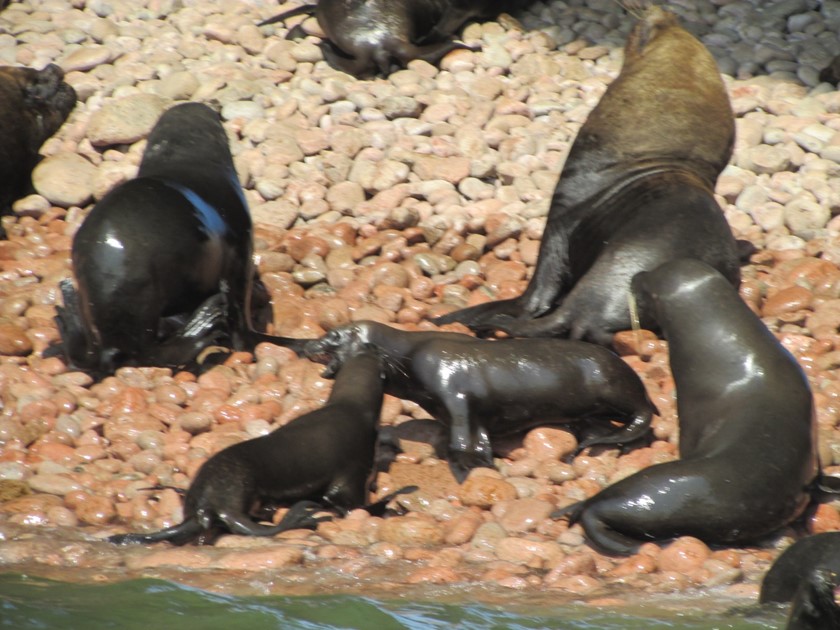
The hollow portions of the Islands were just beautiful.
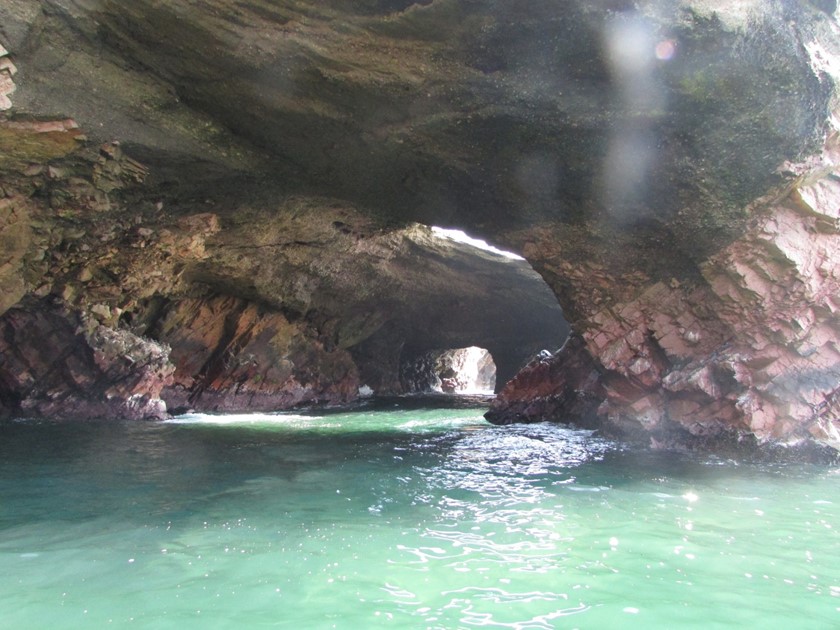
And there were Penguins. This was my first time seeing Penguins in native surroundings. They were there by the thousands.
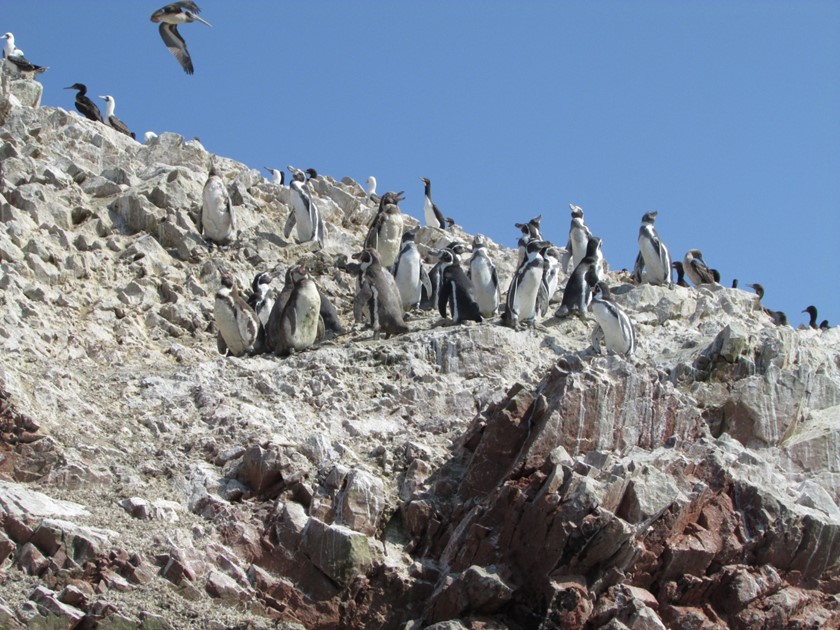
And there was “guano”. We were told that they used to “harvest” the guano and take it back to Spain to use as fertilizer.
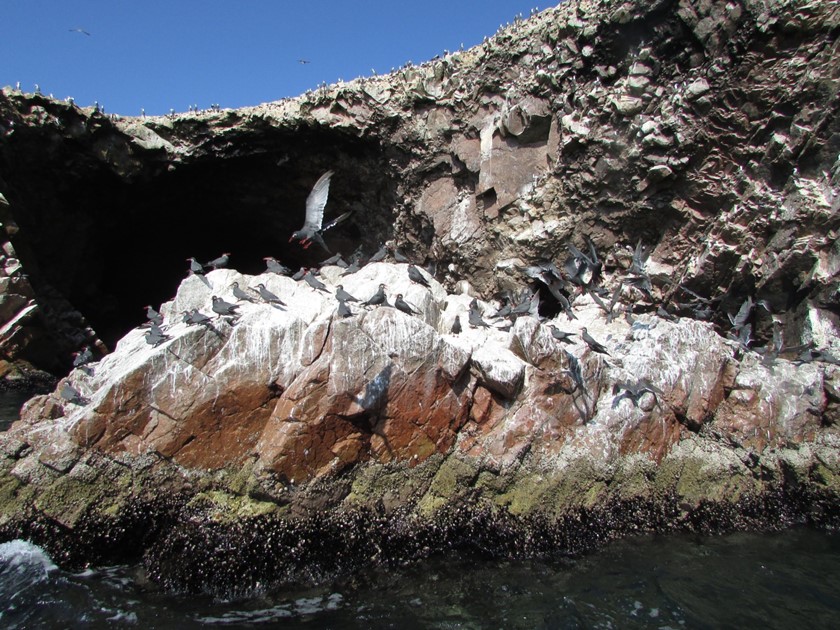
There is an official government outpost on the Island and the lone guard briefly emerged and waved to our boat.
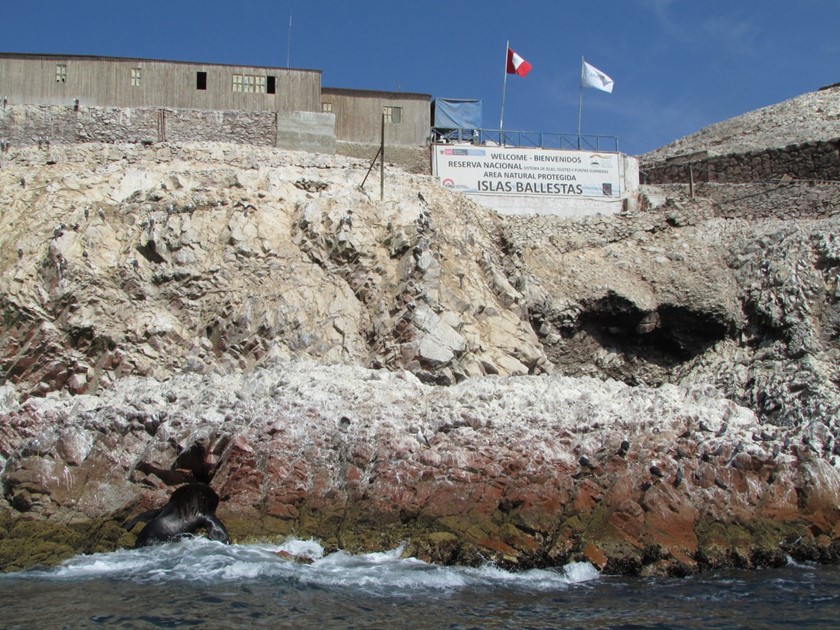
On the way back to the mainland, we encountered a flock of thousands of birds all bathing in the sea. We were told that they were bathing to wash the guano off their feet before continuing their search for food. The sea appeared to be boiling from all of the flapping.
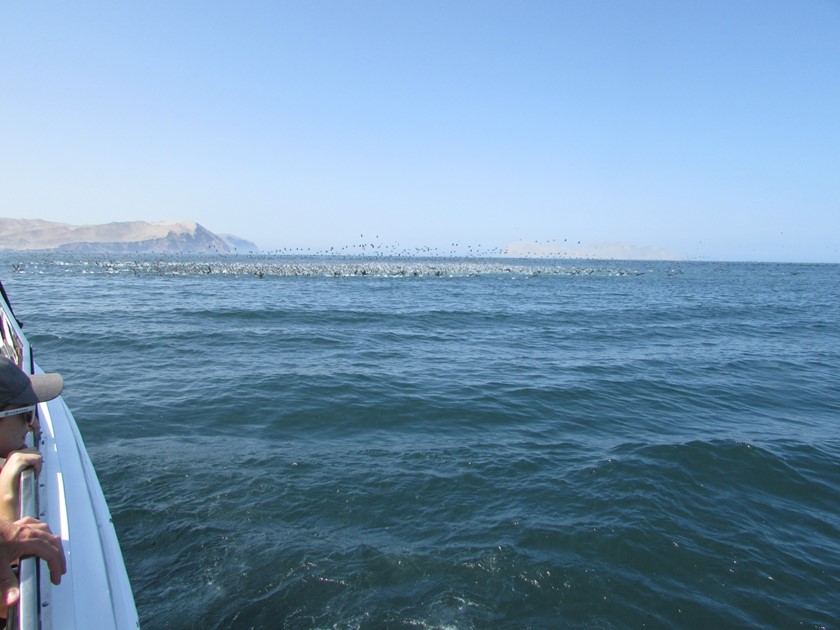
When we arrived back at the mainland, we checked out of our hotel and boarded our bus for a brief ride to the inter-city bus station. Due to traffic and road conditions, the ride back to Lima took 6 hours. If we were to do this again, we would take the relatively short flight to Paracus instead of the bus.
Upon arriving in Lima, we checked into the Hilton Hotel Lima Miraflores.
Monday, February 1, 2016
This was our day for a guided walking tour of the Miraflores section of Lima.
Although it was winter in Chicago, it was summer in Peru. The flowers were in full bloom in the park.
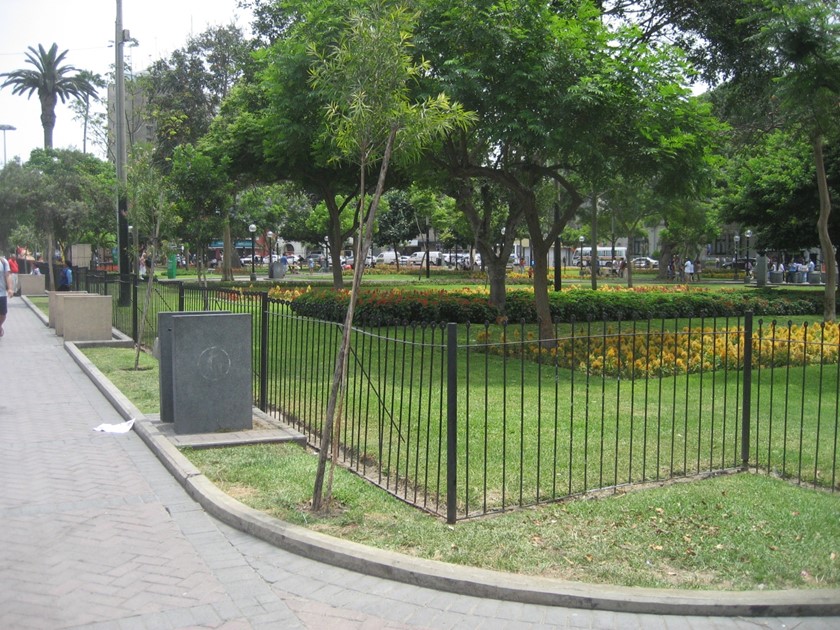
John F. Kennedy was very popular in Peru and there is a statue of him in this park.
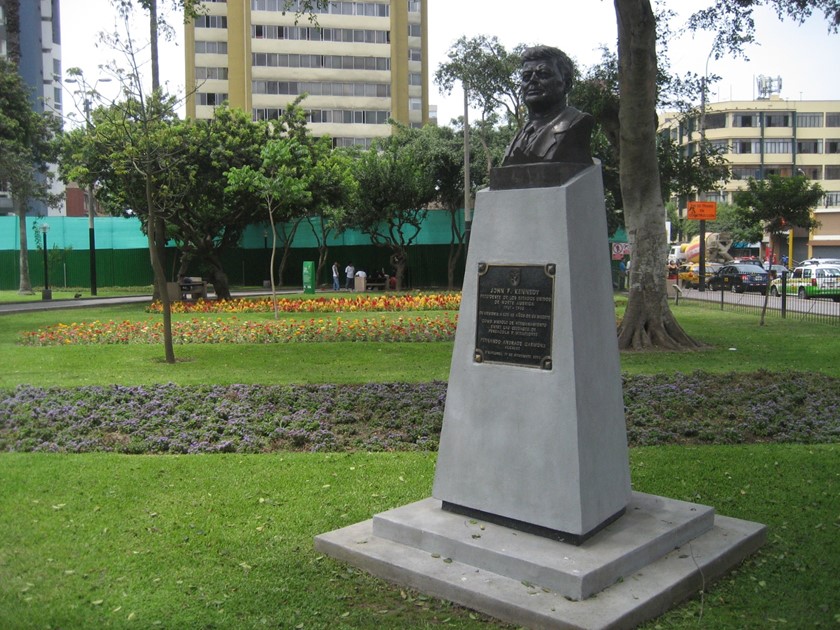
Lima is the capital and the largest city of Peru. It is located in the valleys of the Chillon, Rimac and Lurin rivers, in the central coastal part of the country, overlooking the Pacific Ocean. It has a population of almost 10 million.
Lima was founded by Spanish conquistador Francisco Pizarro on January 18, 1535,
as Ciudad de los Reyes. It became the capital and most important city in the Spanish Viceroyalty of Peru. Following the Peruvian War of Independence, it became the capital of the Republic of Peru.
The city sits high on the bluffs overlooking the Pacific Ocean.
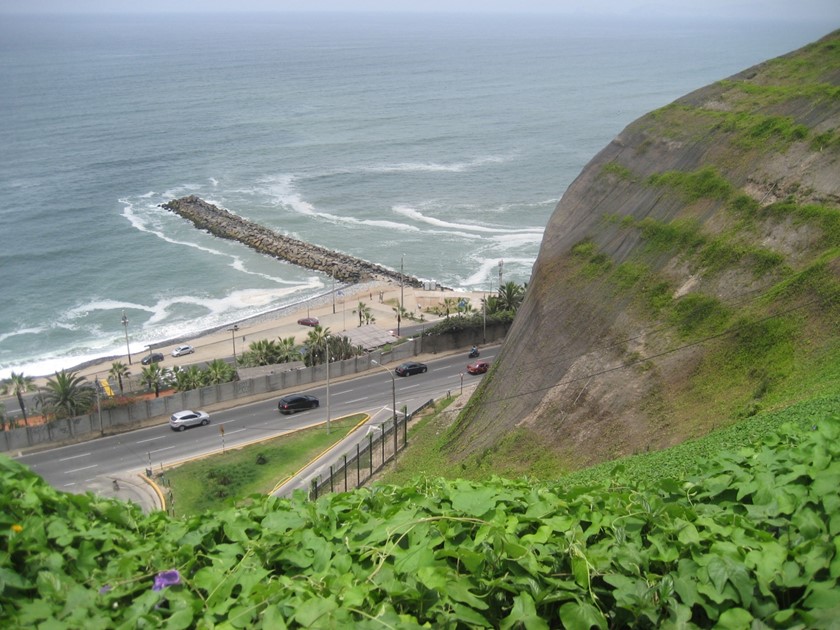
Surfers were hard at work trying to catch a wave.
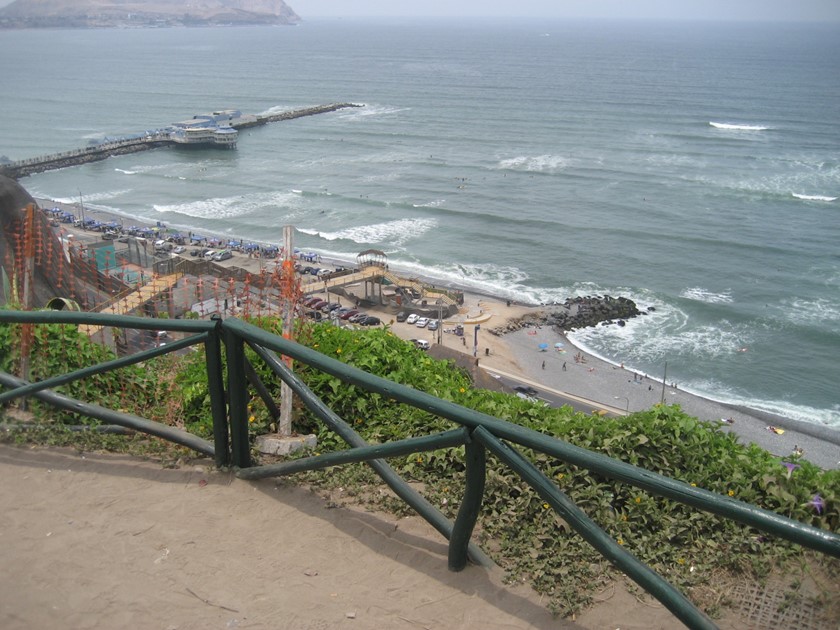
After lunch on our own, we visited Convento de San Francisco, one block northeast from the Plaza Mayor. The church and convent are part of the Historic Centre of Lima, which was added to the UNESCO World Heritage List in 1991. Aside from a church and monastery it also contains a library and catacombs. In this church, Jude the Apostle is venerated. This is as close as I have been to a convent.
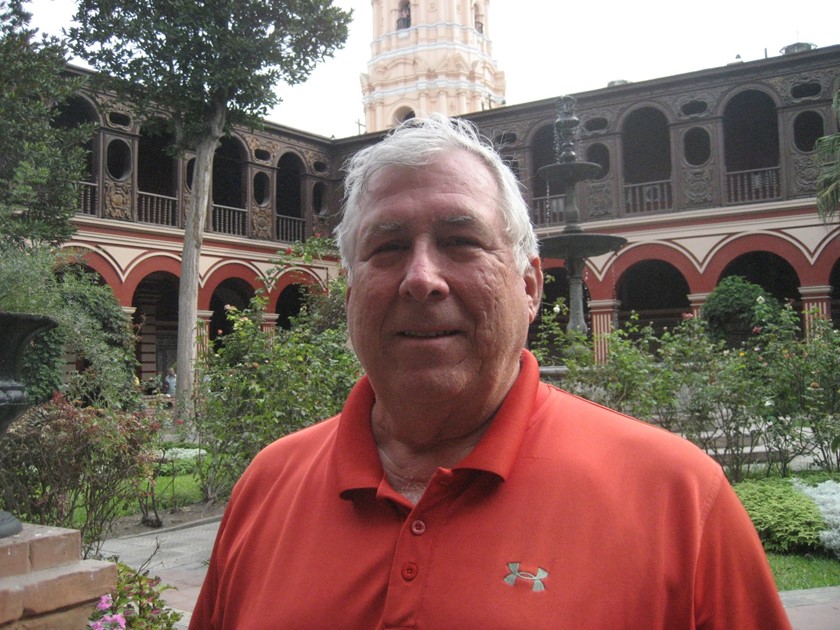
The others in the group visited the Larco Herrera Museum which we had already seen on our own. We took a taxi back to our hotel and relaxed for the afternoon.
Tuesday, February 2, 2016
We departed our hotel early (0630) to the Lima Aeropuerto and our flight to Cuzco. It was raining lightly in Cuzco. Here we met our guide, Yaki (Yakelin Huaman), who was to stay with us through our visit to Machu Picchu.
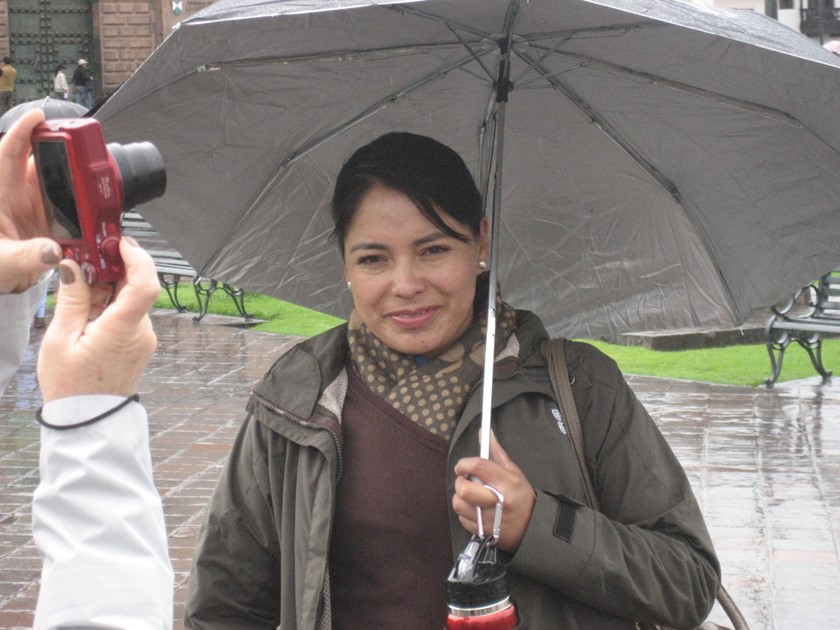
We first visited the Museo Machupicchu Casa Concha where the many relics unearthed by Hiram Bingham now reside.
Bingham was not a trained archaeologist. Yet, it was during Bingham’s time as a lecturer – later professor – in South American history at Yale that he discovered the largely forgotten Inca city of Machu Picchu. On July 24, 1911, Melchor Arteaga led Bingham to Machu Picchu, which had been largely forgotten by everybody except the small number of people living in the immediate valley. Bingham returned to Peru in 1912, 1914 and 1915 with the support of Yale and the National Geographic Society.
Many artifacts unearthed during his explorations were sent to Yale University and kept on display. Peru had long sought the return of the estimated 40,000 artifacts, including mummies, ceramics and bones, that Bingham had excavated and exported from the Machu Picchu site. On September 14, 2007, an agreement was made between Yale University and the Peruvian government for the return of the objects. On April 12, 2008, the Peruvian government stated that it had revised previous estimates of 4,000 pieces up to 40,000. Yale has now returned 366 of these artifacts to Peru and they reside in this museum.
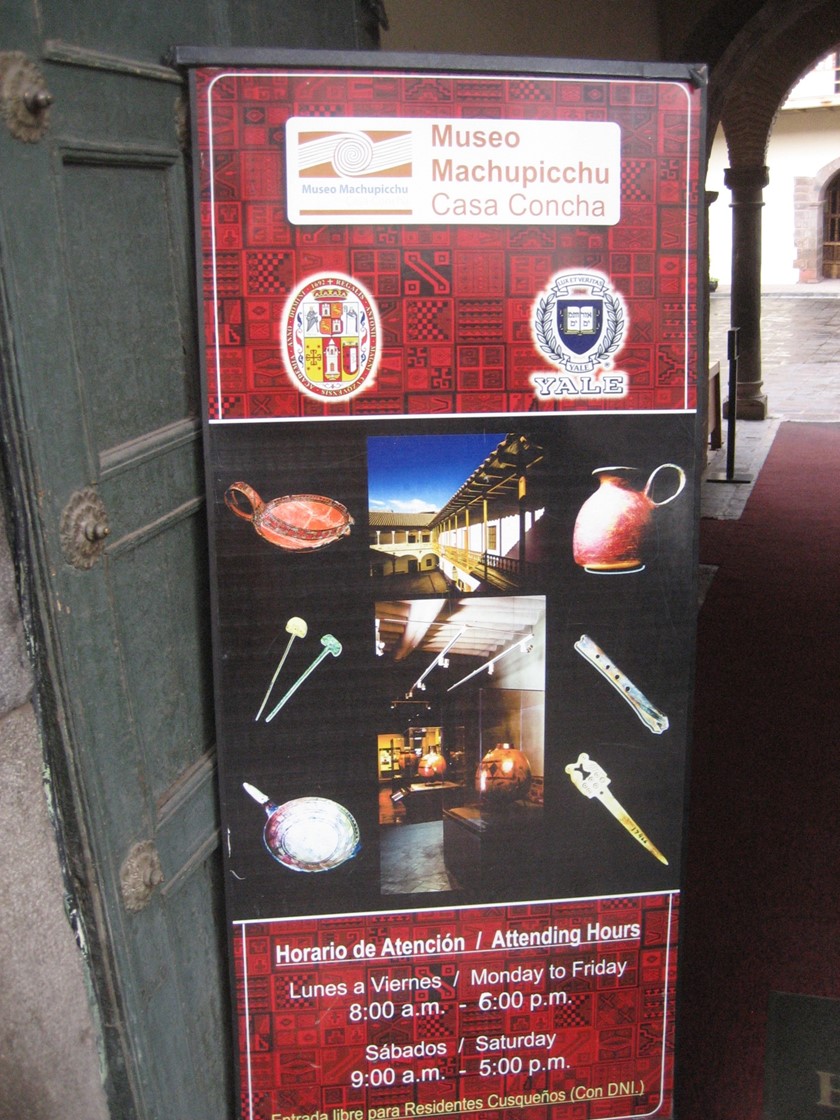
In Cuzco we stayed at the Aranwa Hotel which was only a block from the Plaza Mayor.
Wednesday, February 3, 2016
Because we were visiting Machu Picchu in the rainy season, the train line that leaves from Cuzco was not operating. Apparently, some of the bridges can become unsafe. This necessitated us taking an hour and a half bus ride to Pachar train station in the Sacred Valley where we caught our train to the mountain.
Near Pachar, our guide pointed out some of the most expensive hotel rooms in Peru. Climbers use ropes to reach these hotel rooms on the side of the mountain and use a zip-line to get back down. We were able to watch two zip-liners come down out of these things.
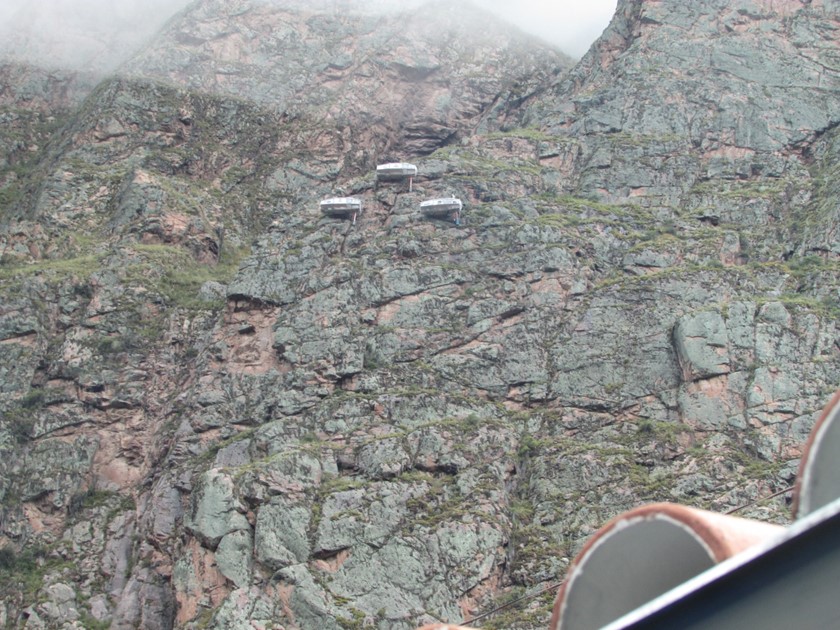
In Pachar we boarded the train (narrow gauge) to Aquas Calientes at the foot of Machu Picchu.
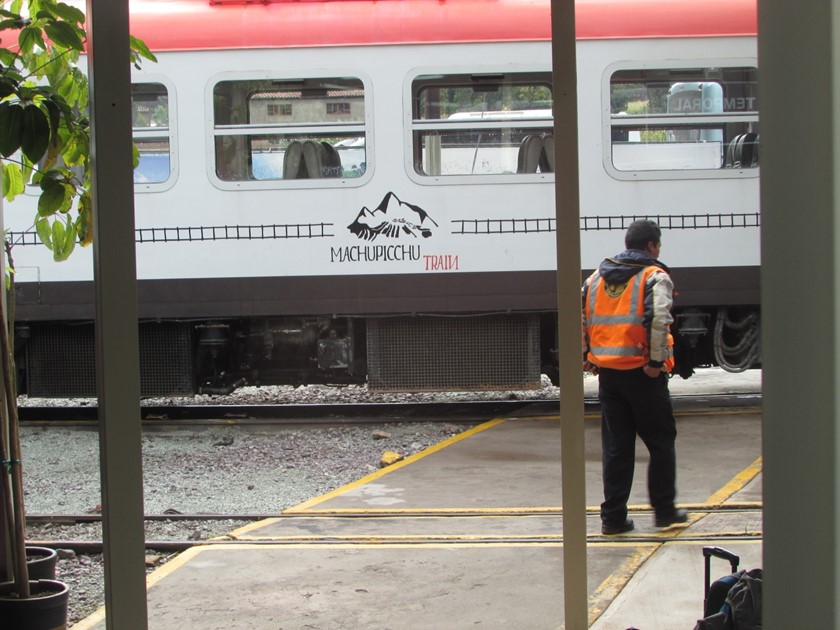
The train winds its way along the Urubamba River through the Andes. Cuzco is at 11,000 feet elevation while Machu Picchu is 8,000 feet so we were actually descending. Much of the way it parallels the trail that hikers use to access Machu Picchu. The trail was closed to hikers during February for trail maintenance.
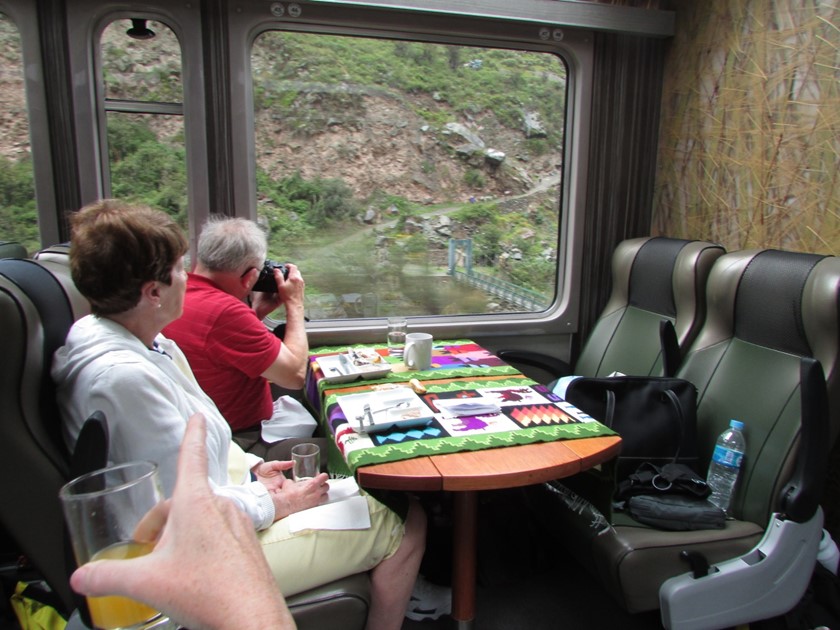
Upon arrival at the train station, we walked across a bridge over a very fast moving river to board busses to the entrance to Machu Picchu.
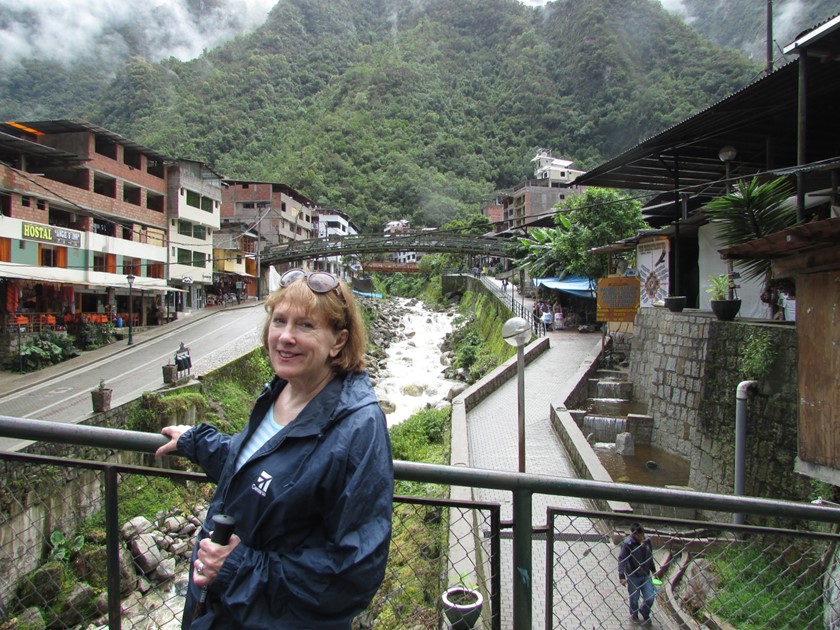
The town of Aquas Calientes appeared to be very interesting but we didn’t get to spend any time there.
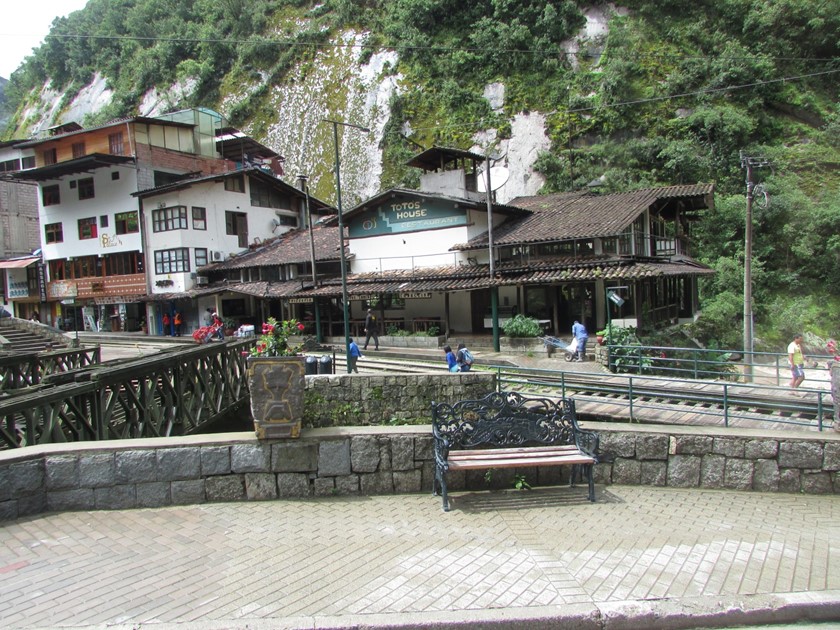
The entrance to Machu Picchu is very crowded and there are controls on how many people can visit at any one time.
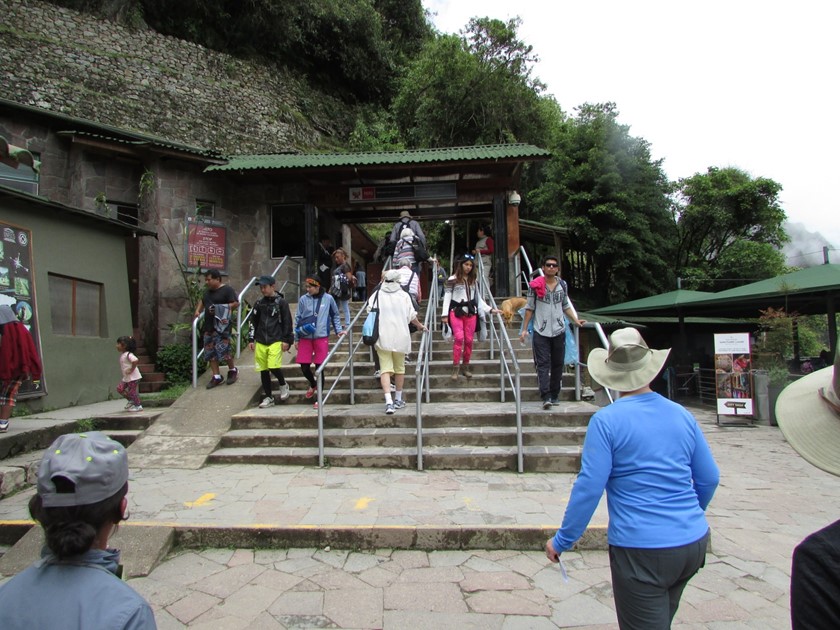
It was our turn and we were glad to be there.
There were plaques just inside the park that recognize Hiram Bingham for his discovery of these ruins in 1911.
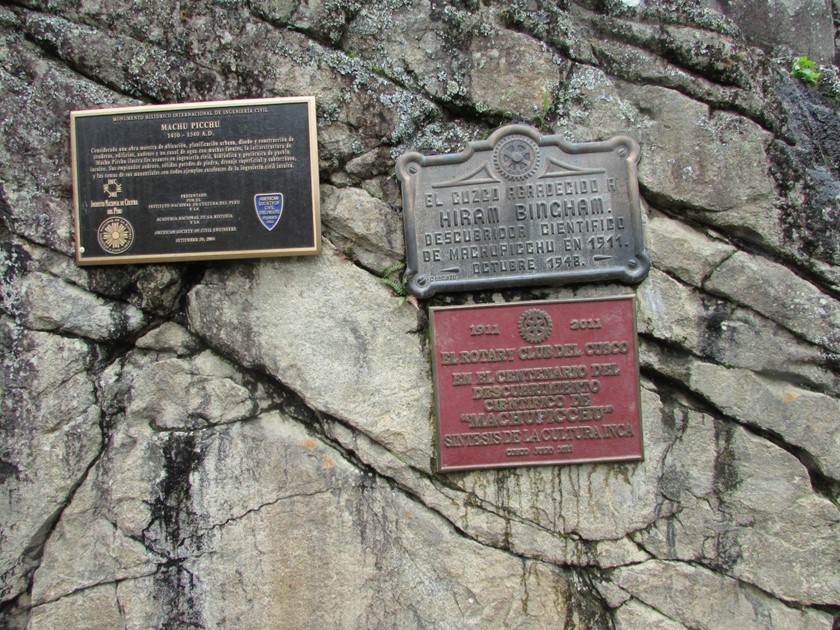
The expanse of the city of Machu Picchu and the surrounding scenery are difficult to describe and more difficult to capture in photos.
Here Pat and I are overlooking the temples and the valleys below.
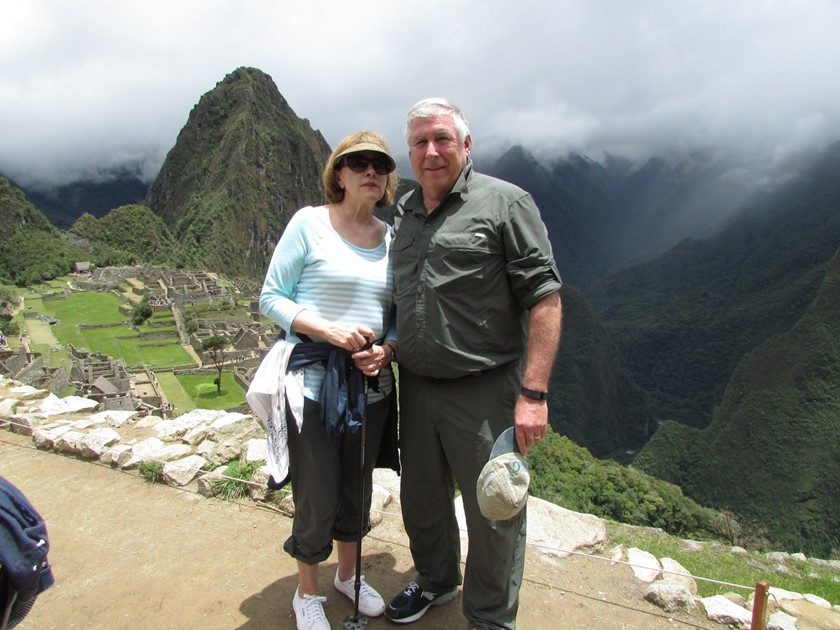
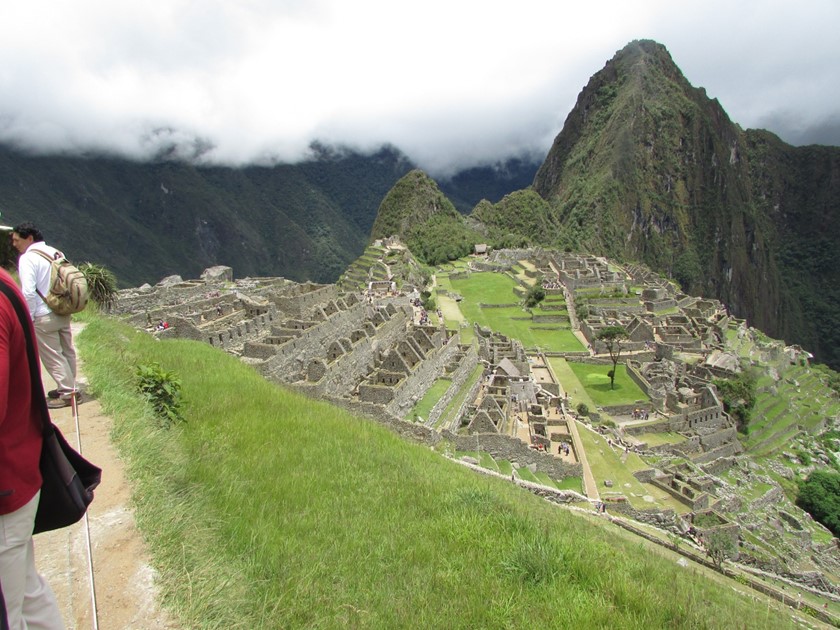
Below are the thirteen people traveling with us through Machu Picchu and the Galapagos Islands.
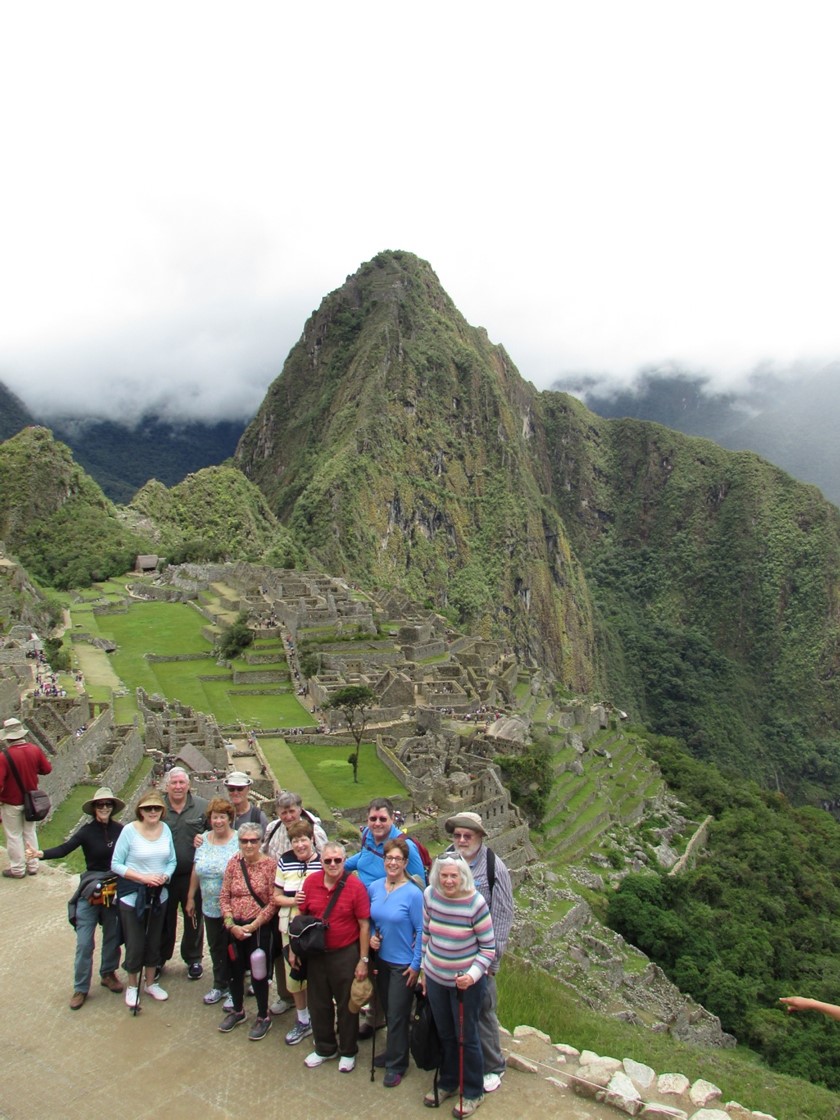
T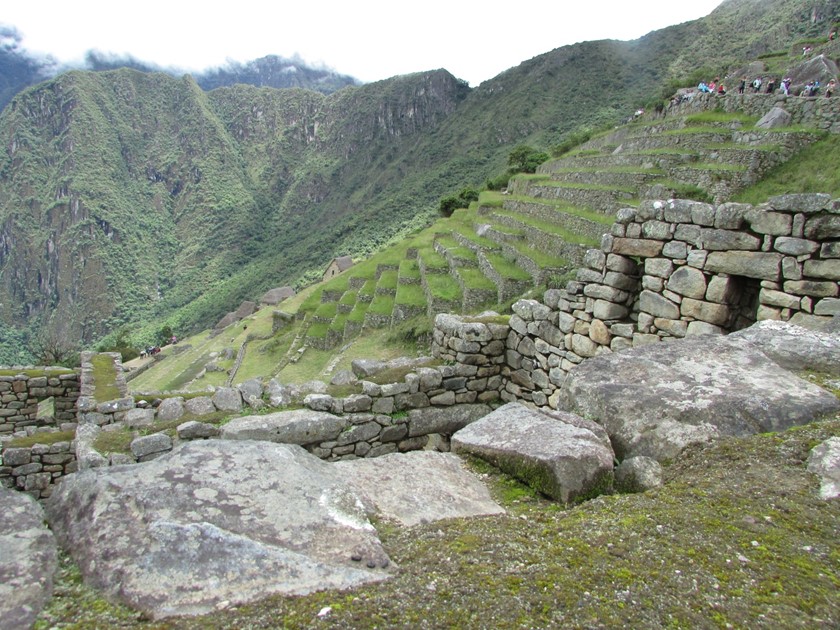
The steep terraces were not so much for agriculture as for stability during earthquakes which are fairly common.
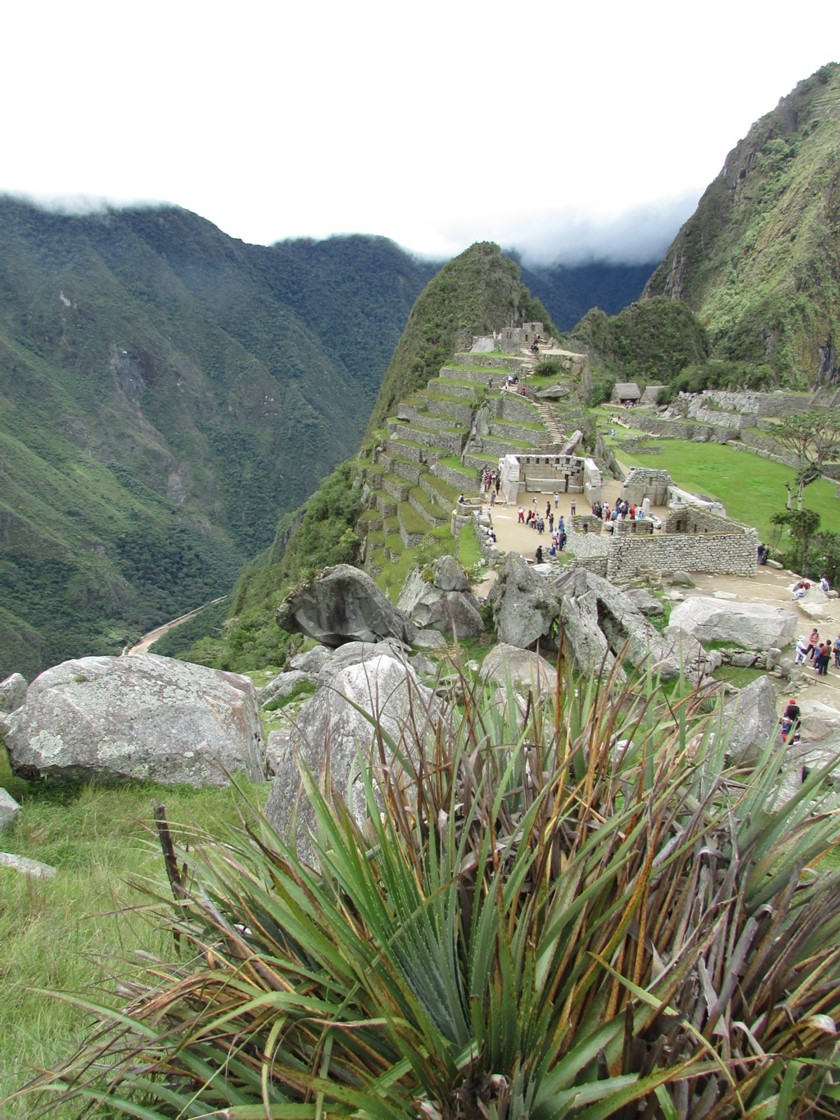
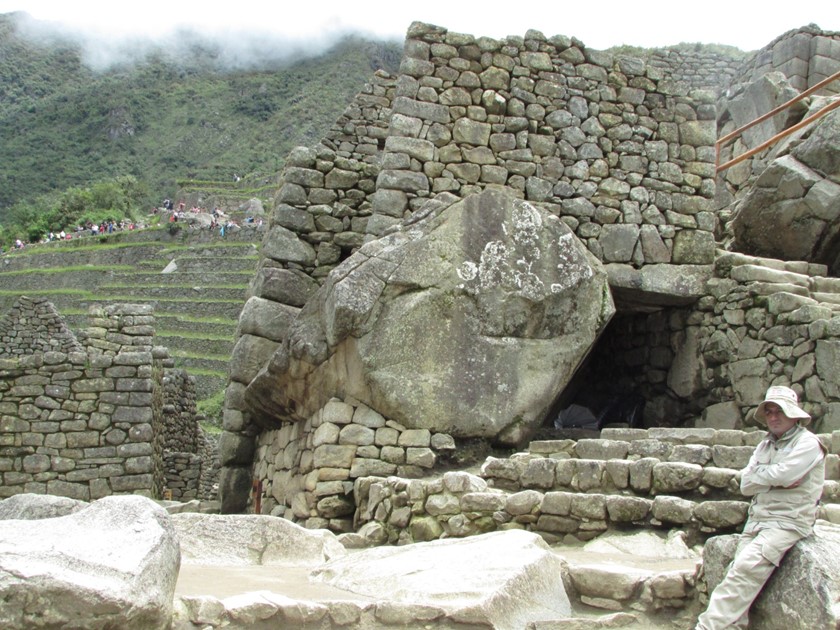
When the boulder was too large to move, they appear to just built around it.
Below is the temple area where sun would enter the circular building at explicit times during the seasons.
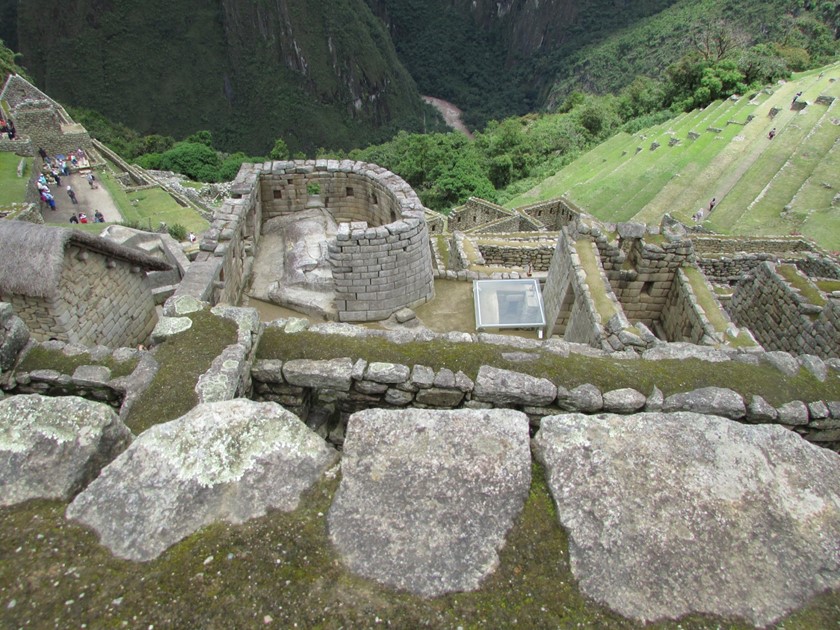
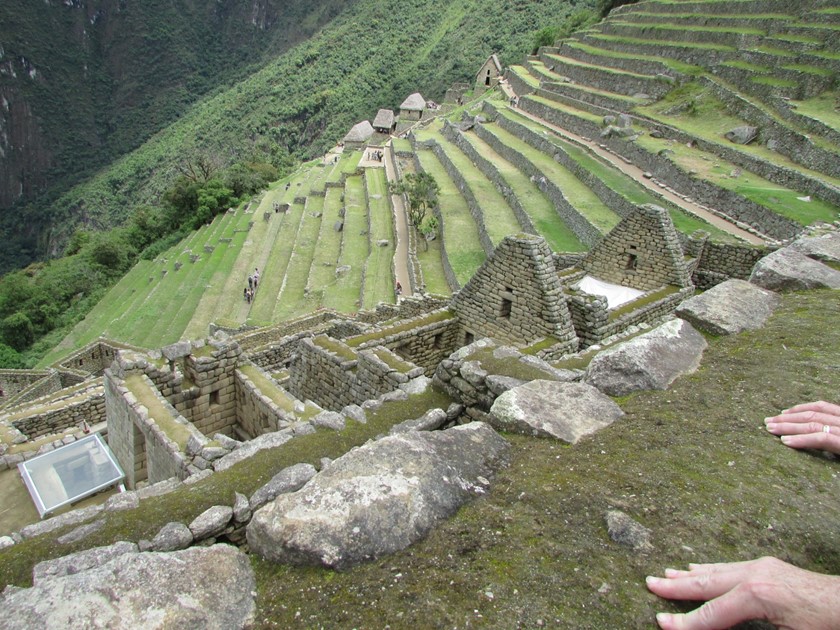
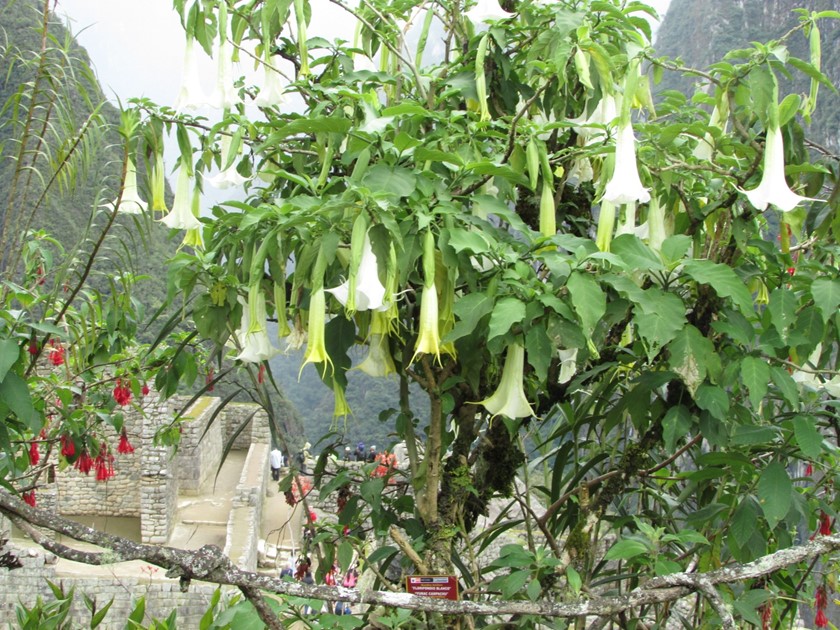
The wall below was the victim of an earthquake.
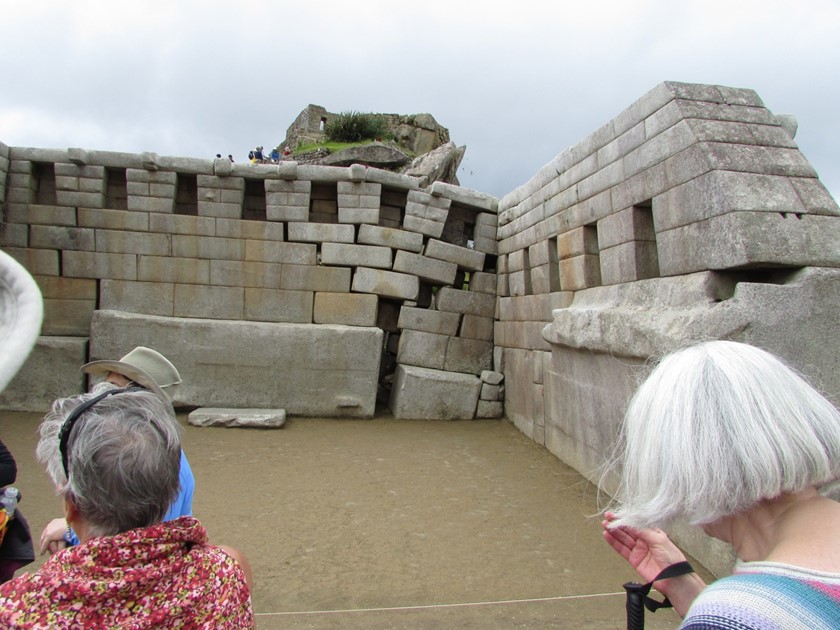
The scenery is just spectacular surrounding this whole area.
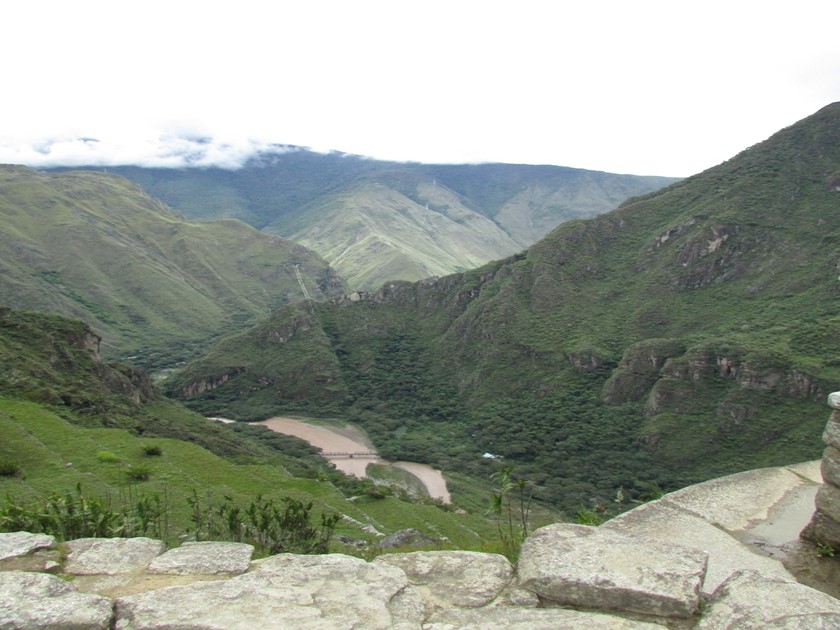
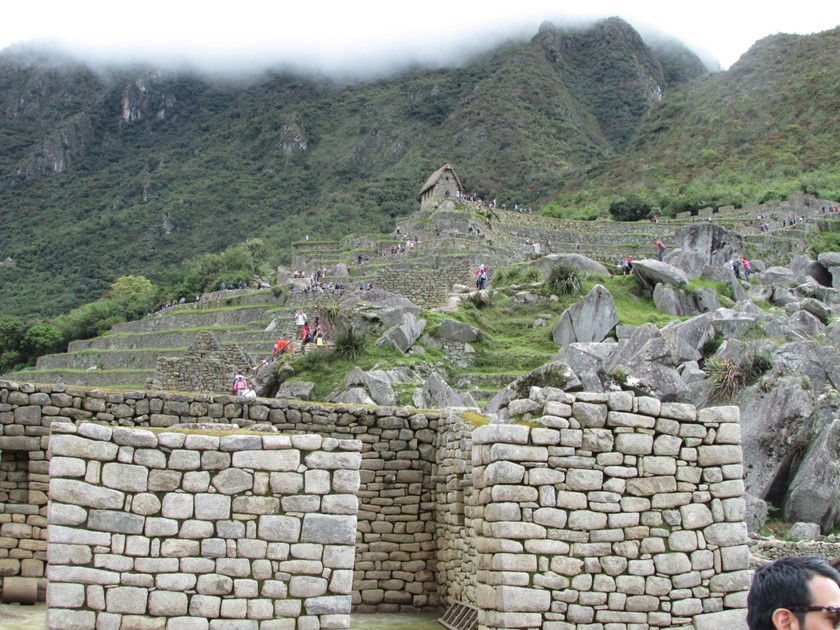
There were Alpaca grazing in the area and they seemed to move freely about without regard to all of the visitors.
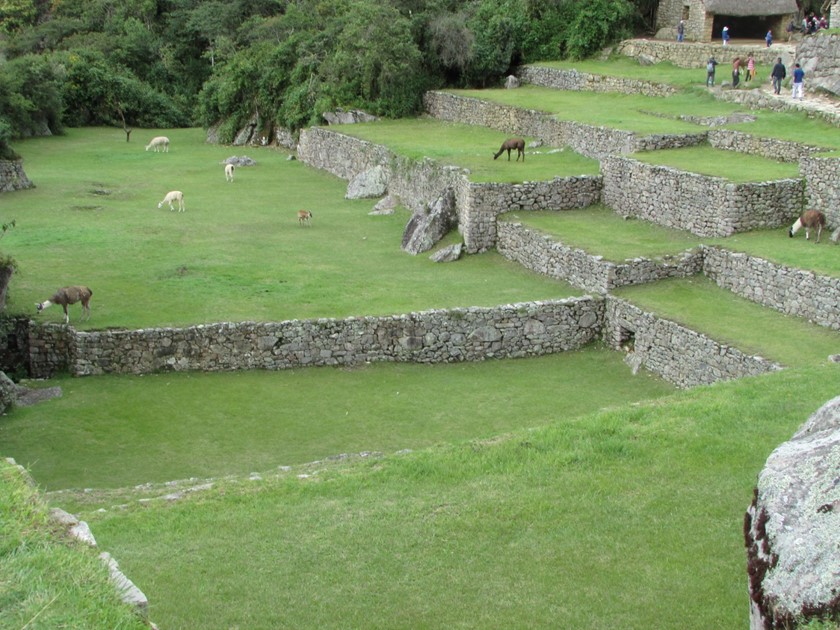
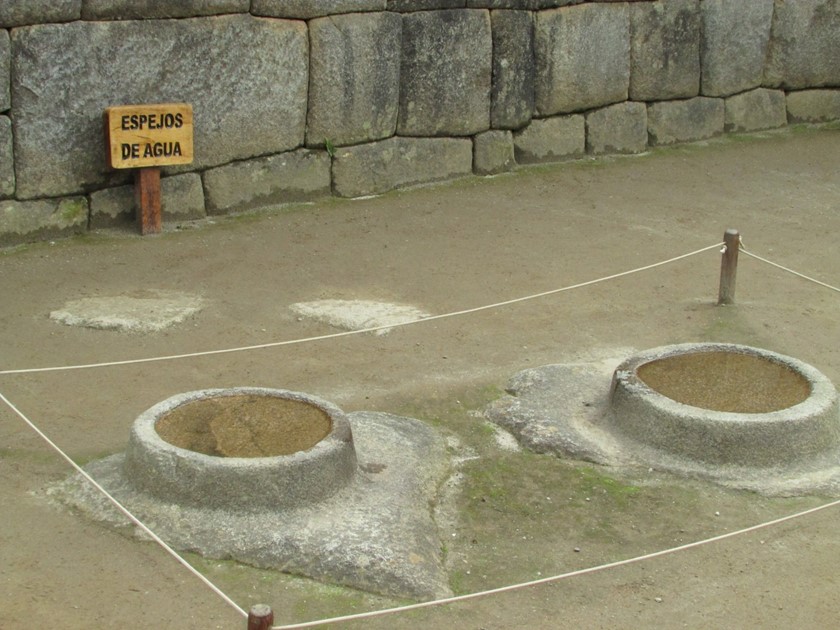
Following our visit to the ancient site, our buses took us to our hotel. We stayed at the Inkaterra Machu Picchu Pueblo Hotel. This hotel doubles as an ecology center and its gardens have hundreds of species of Orchids and many humming birds.
This is a waterfall that ran between the Inkaterra property and the small town.
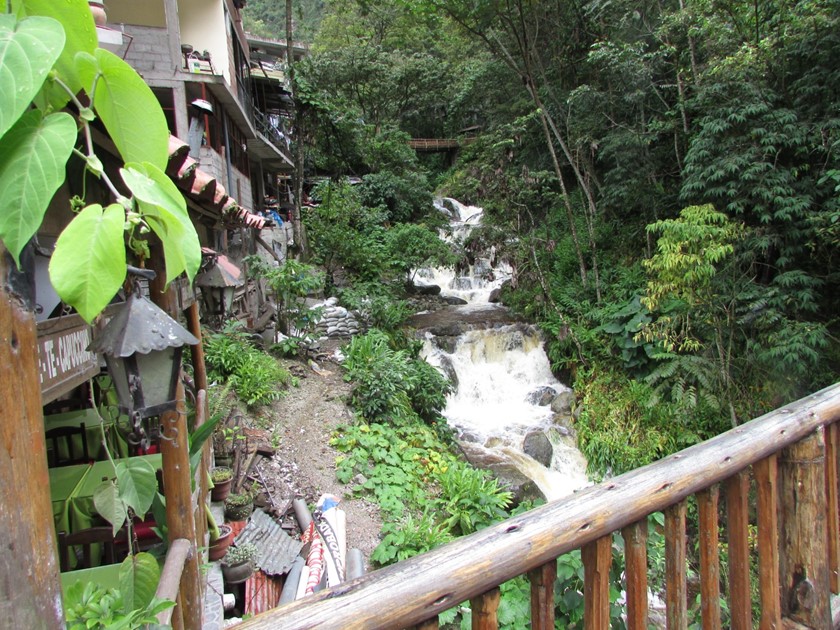
Thursday, February 4, 2016
Following breakfast, we were given two options for the morning, hike to the Temple of the Sun in Machu Picchu or take a guided tour of the Orchid gardens. The path to the Temple of the Sun was reported to be narrow, steep and somewhat slippery. With Pat’s broken shoulder, we chose to stay in town and tour the Orchid gardens.
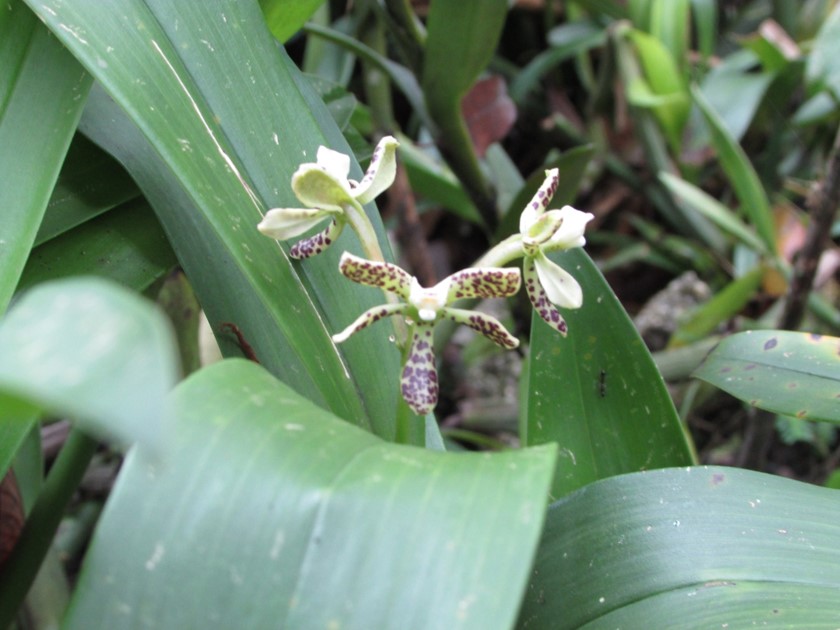
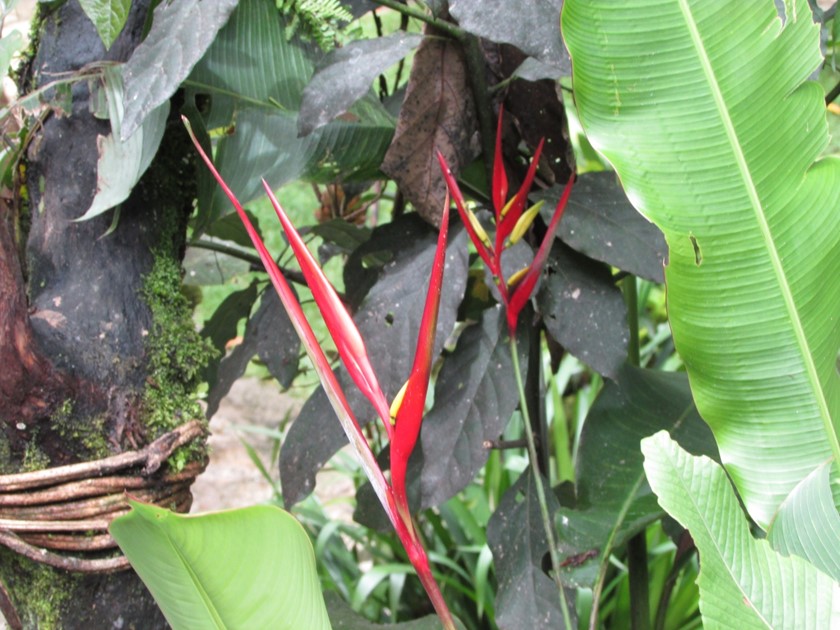
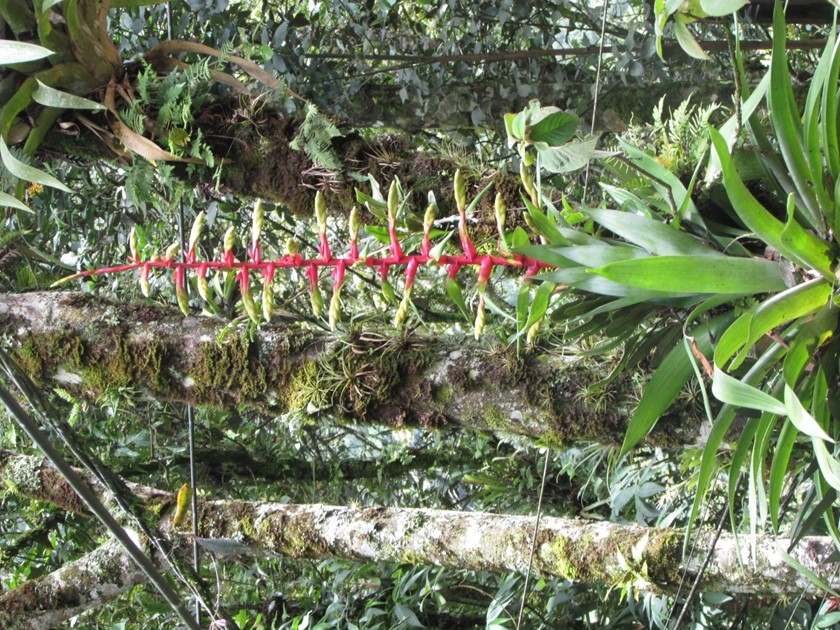
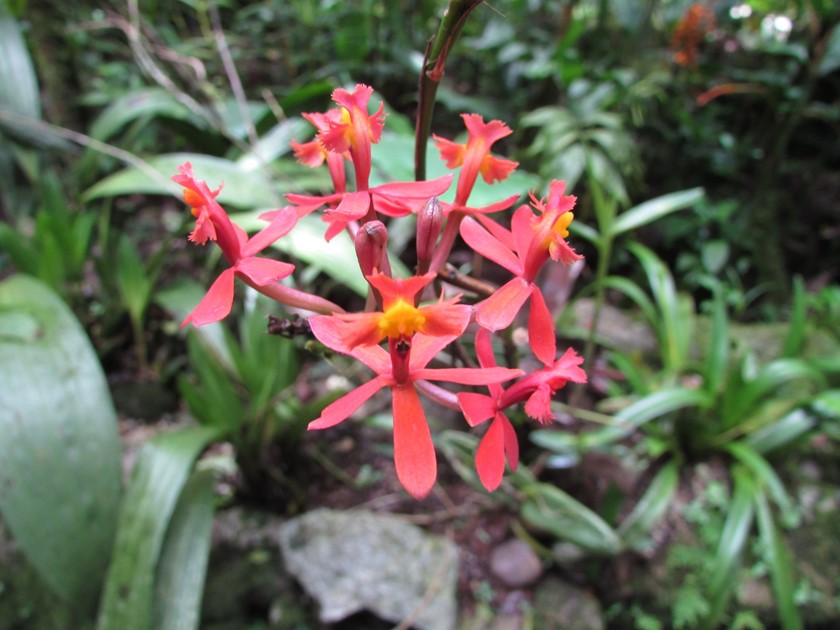
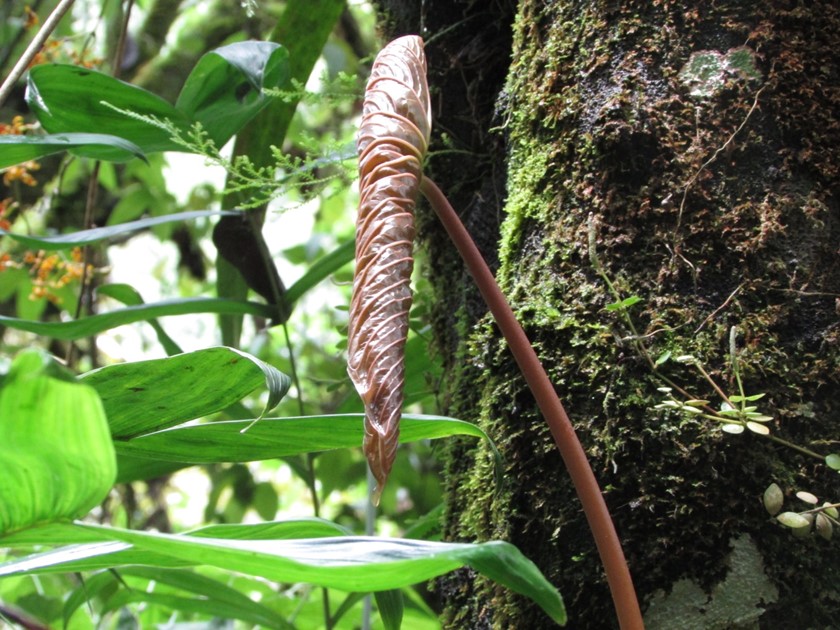
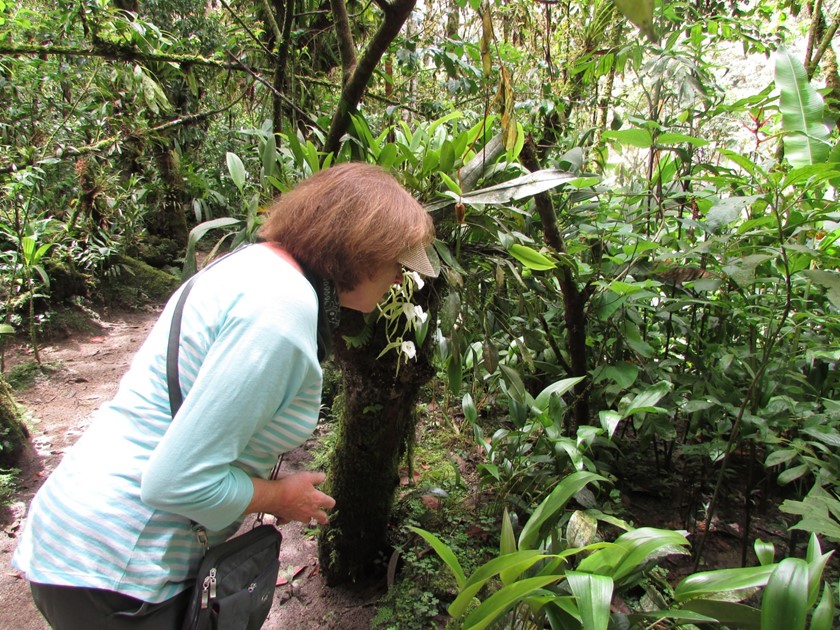
Following the tour and lunch, we boarded the train back to Pachar and then bus back to Cuzco where we rejoined our luggage at the Aranwar Hotel.
Friday, February 5, 2016
Following breakfast, we rejoined Yaki (our guide) for a morning tour of Cuzco. Cuzco was historically the Inca capital. The city is at 11,000 feet elevation.
The first stop was the San Pedro Market. This was a very large, under roof but not enclosed marketplace with all of the pastries, fruits, vegetables and meats one could imagine. There were also counters where one could enjoy breakfast or lunch.
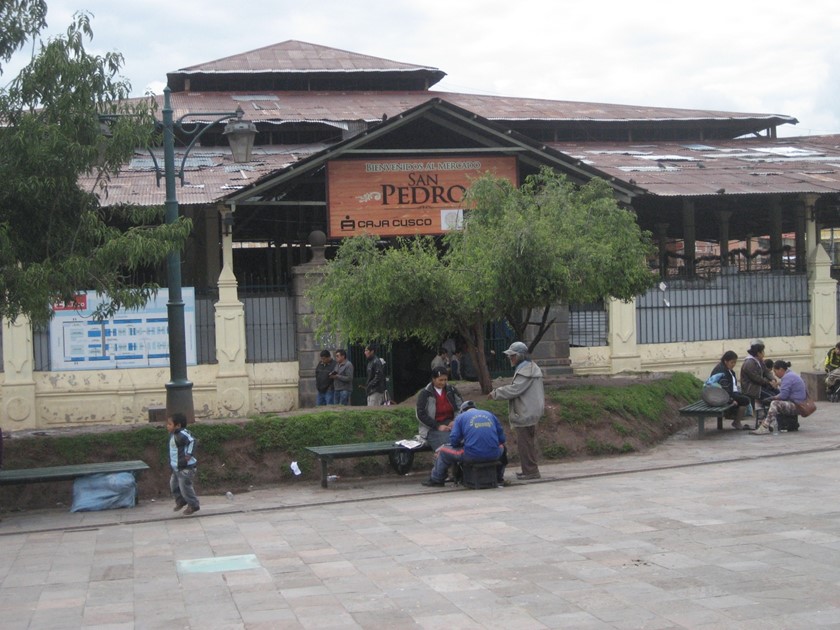
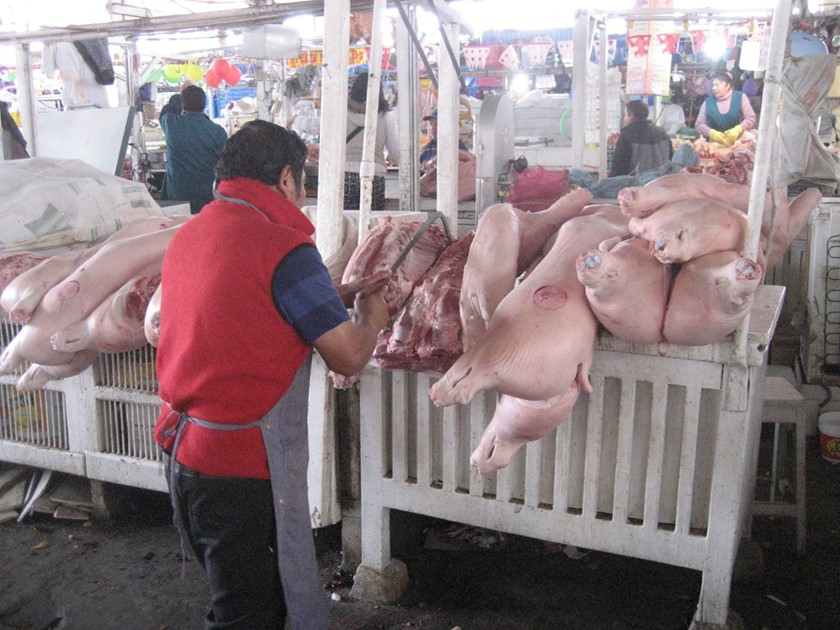
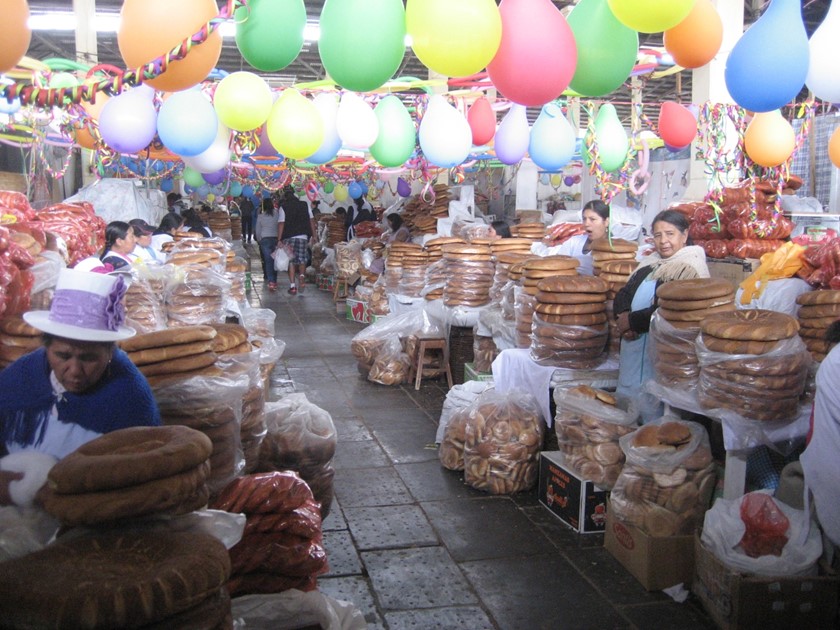
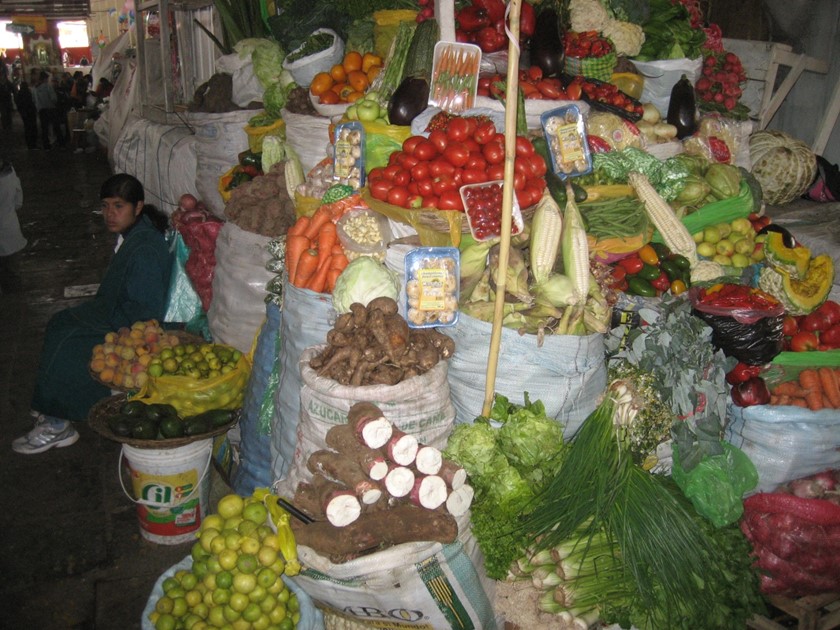
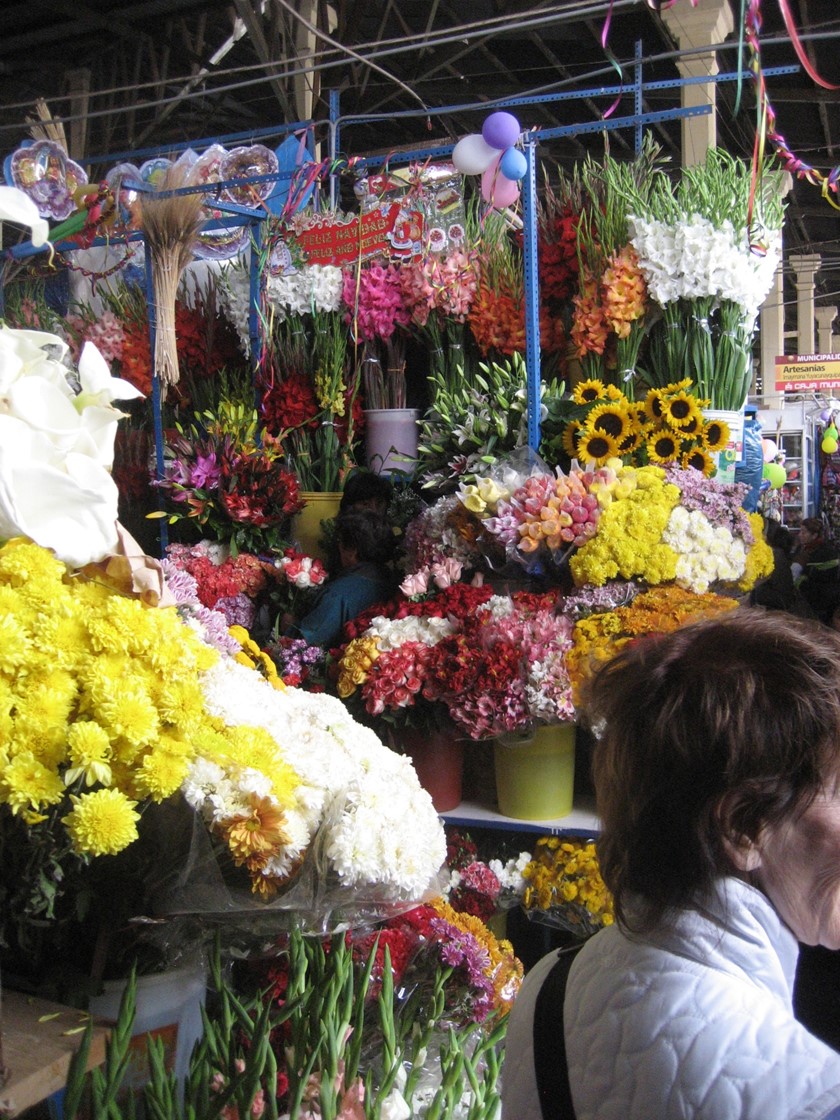
We then got back on our bus and went to the Almudena Cemetery. Some of the vaults were down stair cases under ground.
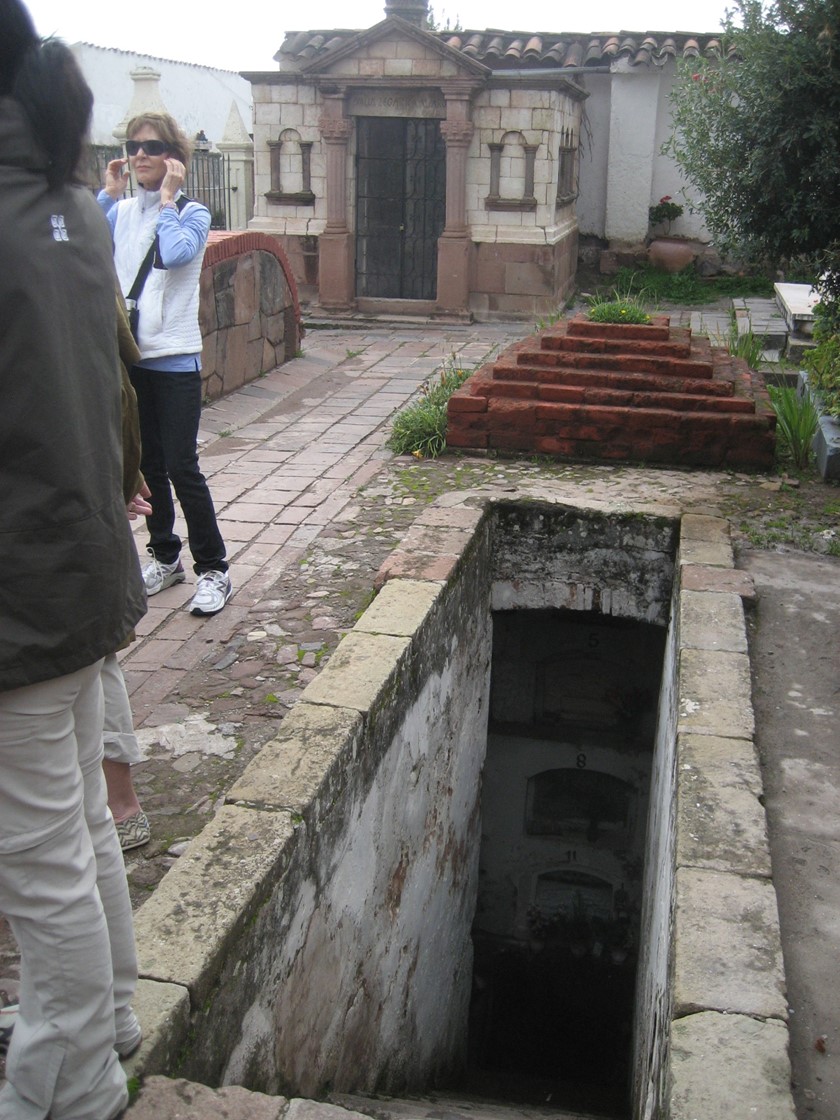
And some were quite elaborate.
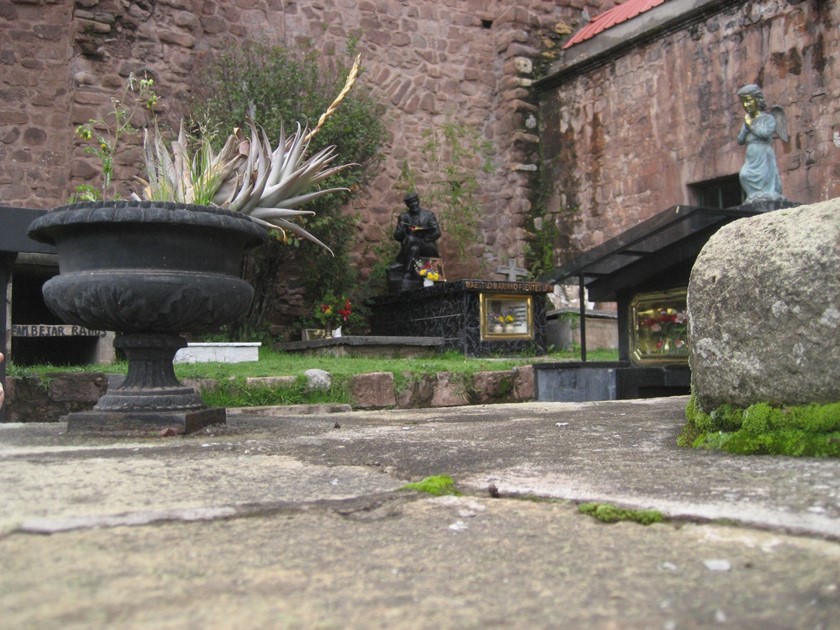
We were told that family members only rent these above ground vaults. If they fail to make payments, the ashes are removed and the slots are rented to the next family.
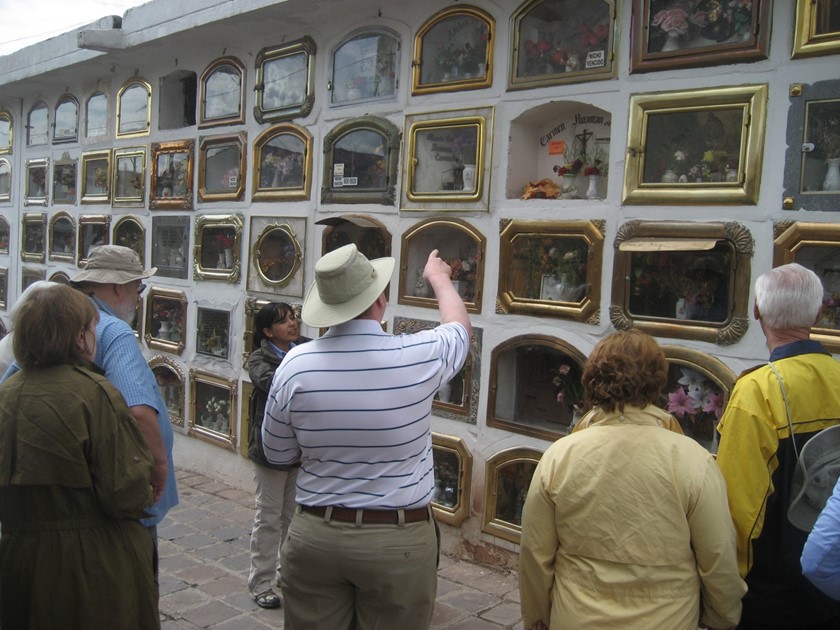
We then visited the very elaborate Templo De Santo Domingo overlooking the city of Cuzco.
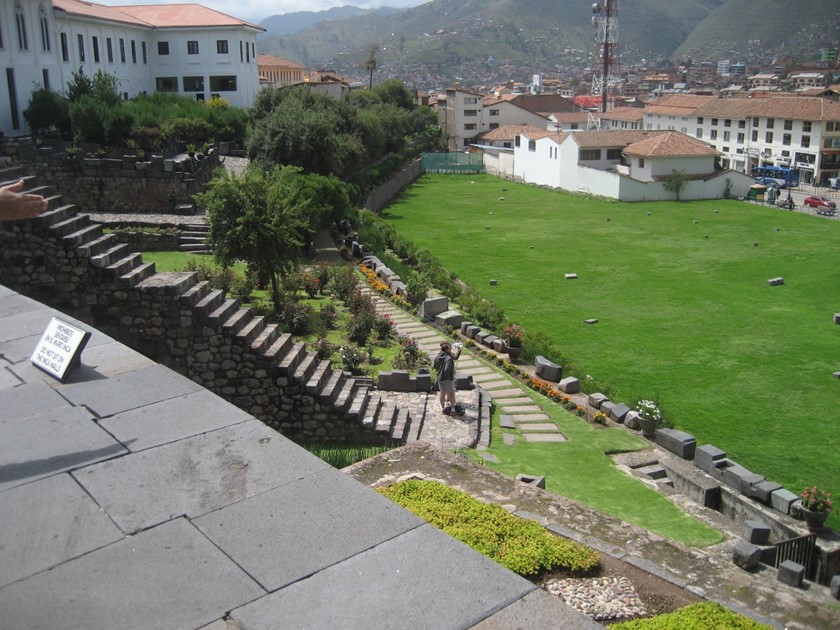
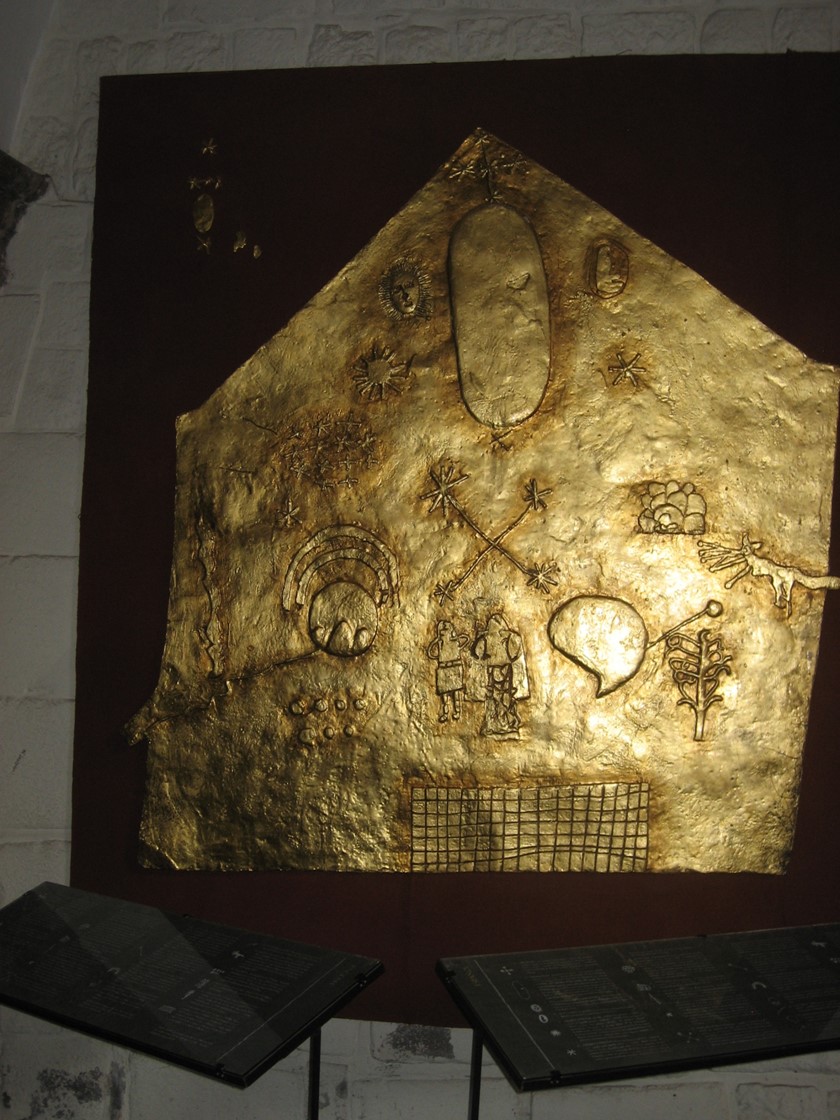
The explanation of this piece of art is shown below.
“The original of this line drawing forms part of the chronicle “Relation of the Antiquities of this Kingdom of Peru” written around 1613 by Joan de Santa Cruz Pachacuti Yamqui Salcamaygua, native author, descendant of governors of the provinces of Canus and Canchis. The image illustrates the cults of the temple of Qorikancha of the Inca times. It must be taken into account that the drawing was made many years after these cults were expelled from Qorikancha. This the author couldn’t know them from his own experience. His information was probably based on the oral tradition of his society.
This image is usually interpreted as a representation of the interior wall as the main alter or as the facade on the Inca Temple with the figures attached to its surface, but the text of the chronicle does not give precise references about it. Some researchers see in Pachacuti’s drawing a scheme of the Andean cosmology. (Romero, Lehmann, Neitche, Gary Urtona , others consider that the image was inspired by the structure of Catholic alters (Ana Sanches, Pierre Eryamsa) Probably it was the result of both influences indigenous and European.
The drawing includes comments written by the side of each element in three languages, Spanish, Quechua and Aymara.”
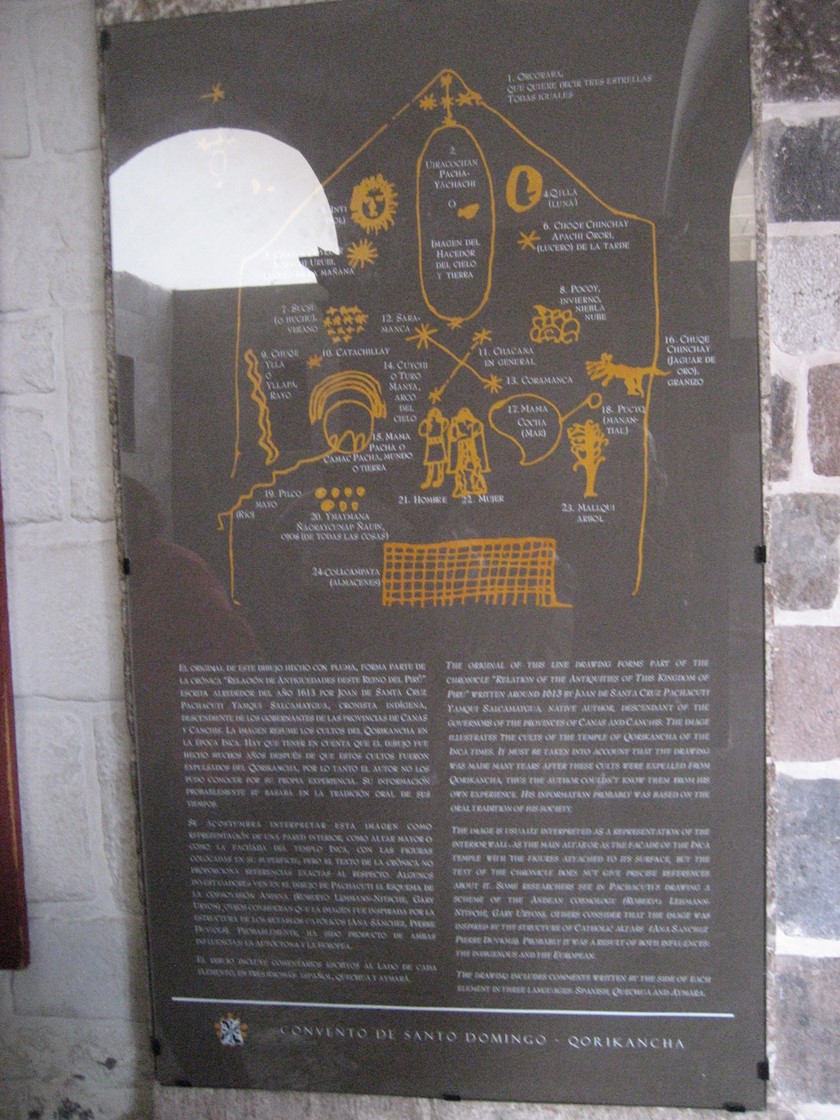
Below we had a beautiful view of the whole valley of Cuzco.
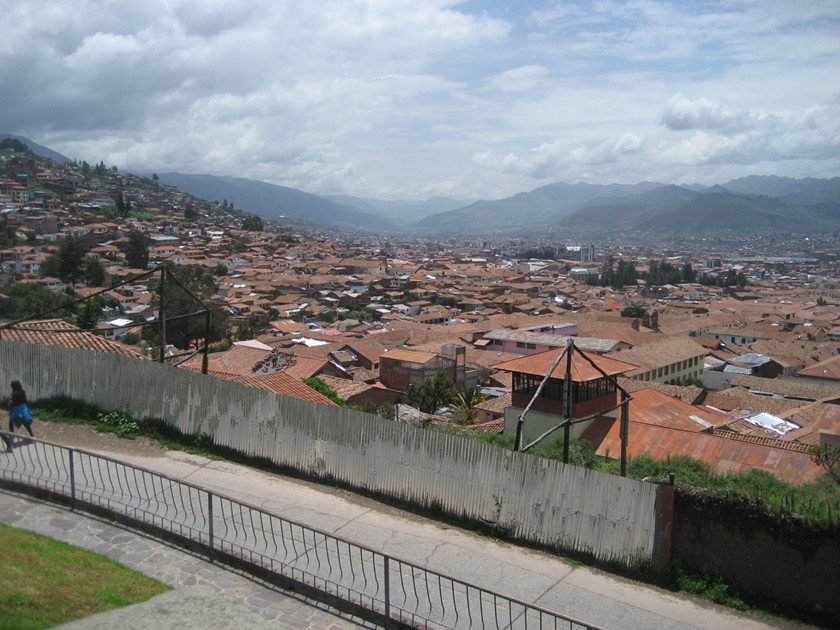
And Pat had the opportunity to have her picture taken with two young girls in native dress.
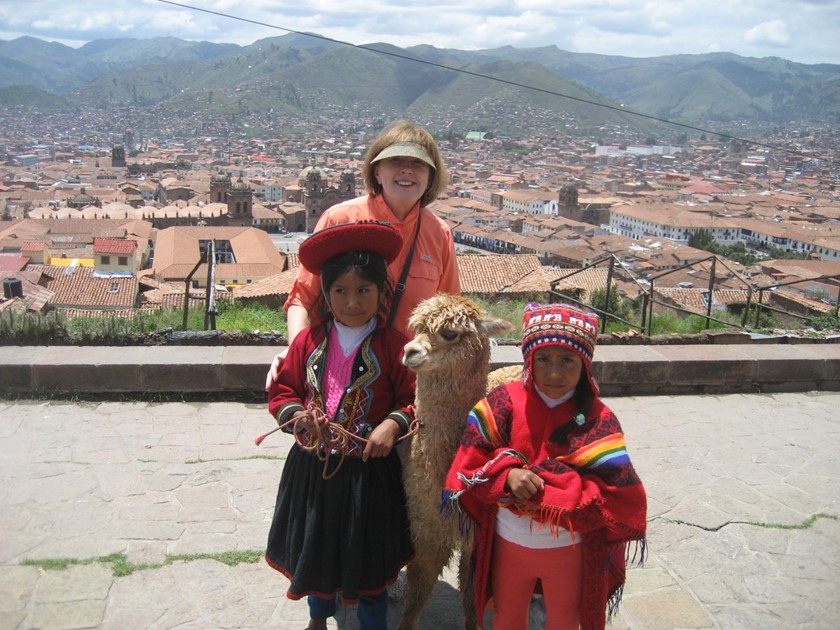
We again boarded our bus and drove to another archeological site called Saqsaywaman (Sexy Woman).
This is a citadel on the northern outskirts of the city ofCusco, Peru. Sections were first built by the Killke culture about 1100; they had occupied the area since 900. The complex was expanded and added to by the Inca from the 13th century; they built dry stone walls constructed of huge stones. The workers carefully cut the boulders to fit them together tightly without mortar. The site is at an altitude of 12,142 ft.
In 1983, Cusco and Saksaywaman together were added to the UNESCO World Heritage List for recognition and protection.
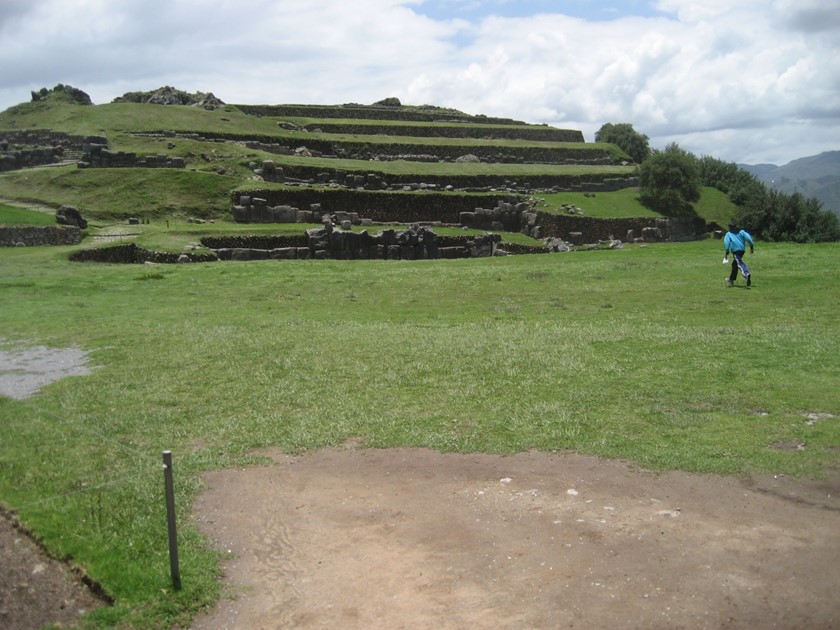
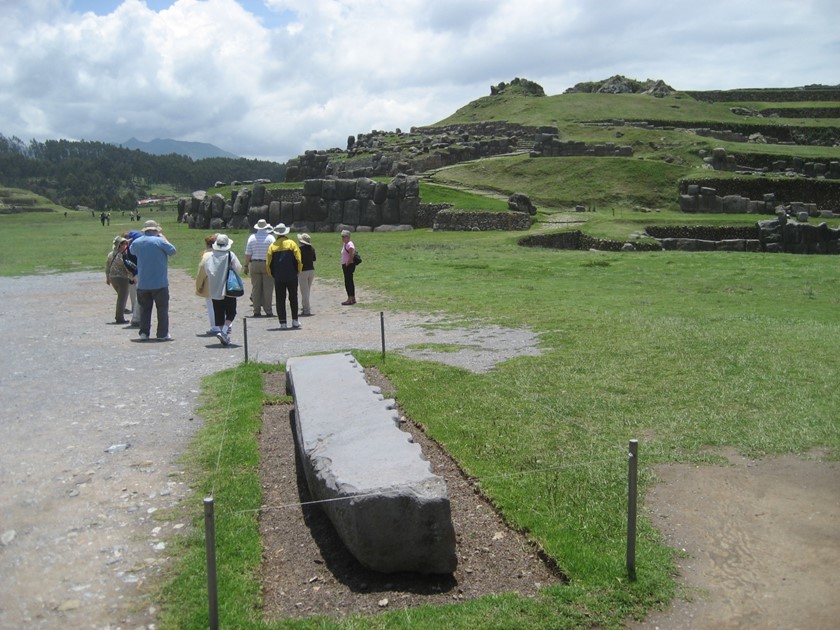
You can see below the tight fit of the stones used in construction.
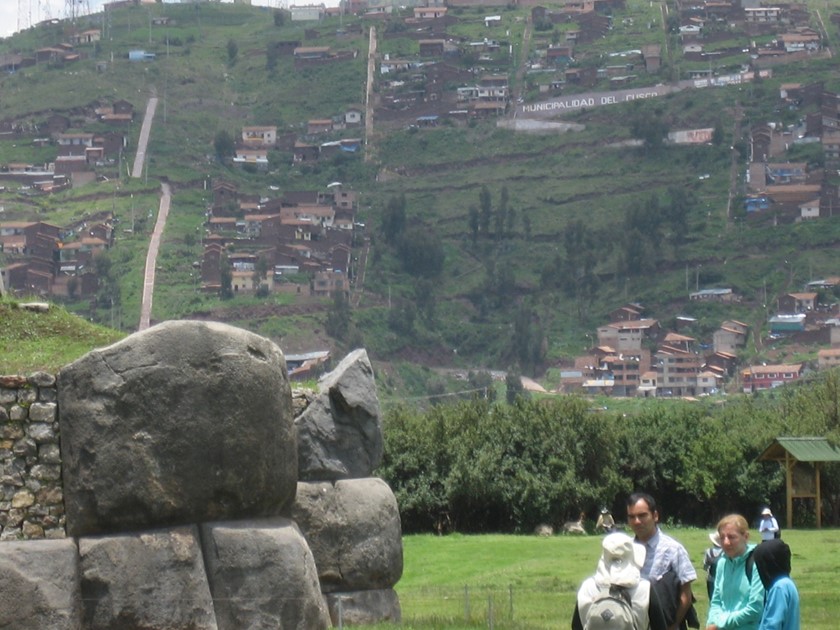
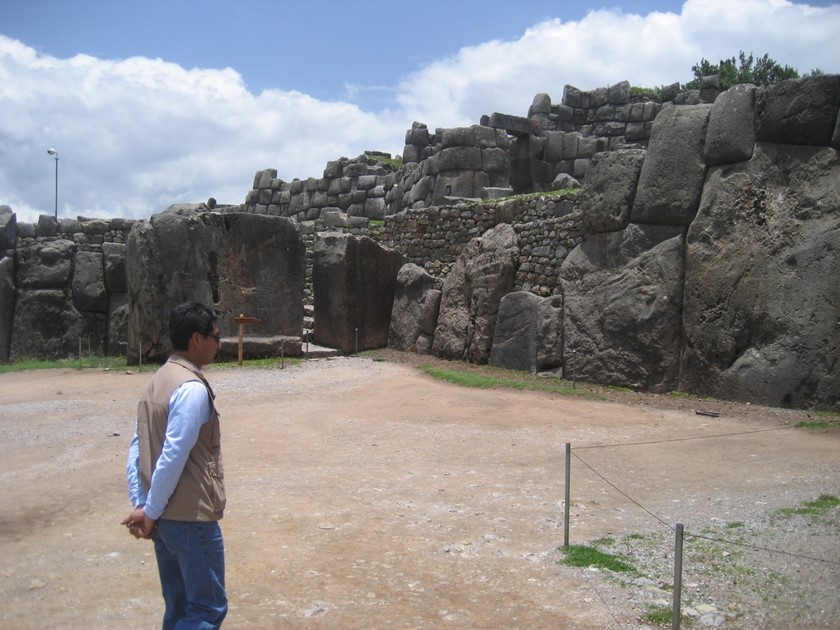
Yaki and the bus escorted us back to our hotel. We had the afternoon on our own to enjoy the town of Cuzco.
While we were enjoying lunch, the skies opened up with a torrential downpour. Fortunately it stopped just as we finished and the sun came back out. The Andes create very interesting and unpredictable weather patterns.
Once again, we packed our bags in anticipation of an early departure in the morning.
Monday, February 6, 2016
This was our day to travel to the Galapagos Islands. We left the hotel at 0630 for the Quito airport. The flight stopped briefly in Guayaquil but we stayed on the plane. We then landed at Baltra Galapagos Islands Airport.
This was a former U.S. military base constructed to protect the Panama Canal during World War II.
Following a brief bus ride with open windows being the only air conditioning, we arrived at the Baltra dock to board our first ferry boat.
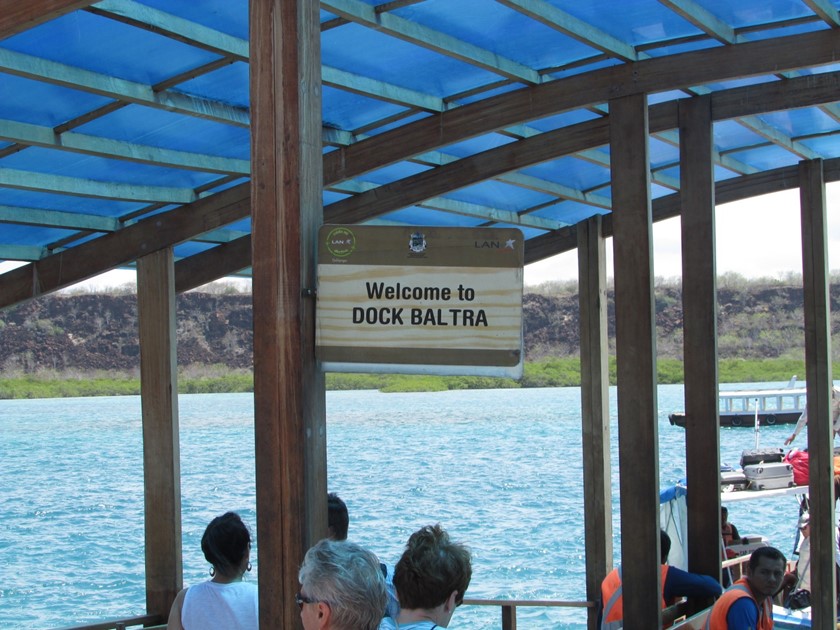
Our first stop was to the Island of Santa Cruz.
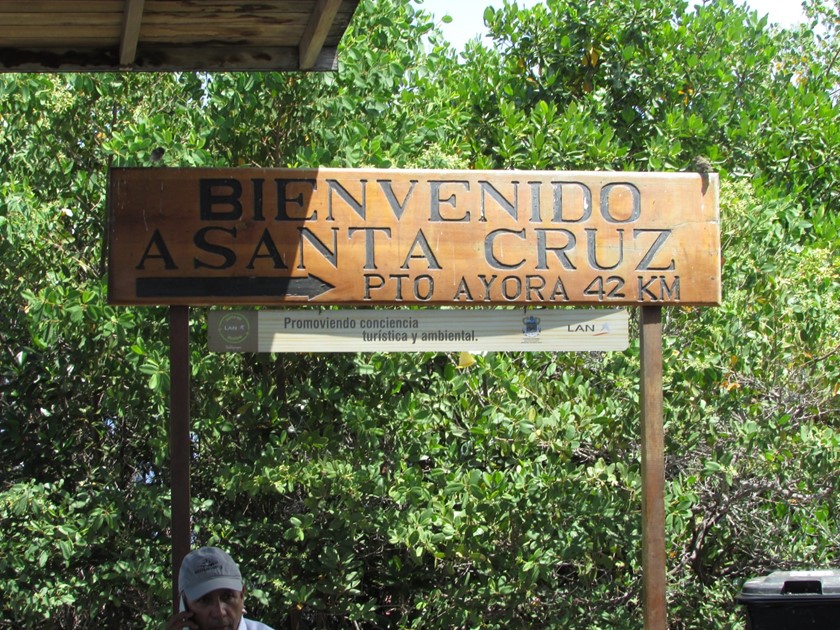
Here we boarded another bus. We noticed dramatic changes in the scenery. The airport at Baltra was surrounded by desert with little or no vegetation. On Santa Cruz, the vegetation changed significantly with altitude.
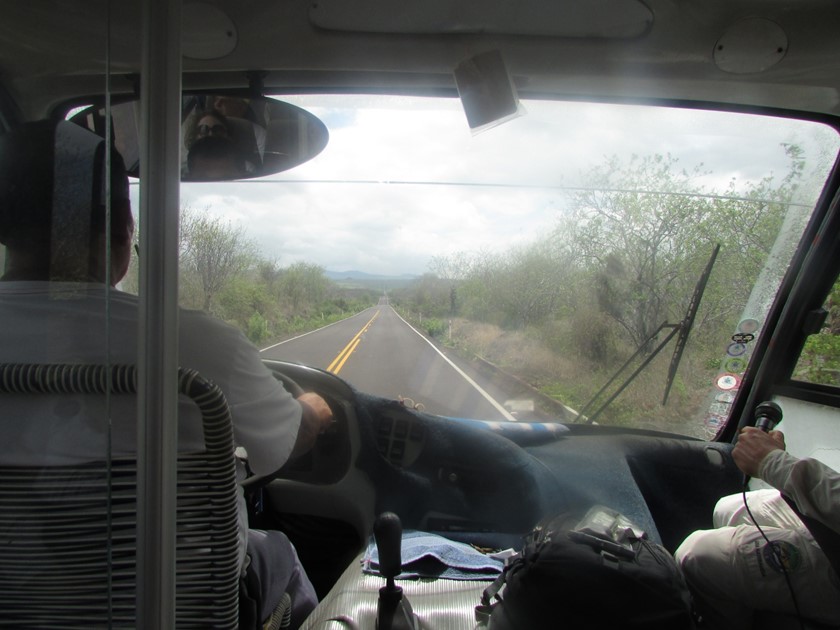
After about 45 minutes, we came to the viewing spot for giant turtles.
The famous turtle “Lonesome George” had died several years ago but there were certainly large land turtles on this island.
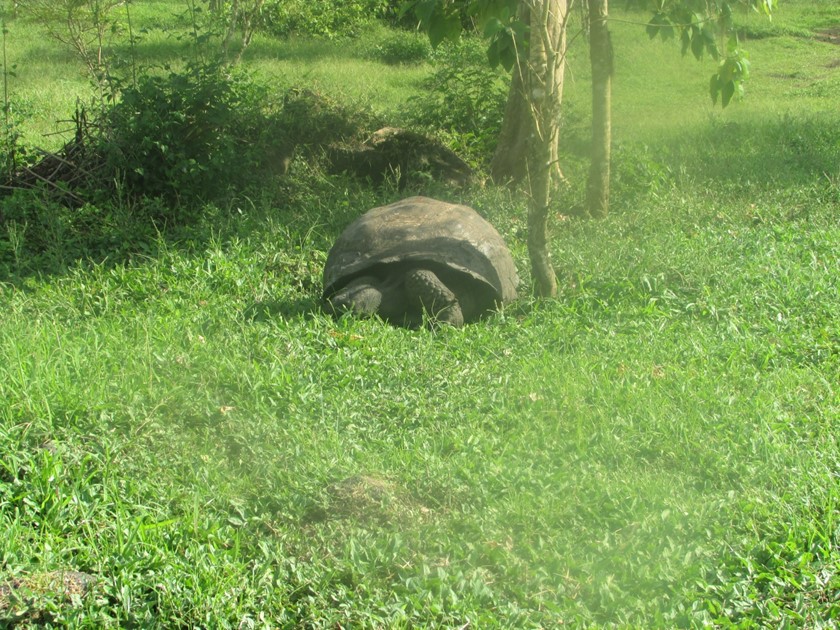
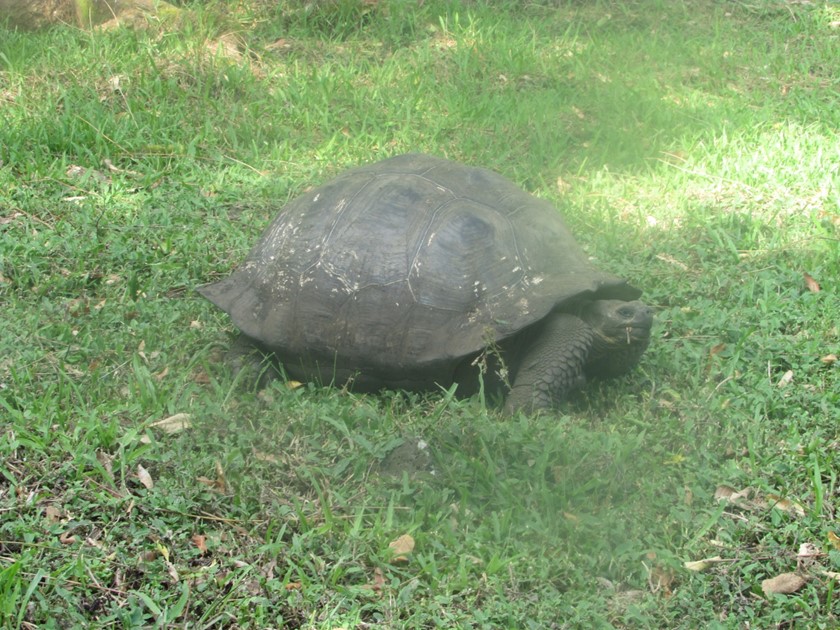
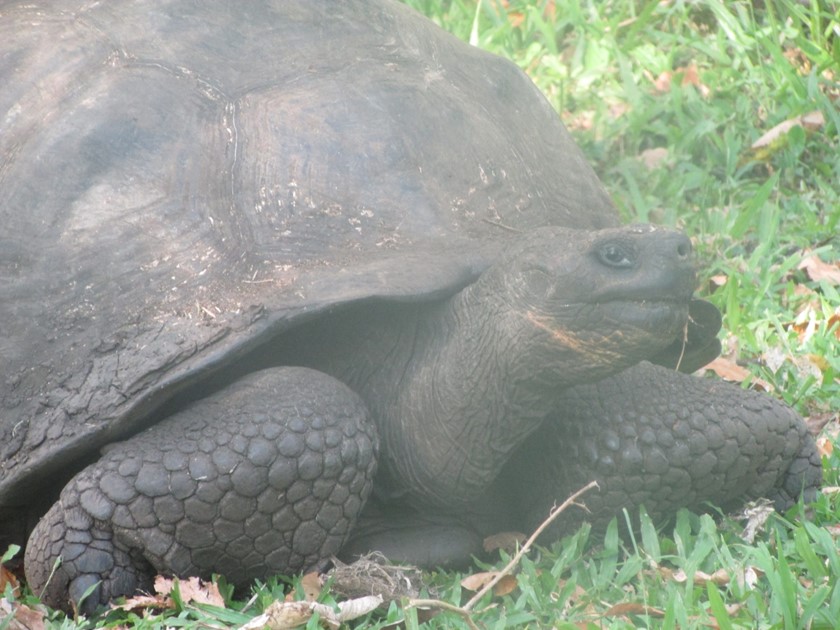
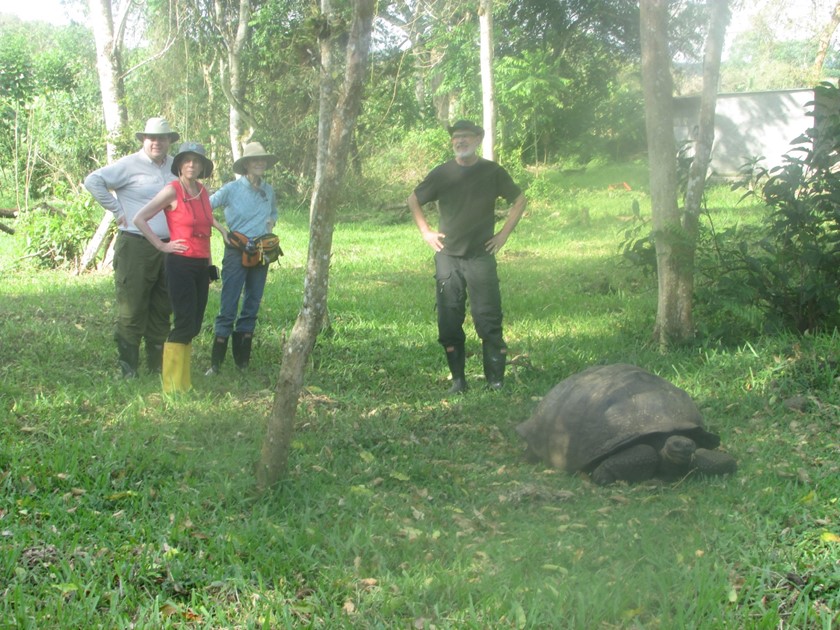
The visitor center had a poster showing the various species of turtle and their habitat.
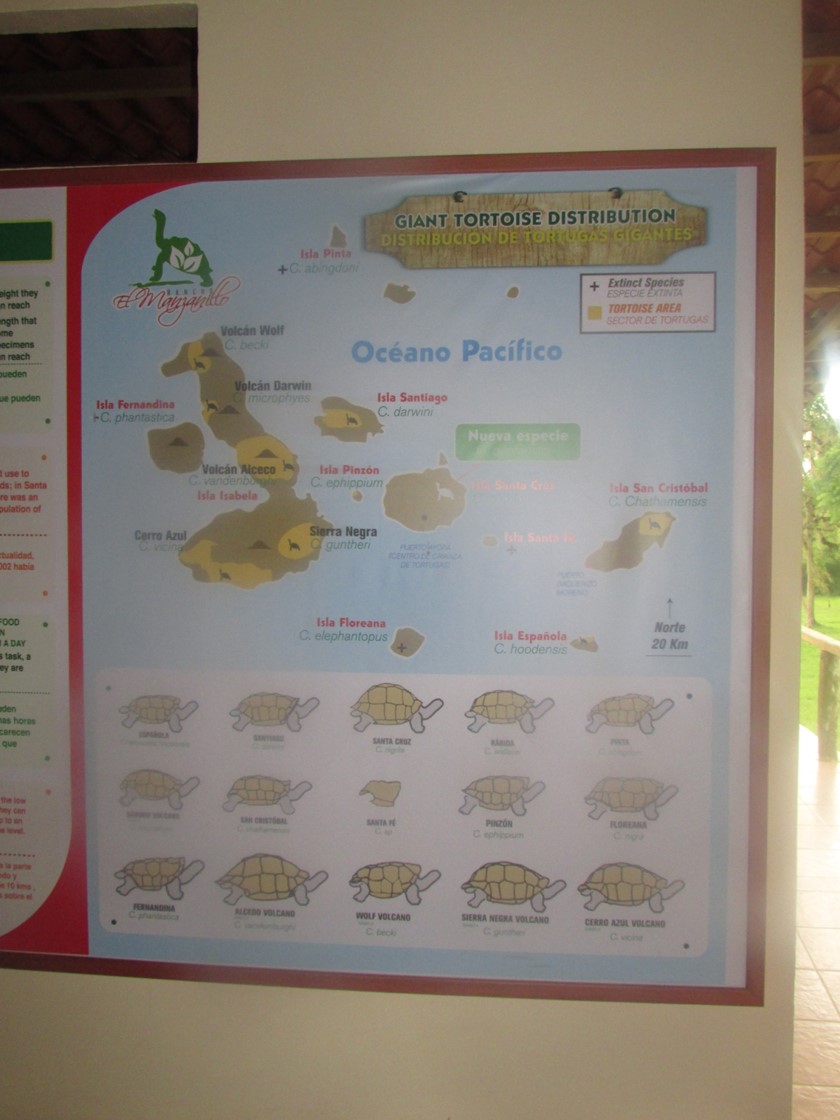 .
.
Darwin sailed to Galapagos on board the HMS Beagle in September 1835, when he was 26 years old. During the five weeks that he spent here, he went ashore to collect plants, rocks, insects and birds. He observed the unusual life forms and their adaptations to the harsh environment. He noted that it was possible to distinguish which island a tortoise came from by the shape of their shell. His most well-known research is of the numerous species of finches which inspired his groundbreaking theory The Origin of Species, published in 1859
Then we were bused back to the dock and boarded a small boat for our trip out to the ship La Pinta. This was to be our home for the next five days and four nights.
La Pinta has 12 cabins and sleeps 24. Our group of 13 was joined by another group on a similar vacation trip.
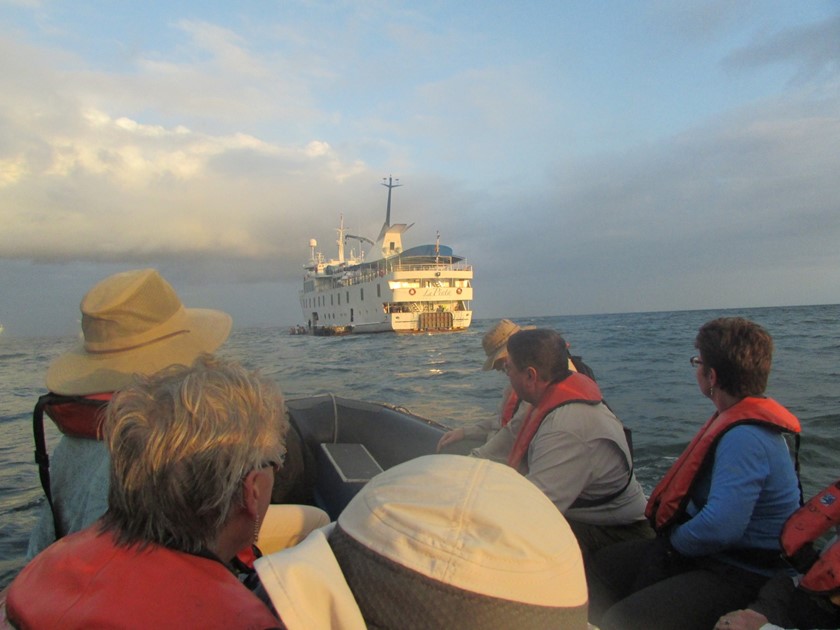
The meals on this ship were fantastic. We ate all of our meals aboard and were never disappointed.
There was an evening meeting to get us ready for the next day’s adventures. We enjoyed a glass of wine and were off to bed.
Tuesday, February 9, 2016
The ship moved among the islands during the night so we always woke up in a new place.
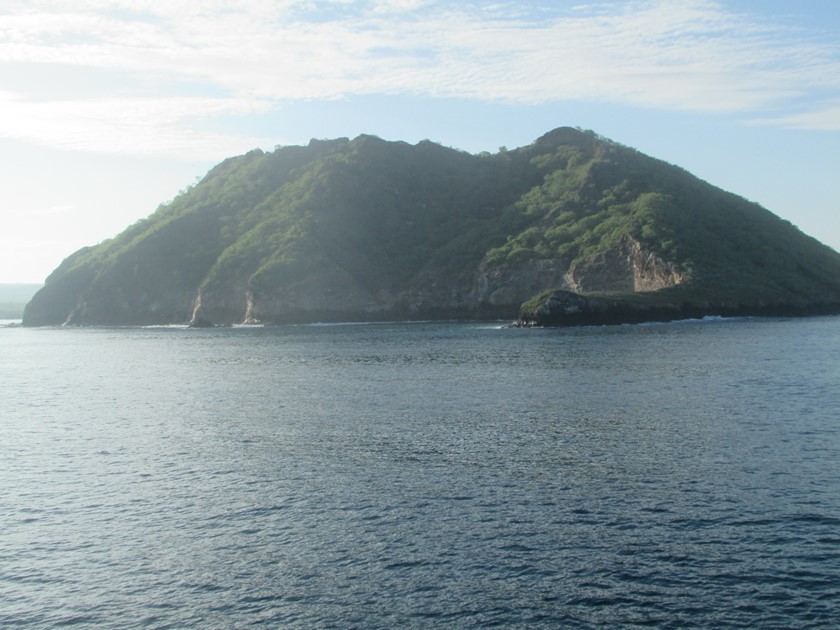
Lots of birds followed our ship and frequently perched on the antennas.
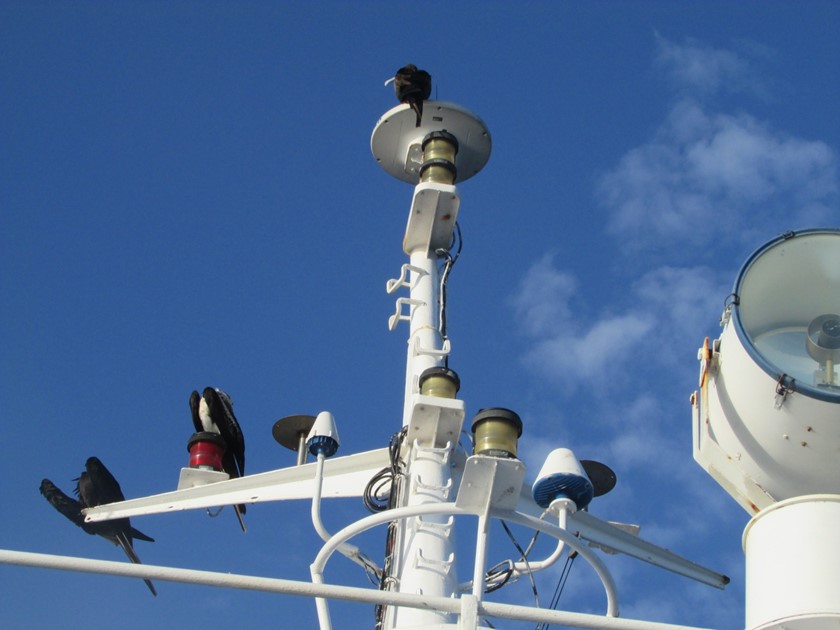
In order to visit the various islands, it was necessary to get into smaller “Panga” boats. This transfer to smaller boats and then to “wet” landings on sandy beaches was a serious concern of Pat’s with her broken shoulder. The ship’s staff, however, was made aware of the issue and was very helpful. This never became an issue.
So we boarded these little boats and went in close to the islands for an up close at the plants and animals of the Galapagos Islands.
There were Iguanas everywhere.
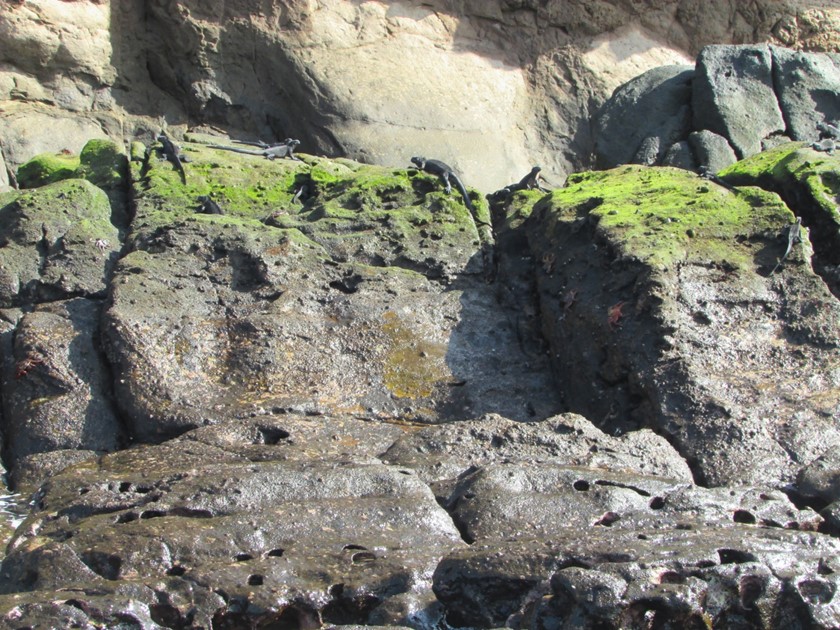
…and the notorious Blue-Footed Boobies.
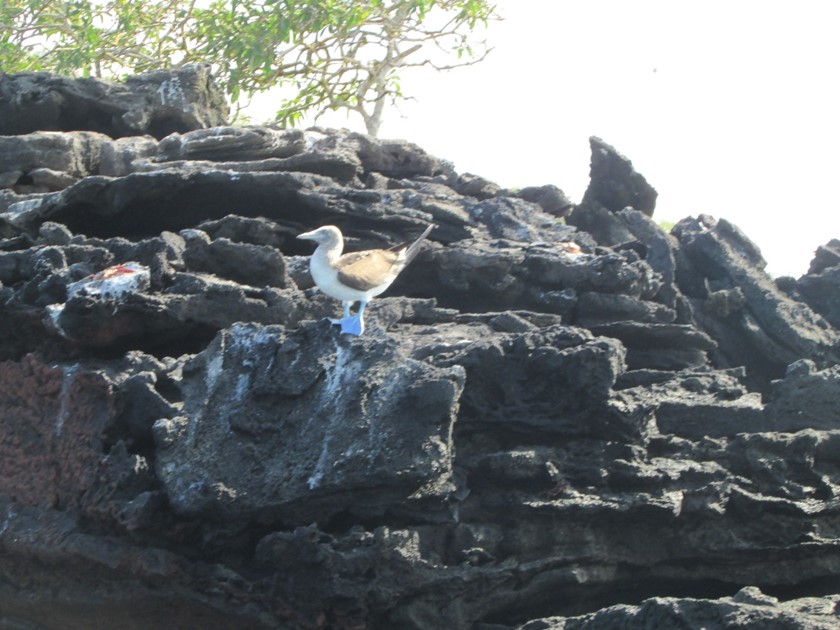
The feet are truly blue and stand out quite clearly.
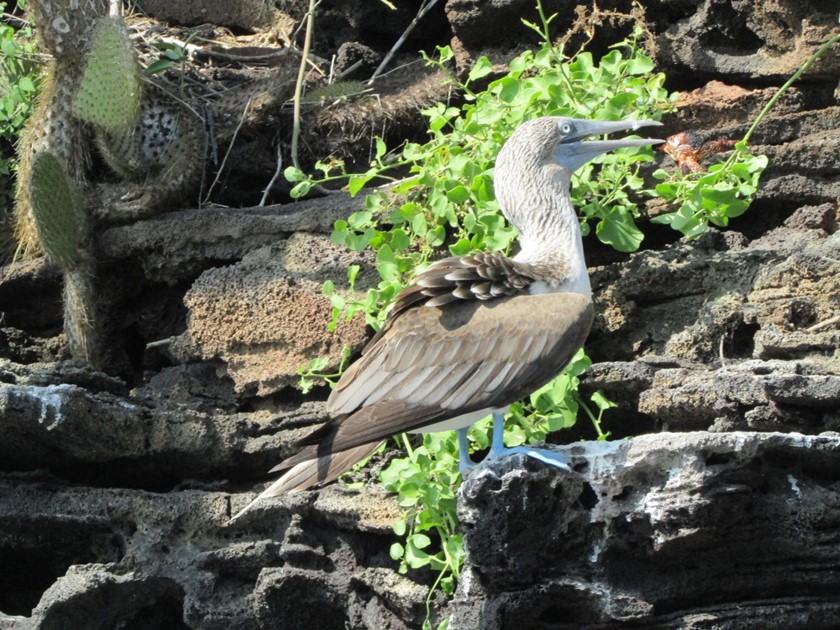
This guy was looking right at us.
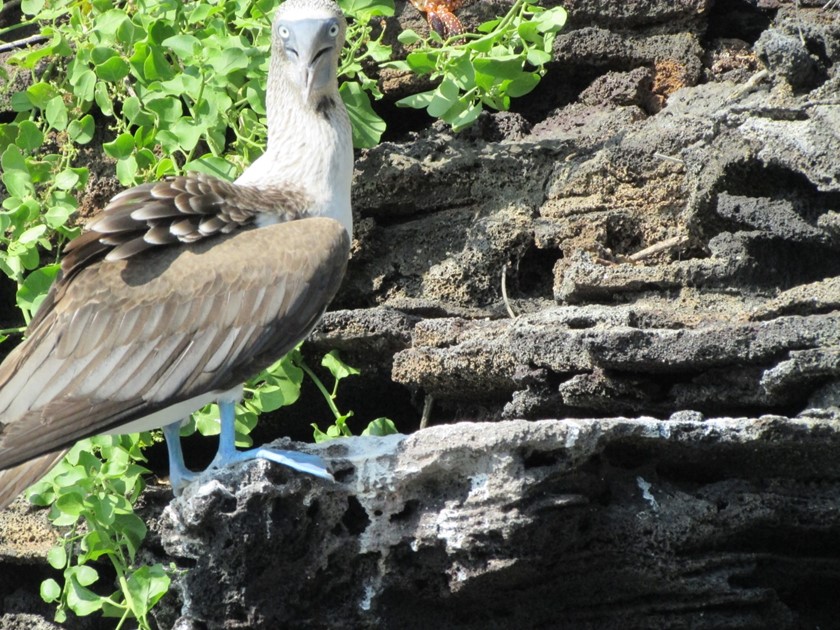
We saw these bright orange crabs all over.
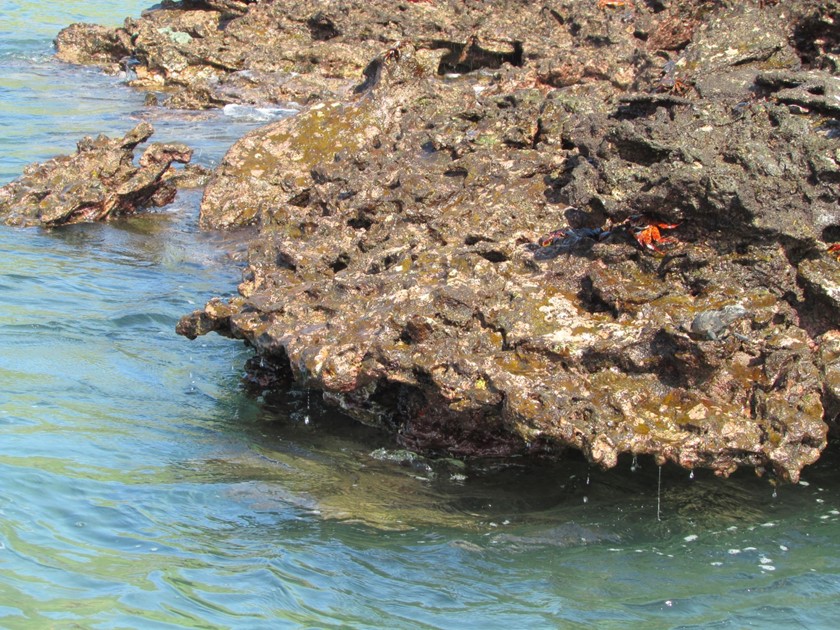
And there was the orange coral that seemed to give cover to the orange crabs.
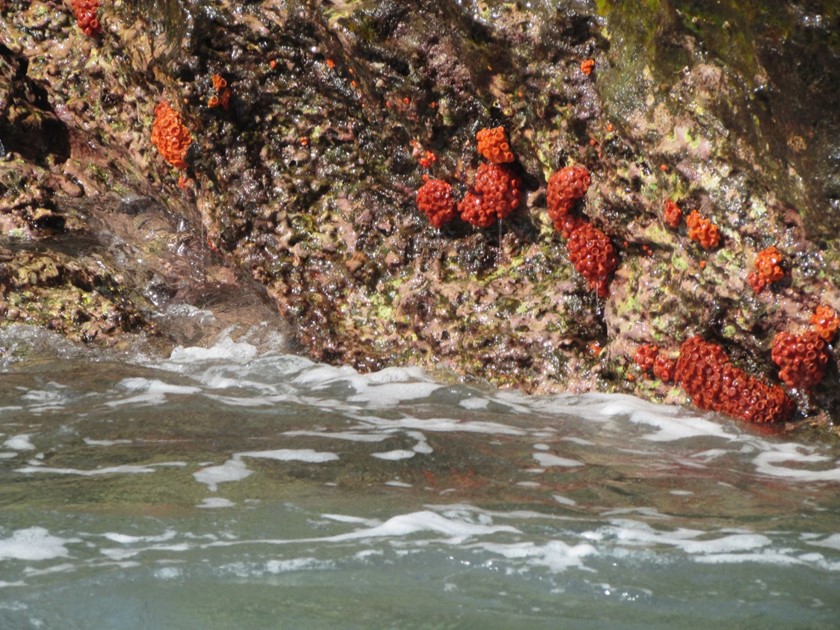
We also saw many Pelicans fishing the local water.
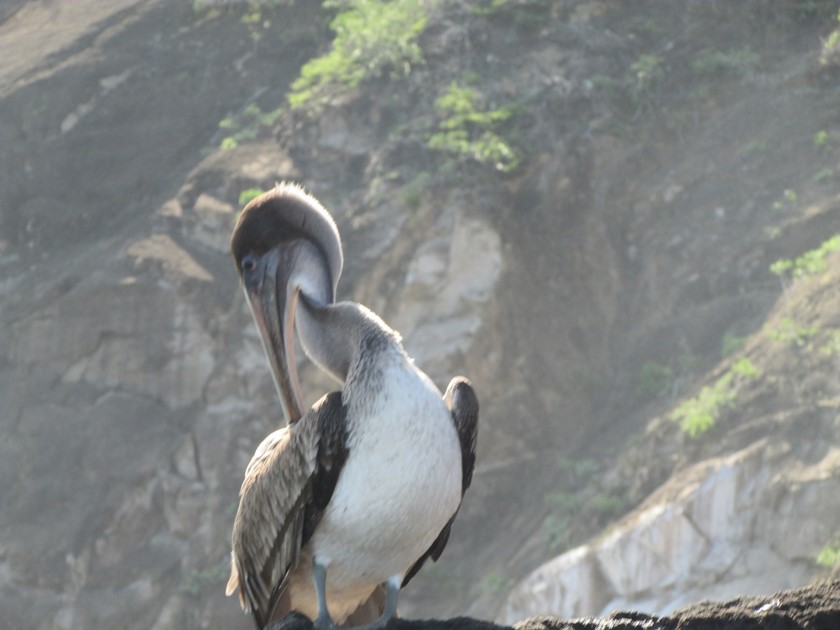
We went back to the ship for lunch and a brief rest.
Then it was back onto a Panga boat to visit another island. The Galapagos Islands are a series of volcanic islands that straddle either side of the Equator about 575 miles west of mainland Ecuador. They are part of Ecuadorian province and form a national park, and a biological marine reserve. They have a population of about 25,000.
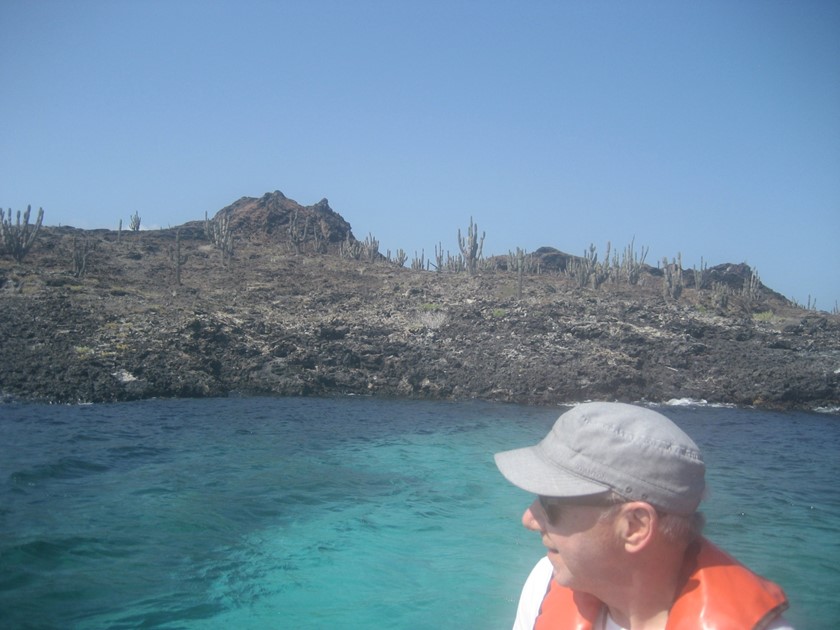
Some of the volcanic action took place relatively recently leaving little vegetation.
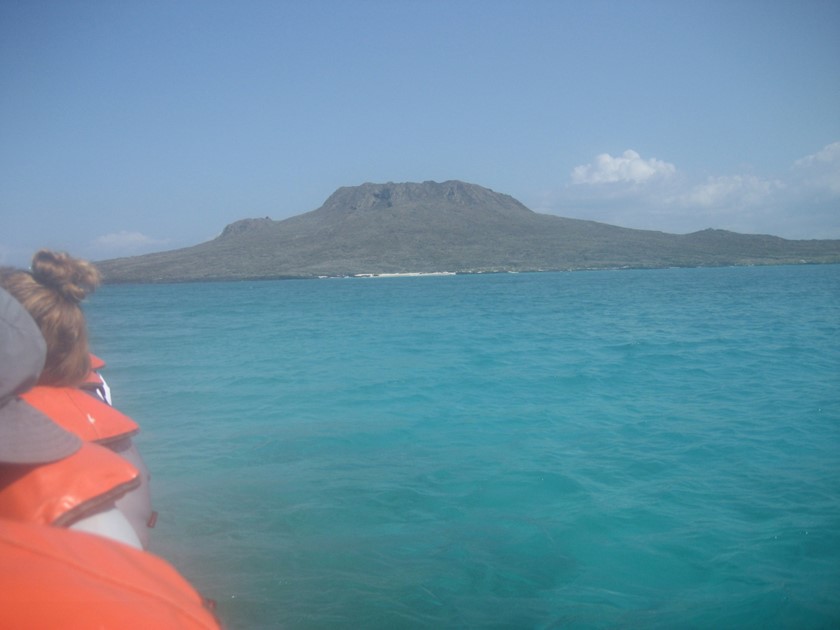
We went ashore on a white sandy beach using what is called a “wet landing”. The little boat runs aground on the beach and everybody jumps over the side. Pat managed this maneuver repeatedly with no incident.
Once on shore, the naturalist gave us a walking tour. We spotted baby Sea Lions basking in the sun and totally ignoring us visitors.
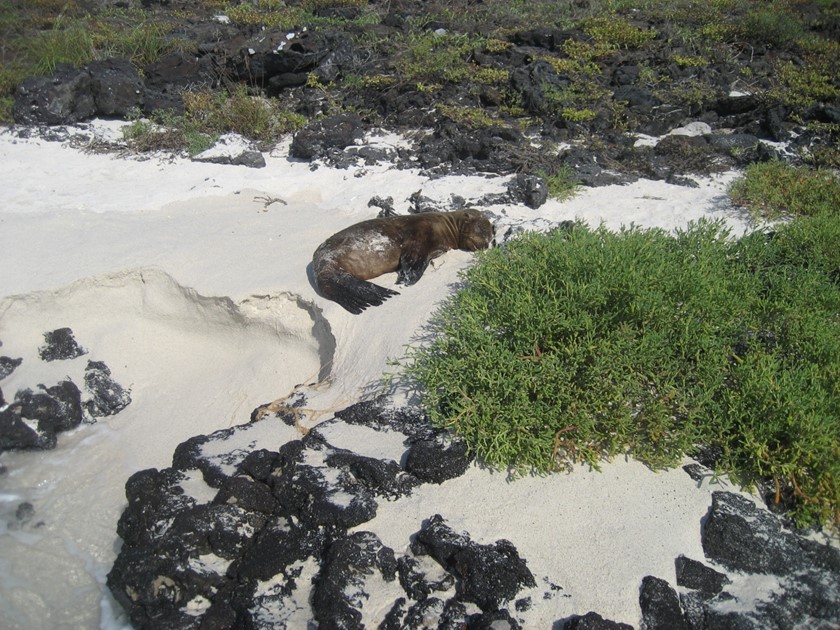
We also saw a former Sea Lion…
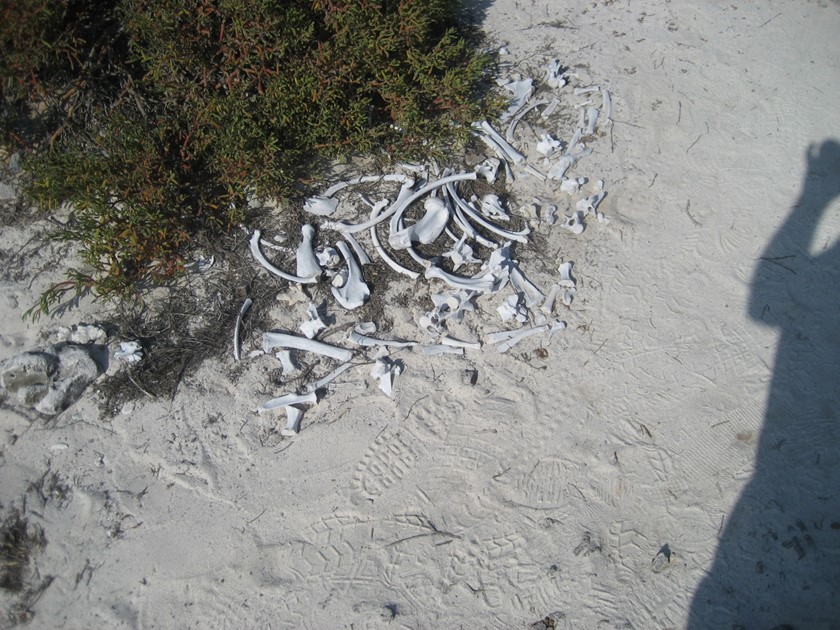
We walked around and swam for about an hour before returning to the La Pinta for the evening.
Wednesday, February 10, 2016
Overnight the ship had moved to Bartolome Island noted for dramatic geological formations including Pinnacle Rock.
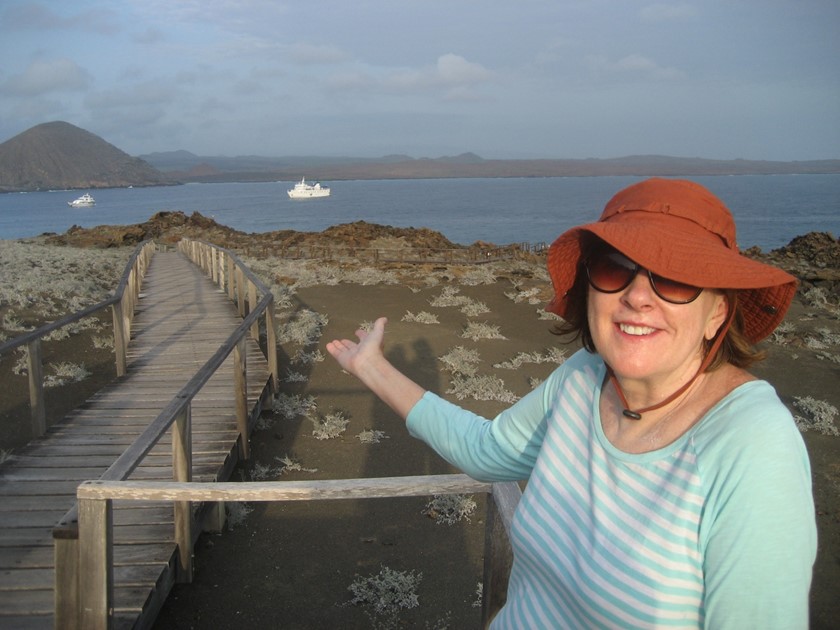
In spite of the dry lava rock, an occasional cactus could be seen.
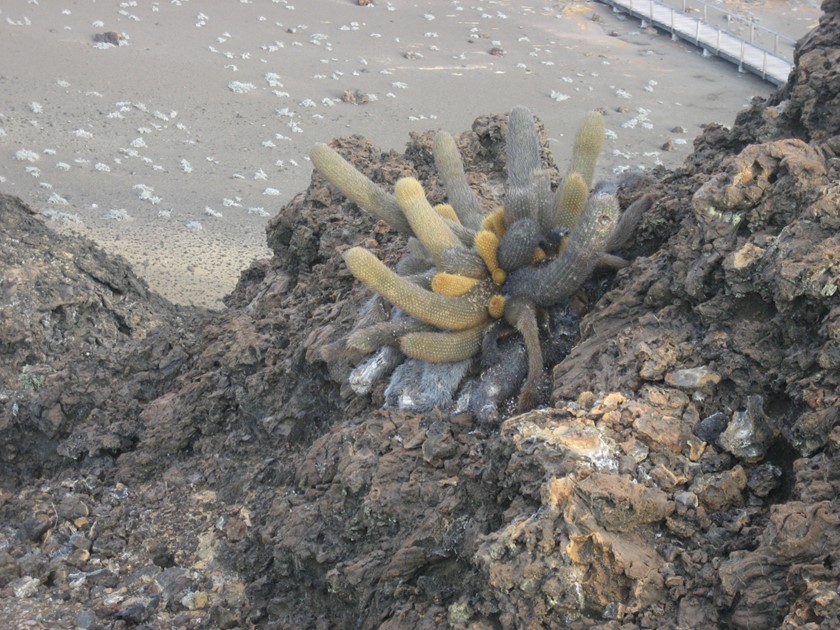
Our naturalist guide was quite fluent in English and was a great source of information about the region.
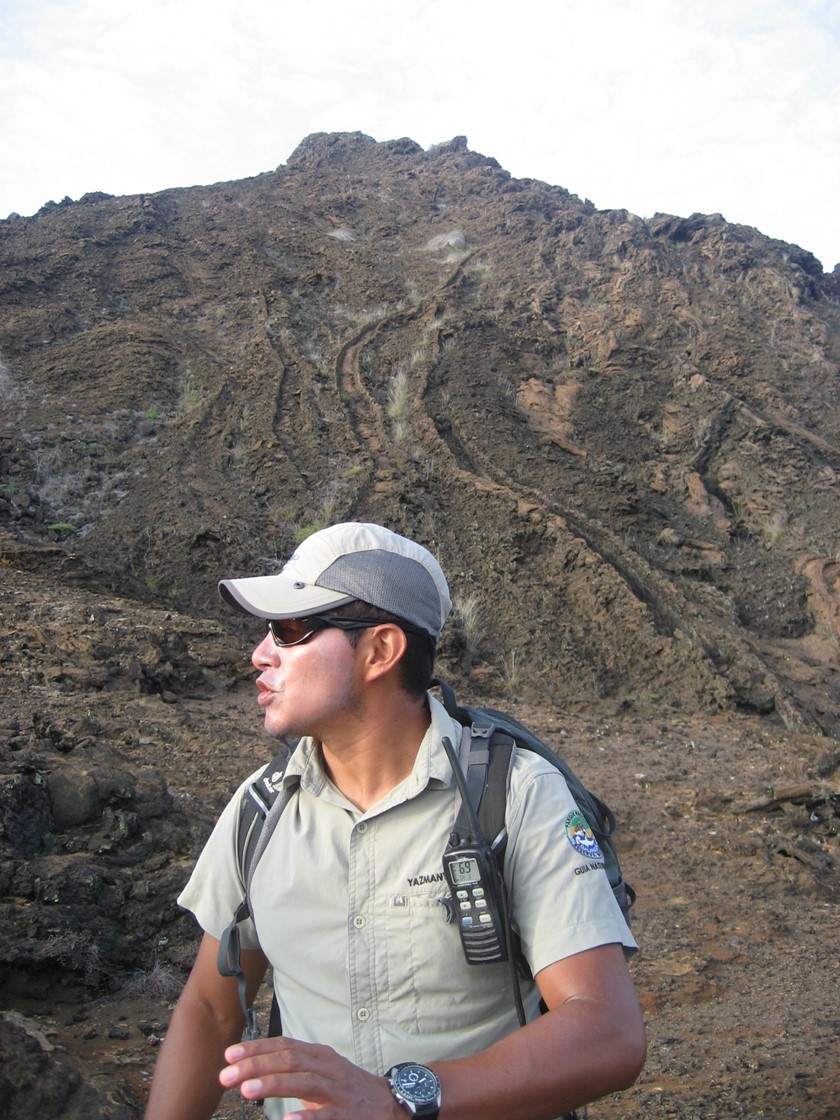
On the way up we were able to watch two female Lava Lizards having a wrestling match. One eventually grabbed the other by the throat and flipped her on her back. We thought it was all over.
After a few seconds, however, they were both up and chasing each other again.
We hiked to the top of Pinnacle Rock. Down by the water, you can see the start of the wooden walkway that we climbed to get here.
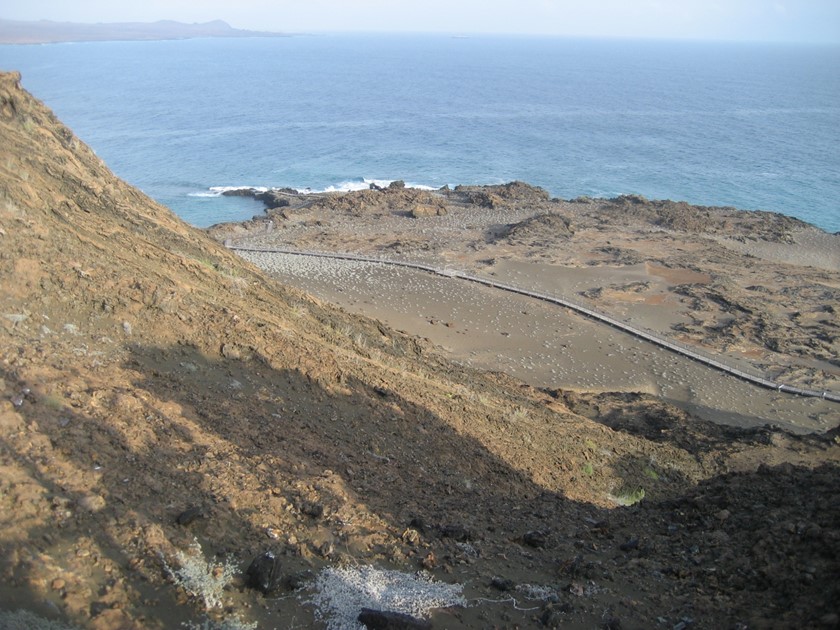
Notice Pat is not even wearing the sling on her left arm.
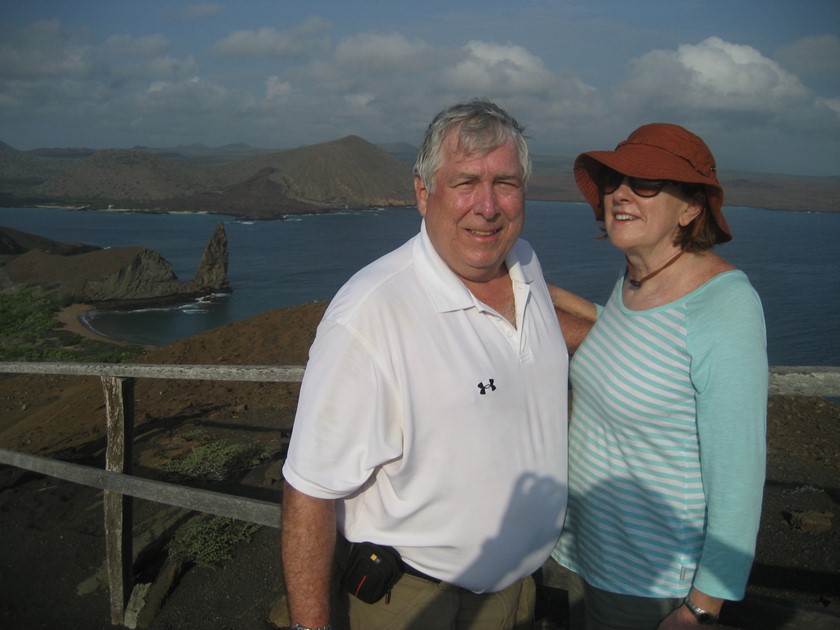
We walked back down and climbed back into our Panga boat for a tour around the island.
We watch two baby Sea Lions, one basking in the sun and the other swimming near shore.
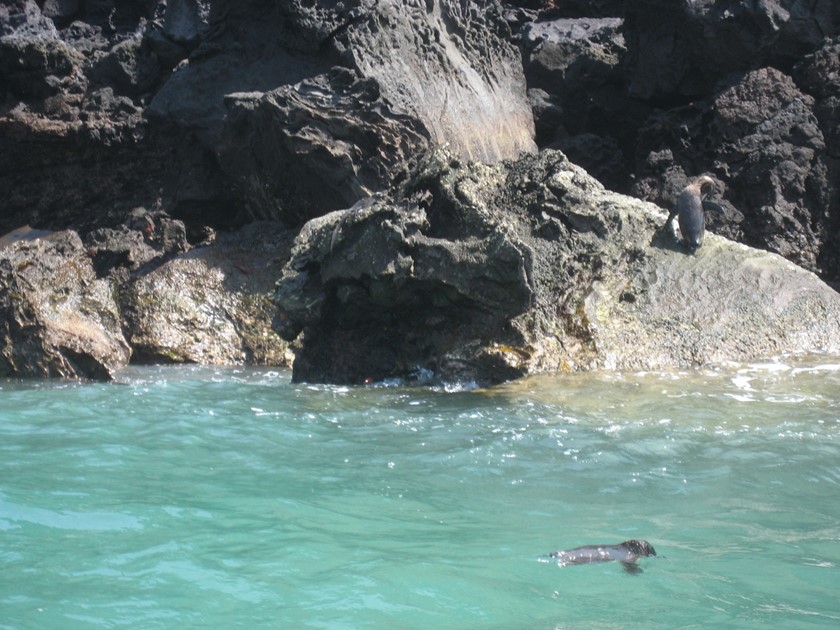
We even saw a Penguin close by to an Iguana (on the left).
The Galápagos penguin (Spheniscus mendiculus) is the only penguin that lives north of the equator in the wild. It can survive due to the cool temperatures resulting from the Humboldt Current and cool waters from great depths brought up by the Cromwell Current. The Galápagos penguin is one of the banded penguins, the other species of which live mostly on the coasts of Africa and mainland South America. It is the second smallest species of penguin. They have a black head with a white border running from behind the eye, around the black ear-coverts and chin, to join on the throat. They have black-grey upperparts and whitish under parts, with two black bands across the breast, the lower band extending down the flanks to the thigh.
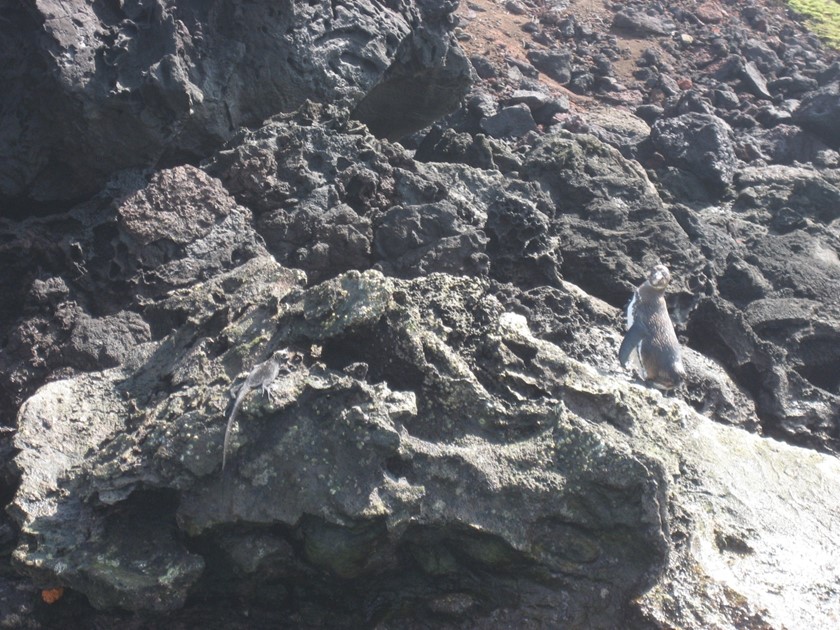
On the way back to the ship, our Panga pulled up to a stop in the middle of the ocean. Our guide pointed out two huge turtles in open water having sex. The male was on top and the female would periodically extend her neck skyward to catch a breath.
Then it was back to the ship for cocktails and dinner.
Thursday, February 11, 2016
This morning we got to explore Darwin Bay. We did another ‘wet landing’ and had a guided tour of the island. One of the first things we saw here were Red-Footed Boobies.
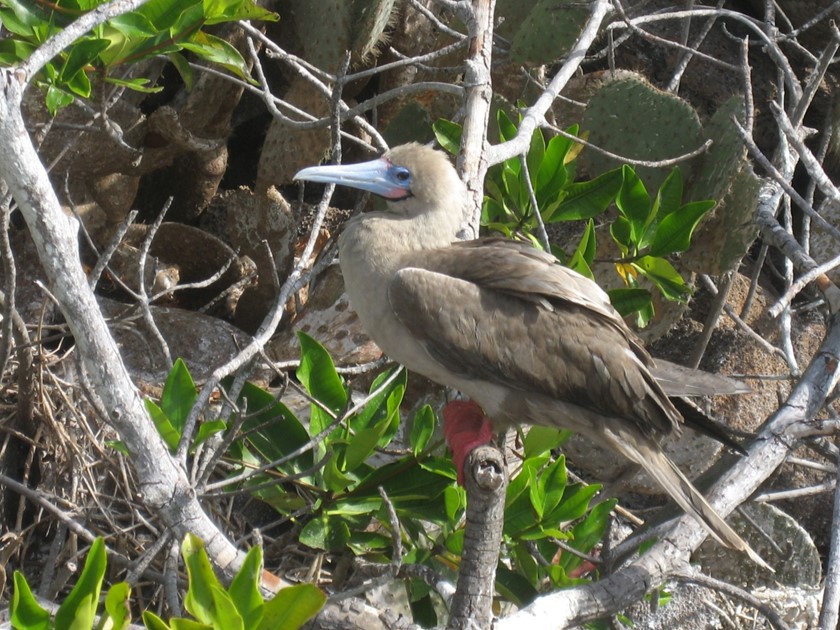
None of these birds showed any fear of humans. We could walk right up to them.
Below is a baby Red-Footed Boobie chick. We were told that they sleep with their head down and their backend up to catch the breeze and keep themselves cool.
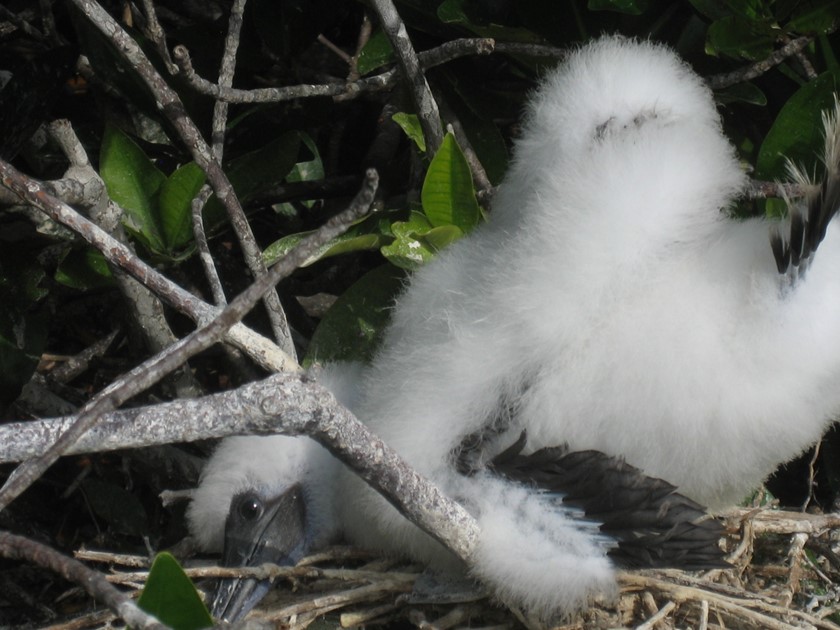
They are so cute!
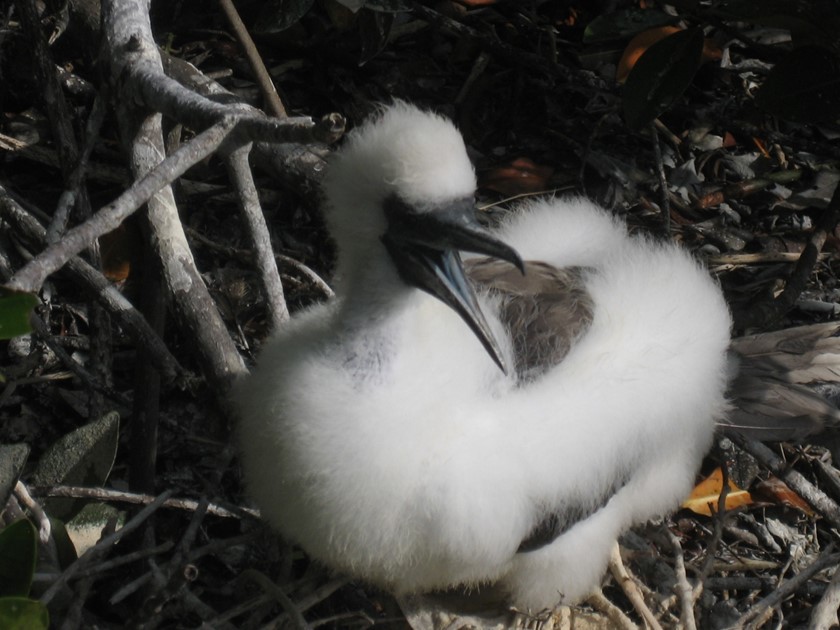
Notice the very green vegetation in the background. Although volcanic, any activity on this island happened hundreds of years ago.
There were also these Cormorants that puff up their bright red throat to attract females.
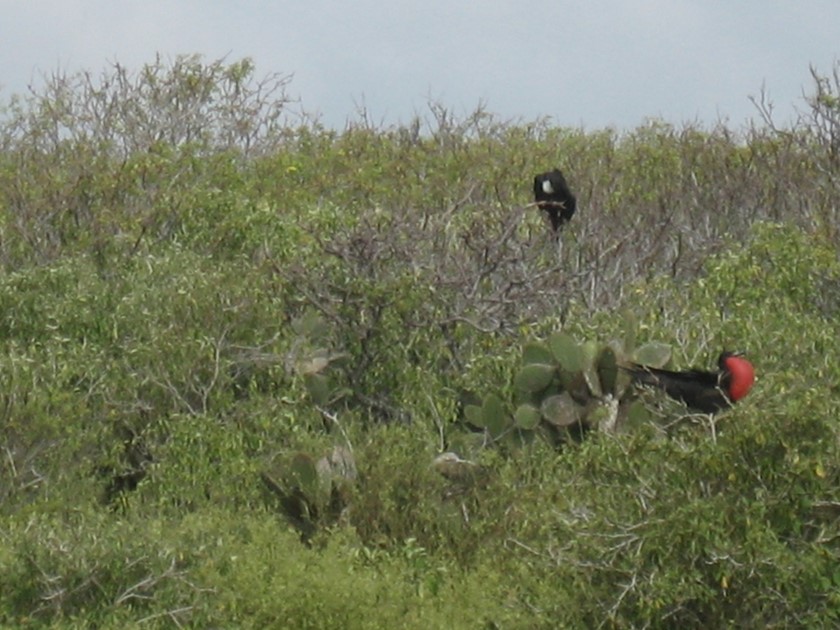
We watched a grumpy old Sea Lion get awoken by a hungry pup. You can barely see the pup behind the Male who was awake and growling.
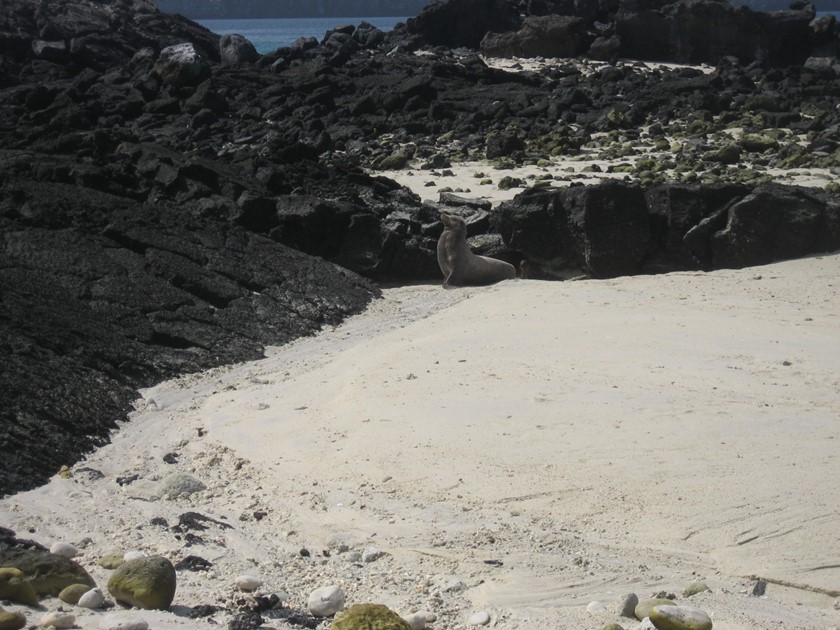
Even with her broken shoulder and healing stitches, Pat could no longer resist the temptation to get into the water and swim a little.
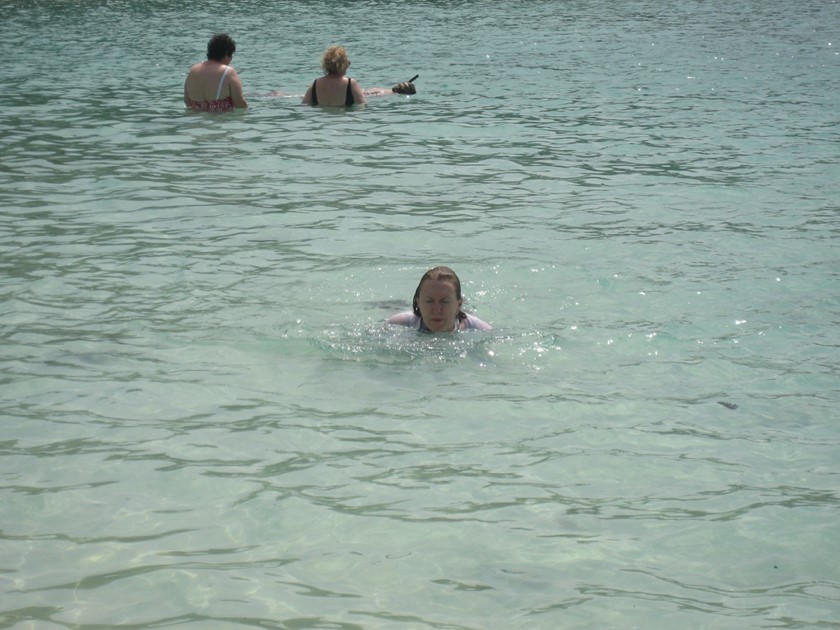
This was the last full day visiting the Islands.
We returned to the ship for cocktails and dinner. Only tonight, we also had to pack and get ready to travel again tomorrow.
Friday, February 12, 2016
Today the ship took us back to Baltras. Smaller boats took us to the dock. A bus took us to the airport. From there we boarded a plane again with a stop in Guayaquil. Here, nine of our fellow travelers got off with other travel arrangements. Pat and I and one other couple continued on to Quito.
From the airport, we were taken by a small van to the Casa d’ Campo Tababela hotel. While this hotel is near the airport, it is about 45 minutes from the center of Quito.
We enjoyed dinner at the hotel and called it a night.
Saturday, February 13, 2016
We had a loooong day to spend in Quito. Our flight back home was scheduled to depart at 12:50 AM Sunday morning.
Following a late breakfast, we packed our bags, left them with the front desk, and took a taxi into the city.
Quito has a double-decker tourist .bus that runs every hour and takes about 2 hours to complete its route. Passengers can hop on and off at specific stops around the city. We bought a ticket and headed off.
Our first stop was the Botanical Garden.
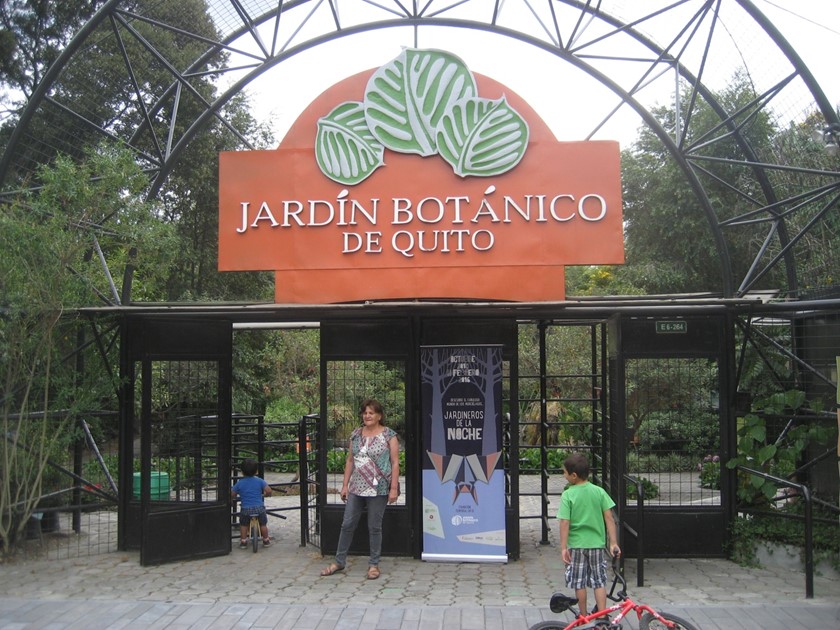
Back on the bus, we toured the city. At 9,350 feet elevation, Quito is the highest capital city in the world. The streets are narrow and steep.
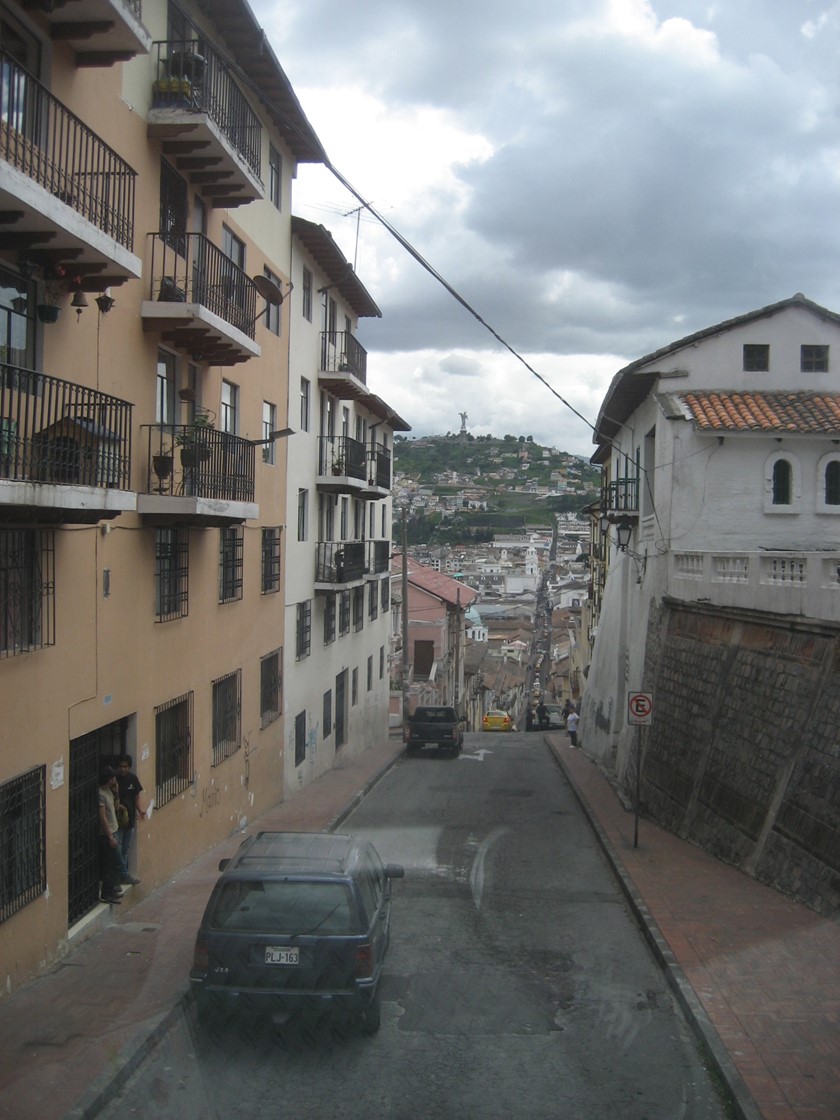
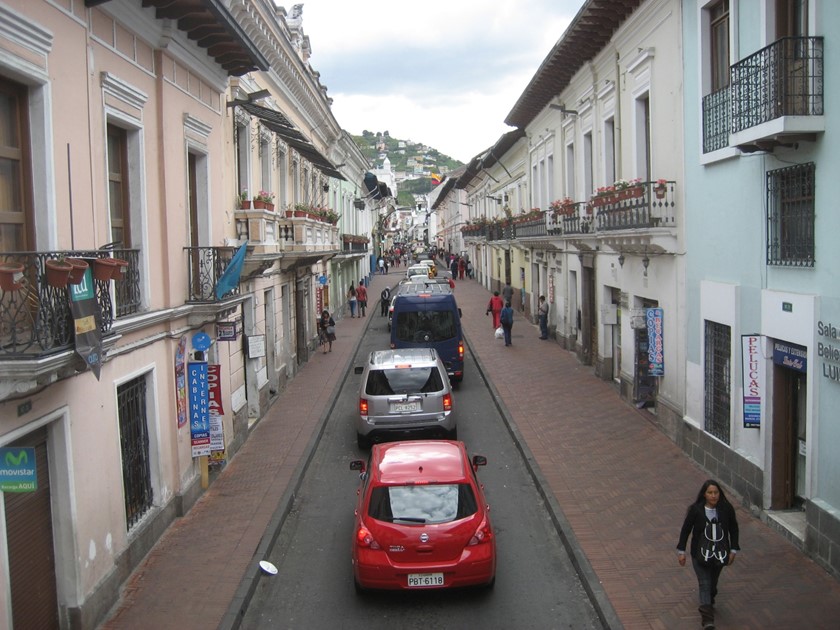
We enjoyed lunch in the old section of town. During our lunch, the skies opened up and the rains poured.
Fortunately, by the time we finished lunch, the rain stopped and the sun returned.
We made our way back our hotel by evening and filled our time watching television and playing pool.
At about 9:00 the van came to take us to the airport where we were to kill time until our flight departed. The ticket counter didn’t open until about 10:30 at which time we could clear security and get to the club room to await our flight.
Our flight was delayed by an hour which is really inconvenient at 1:00 in the morning. We did depart, however, and in time to land in Houston and make our connection to Chicago.
All in all, a most memorable trip.

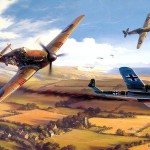
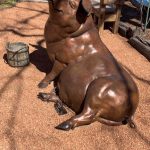
Vaughn-would you recommend your tour group? Your trip sounds great, and we’d like to know the name of the company.